|
EARLY DAYS OF
COASTAL GEORGIA
Photographs by
ORRIN SAGE WIGTHMAN
M.D., F.R.P.S., HON. P.S.A.
Story by
MARGARET DAVIS
CATE
Author of “Our Todays and Yesterdays”
Fort
Frederica Association, Publisher
St. Simons Island, Georgia
University of Georgia Press, Distributor
[Photos
colorized by Amy Lyn Hedrick using MyHeritage.com's
colorization tool]
Pg. 1
You may wonder why a collection of
pictures was made of Coastal Georgia scenes. It happened this way.
About 1936,
Margaret Davis Cate and I decided
that, as many of the historic landmarks were fast disappearing, it
was more or less a duty for her, as a historian, and for me, as a
photographer, to take this opportunity of preserving them for
posterity.
The tabby houses of two hundred years ago were falling
to pieces. The slave cabins were disintegrating, roofs had fallen
in, doorways were gone. But the land remained and in the cemeteries
we found the history of the early settlers. Also, we were able to
reach the home life of the Negroes, seeing them on the little plots
of land they owned and in their native environment—unspoiled and
natural. They were a lovable people, earnest, honest, and perfectly
happy in their surroundings. We have tried to preserve in
photographs and sketches the charm of these people, who are direct
descendants of the slaves of early times and retain the
characteristics of their forebears. They all tell a story—one which
we do not want to lose.
Mrs. Cate, who is familiar with the life and
character of the southern Negro, has been able to capture the spirit
of the times as no other person could possibly do it, as she had not
only the friendship but the confidence of these people.
We hope this book will fulfill the object for which it
was assembled.
ORRIN SAGE WIGHTMAN, M.D., F.R.P.S.,
HON. P.S.A.
Pg. 2
Dr. Wightman’s wonderful
pictures record for us visible evidence of our Coastal Culture. The
Military Era and the Plantation Era belong to history. Each had its
story and each produced its heroes. Oglethorpe and the
soldiers of Bloody Marsh will never be forgotten as they give life
and color to the Military Era. Neither should we forget the
Plantation Era which produced a Corbin and a Neptune.
Gone are the tabby walls and the way of life lived within these
walls.
In writing these stories to interpret
Dr. Wightman’s
pictures, all the knowledge gained in a lifetime of research was
used. For the scores for persons who have assisted in this study
throughout these years grateful appreciation is expressed.
However, especial acknowledgment is due to
Miss A.
Jane Macon; Miss Catherine Clark; Miss Ophelia Dent; Mrs.
Ruby Wilson Berrie: Miss Mary L. Ross; Mr. Richard A. Everett; Mrs.
Maude G. Lambright; Mrs. Mary Givens Bryan, Director of the
Georgia Department of Archives; Mrs. Lilla M. Hawes, Director
of the Georgia Historical Society; and to the Manuscripts Divisions
of the Libraries of the University of Georgia and Duke University,
and the Southern Historical Collection of the University of North
Carolina.
Pg. 3
This book is dedicated
by the authors to
ALFRED WILLIAM JONES
in appreciation of his work
in preserving the history
and traditions of the
EARLY DAYS OF COASTAL GEORGIA
Pg. 5
| Charles Wilson |
159 |
| Charles Wilson & his pipe |
161 |
| Charles Wilson & his horseshoe |
163 |
| Mary Williams |
165 |
| Reverend Elijah J. Rozzell* |
167 |
| Dan Hopkins |
169 |
| Rufus McDonald |
171 |
| Ella Pinkney |
173 |
| Ella Pinkney’s Front Porch |
175 |
| Salem Baptist Church |
177 |
| Charles Alexander |
179 |
| Charles Alexander’s Mill |
181 |
| Charles Alexander’s ox cart |
183 |
| Tyrah Wilson |
185 |
| Morris Polite |
187 |
| London Polite |
189 |
| Jerry Harris |
191 |
| Jerry Harris’ back porch |
193 |
| Sibby Kelly |
195 |
| Bell Tower of Petersville Baptist
Church |
197 |
| Liverpool Hazzard |
199 |
| Liverpool’s ox cart |
201 |
| Liverpool’s ox cart and trough |
203 |
| Old Jane |
205 |
| Negro Graves |
207 |
| Jackie Coogan |
209 |
| A piggy bank |
211 |
| Superman |
213 |
| Dolls' Head |
215 |
| Bowens' Family Burial Plot |
217 |
| The grave of Rachel Bowen-Pap |
221 |
| The grave of Reverend Aaron Bowens |
223 |
| The Historical background of St. Simons
Island |
224 |
*Original book made a typo in the page number
Pg. 6

Pg. 7
Contents
| Fort Frederica, St. Simons
Island, Georgia |
11 |
| Fort Frederica in the War of
Jenkins’ Earl |
13 |
| Old Frederica Cannon |
15 |
| The Barracks Building |
17 |
| The Town Moat |
19 |
| Foundations of Frederica’s Old
Houses |
21 |
| Hawkins-Davison Houses |
23 |
| Tabby |
25 |
| Fort St. Simons |
27 |
| Marker on Military Road |
29 |
| Military Road Near Bloody Marsh |
31 |
| Bloody Marsh Monument |
33 |
| Oglethorpe’s Home |
35 |
| Frederica’s Oaks |
37 |
| Frederica’s Old Burying Ground |
39 |
| Christ Church, Frederica |
41 |
| Couper Tombstones, Christ Church
Cemetery |
43 |
| Armstrong Tomb, Christ Church
Cemetery |
45 |
| Hazzard Vault, Christ Church
Cemetery |
47 |
| John Wylly’s Tombstone |
49 |
| Pink Chapel, West Point
Plantation |
51 |
| Slave Cabin, West Point
Plantation |
53 |
| Date Palm at Cannon’s Point |
55 |
| Ruins of the Kitchen, Cannon’s
Point Plantation |
57 |
| Slave Cabin, Butler Point |
59 |
| Hampton River at Butler Point |
61 |
| Mackintosh Vaults |
63 |
| Slave Cabins of Hamilton
Plantation |
65 |
| Ebo Landing |
67 |
| Ruins of Retreat Plantation
House |
69 |
| Retreat Avenue |
71 |
| Retreat Avenue and Baldwin’s
Ditch |
73 |
| Retreat Hospital |
75 |
| Sea Island Golf Club House |
77 |
| Slave Cabin of Retreat
Plantation |
79 |
|
Pg. 8
Contents
| Floyd White |
81 |
| Frizzle Chicken |
83 |
| St. Simons Lighthouse |
85 |
| Lanier’s Oak |
87 |
| The Marshes of Glynn |
89 |
| Lanier’s Marshes |
91 |
| Lovers’ Oak |
93 |
| Capt. Mark Carr, Brunswick’s
First Settler |
95 |
| Oglethorpe Hotel, Brunswick |
97 |
| Mahoney House |
99 |
| Jekyll Island Club |
101 |
| Orange Hall, St. Marys, Georgia |
103 |
| Residence of Major Archibald
Clark, St. Marys, Georgia |
105 |
| St. Marys Presbyterian Church |
107 |
| Oak Grove Cemetery, St. Marys,
Georgia |
109 |
| The French at St. Marys |
111 |
| Hofwyl Plantation |
113 |
| Altama |
115 |
| Old Rice Mill on Butler Island |
117 |
| Rice Mill Chimney on Butler
Island |
119 |
| Rice Field Canal |
121 |
| Dido, a Rice Field Worker |
123 |
| Fort King George |
125 |
| The Highlanders of Darien |
127 |
|
Ashantilly |
129 |
| Downey Home, the Ridge, Darien |
131 |
| Midway Church |
133 |
| Midway Cemetery |
135 |
| Old Screven House at Sunbury |
137 |
| A Negro Home in Jewtown |
139 |
| Bacchus Magwood |
141 |
| Willis Proctor |
143 |
| Julia Armstrong |
145 |
| Joe Armstrong |
147 |
| Edith Murphy |
149 |
| The House that Neptune Built |
151 |
| Lavinia Abbott |
153 |
| Ben Sullivan |
155 |
| Charles Wilson, the Basket Maker |
157 |
|
Pg. 9
Blank
Pg. 10
Blank
Pg. 11
Fort Frederica, St. Simons Island,
Georgia
Built in 1736 by British settlers
under the direction of James Edward Oglethorpe, founder and
first Governor of Georgia, Fort Frederica was the most expensive
fortification built by the British in North America and became the
military headquarters of this Southern Frontier for Britain’s
Colonies in the New World against the Spaniards in Florida.
Oglethorpe named this place Frederica in honor of
Frederick, Prince of Wales, son of George II and
father of George III. Augusta was named in honor of the
Princess of Wales, while the naming of Cumberland Island and Amelia
Island honored William, Duke of Cumberland, and Amelia,
other children of the royal family.
Located on the western shore of St. Simons Island on
Frederica River, a part of the Inland Waterway which was the route
followed by coastwise vessels, this site was chosen by Oglethorpe
for his great fort because of its strategic position. Here the
river bends and turns so that an approaching vessel would be exposed
to the cannon of the fort without being able to return the fire.
Fort Frederica, a star-shaped work with four bastions
and walls of tabby faced with earth on the outside, was surrounded
by a moat, which was further protected by palisades. Oglethorpe
wrote that in the building of the fort he followed the plan of M.
Vauban, the great military engineer of France, whose work had
revolutionized the art of warfare.
Inside the fort there were several buildings of brick
and of tabby which were used as storehouses. The ruin of the
building shown here is “all that Time has spared” of these buildings
though tabby and brick foundations give evidence of the location of
others.
Another fortification, Fort St. Simons, was located at
the South End of St. Simons Island. A regiment of 650 British
soldiers, brought over in 1738, manned both of these fortifications
as well as the other forts and outposts in this area.
Fort Frederica was built for a purpose and it gloriously
achieved that purpose; its defenders turned back the tide of the
Spanish invaders and made this area secure for Britain.
Pg. 12

Pg. 13
Fort Frederica in the War of Jenkins’
Ear
The struggle between Spain and
England for control of this southeastern section of our country was
a part of the conflict which is generally known as the War of
Jenkins’ Ear. After the defeat of the Spaniards in the Invasion of
1742 and the termination of the war by the Treaty of Aix-la-Chapelle
in 1748, the regiment of British soldiers stationed here was
disbanded and Fort Frederica was abandoned.
As the houses fell into ruins, settlers from other parts
of St. Simons took away the bricks and pieces of tabby to use in
buildings they were erecting. The tabby walls of the Fort were
sawed into blocks and used in the first St. Simons Light House. As
time went on, this abandoned Frederica property came into the
possession of Capt. Charles Stevens, a native of Denmark, who
operated a coastwise sailing vessel on the Inland Waterway. Capt. Stevens built a home for his family on top of the building
shown here. Later, the Stevens family occupied a house
located a short distance east.
In 1903 the president of the Georgia Society, Colonial
Dames of America, was Mrs. Georgia Page King Wilder who had
been born at Retreat Plantation, St. Simons, and had known of Fort
Frederica and its history all her life. Through Mrs. Wilder’s
friendship with Mrs. Belle Stevens Taylor, who now owned this
land, Mrs. Taylor gave this building and a small piece of
ground surrounding it to the Georgia Society of the Colonial Dames
of America, who repaired the ruins and rebuilt this room shown in
the picture. The large pieces of tabby lying on the ground were
placed in their original position and the ceiling of the room
rebuilt with new brick. The other room located on the right still
has its original ceiling of old English brick brought from England
in 1736. So to the Georgia Society of the Colonial Dames of America
goes the honor of having saved this ruin from destruction.
Through the efforts of
Judge and Mrs. S. Price
Gilbert and Mr. Alfred W. Jones of Sea Island, the Fort
Frederica Association was organized in 1941 and funds were raised
for the purchase of the lands occupied by the old Fort and the Town
of Frederica. In 1947 this area was formally dedicated as Fort
Frederica National Monument.
Pg. 14

Pg. 15
Old Frederica Cannon
This old cannon is the only one of
the original Fort Frederica cannon still here. It is what was known
as a twelve-pounder, the size of the cannon being determined by the
weight of the cannon ball. When in use, this gun was mounted on a
wooden carriage so that it could be moved from place to place. It
is believed that it was never mounted on top of this building. When
the Colonial Dames acquired this ruin, the cannon was on the ground
near the southeast corner. In order to protect it more adequately
it was placed on top of the building.
In its day Fort Frederica had many cannon.
Oglethorpe’s first engineer at Fort Frederica was Samuel
Augspourger, a Swiss emigrant who had come to Purysburg, S.C.,
and from there to Georgia. Augspourger wrote that there were
fifty cannon at Frederica, some of them being eighteen-pounders.
His map made in 1736 (original manuscript in John Carter Brown
Library, Providence, R.I.) shows the “spur work” on the river where
the cannon…are on a level with the water’s edge, and make it
impossible for any boat or ship to come up or down the river without
being torn to pieces…” Other cannon were mounted on the bastions of
the fort and at the Point Battery located on the lower part of the
bluff.
Even after Fort Frederica was abandoned, a guard was
stationed here to protect the place and prevent the guns from being
taken away by pirates. In 1755 a dozen twelve-pounders that had
been mounted in the “spur work” were removed and carried to Cockspur
Island in the Savannah River where they were used to fortify Fort
George. During the Revolutionary War some of the Frederica cannon
were taken to Sunbury and used in fortifying Fort Morris, but this
one has been here at Frederica for more than two centuries.
Fort Frederica was so well situated that the Spaniards
never succeeded in attacking it, so its cannon were never fired
except on special occasions, one of which was the salute to Gen.
Oglethorpe when he returned from a voyage to England.
Pg. 16

Pg. 17
The Barracks Building
This barracks building, erected to
house the soldiers of Oglethorpe’s Regiment, was ninety feet
square, had a shingle roof, and was built in the form of a hollow
square with the rooms opening on a court yard. The only part of the
building which was two stories high was this tower on the north side
containing the entrance to the building.
In addition to the accommodations for the soldiers,
there were facilities for the hospitalization of the troops and
quarters for political prisoners.
One of the famous prisoners incarcerated here was
Christian Priber, who for some years lived among the Indians in
the upper part of South Carolina. There he attempted to set up a
communistic form of government, a Utopia which he called “Paradise,”
and designated himself as its Prime Minister.
In 1743 Prime Minster
Priber was captured by the
British, brought to Frederica, and incarcerated there. During his
imprisonment the magazine at the fort exploded. With bombs flying
through the air in every direction, the officer in charge threw open
the doors of the prison and told the occupants to flee for their
lives. When the danger had passed and the people returned to
Frederica, inquiry was made as to the whereabouts of Priber
whom no on had seen during the excitement. A search disclosed that
the Prime Minister of Paradise had not left his prison but had
stayed there taking refuge under a feather bed!
Charles H. Fairbanks, Archeologist of the
National Park Service, recently excavated the area covered by two
rooms of the barracks building. One of these was the kitchen in
which were found pieces of dishes, spoons, and other ware used by
the soldiers. A most interesting item was the brass name-plate from
the gun-stock of Capt. William Horton’s gun. Horton,
who came to Frederica with Oglethorpe I n1736, had a
plantation on Jekyll Island, and in time became an officer in Oglethorpe’s Regiment, going from lieutenant to major. When
Oglethorpe finally returned to England, Horton succeeded
to the command of the military forces in this area.
Pg. 18

Pg. 19
The Town Moat
Adjoining Fort Frederica on the
east lay the Town of Frederica, which was half a hexagon in shape
and contained eighty-four lots on which the Frederica settlers built
their homes.
After the outbreak of war with Spain in 1739,
Oglethorpe strengthened his defenses by fortifying the town. It
was enclosed within a moat two-thirds of a mile long which was
flooded by tidal water fro Frederica River, the moat touching the
river at either end. At the corners of the moat were bastions, on
each of which was a two-story tower capable of holding a hundred
men. Flanking the moat on either side were palisades while the
walls of the moat formed the ramparts of the town.
In the center of the east wall of the town was located
the Town Gate over which was a tower containing sentry boxes.
Leading from this tower was the bridge over the moat which gave
entrance to the Town of Frederica. This entrance on the east was
known as the “Landport,” while the western entrance located near the
river was called the “Waterport.”
Oglethorpe sometimes used the moat for target
practice. In 1743 when he was preparing to invade Florida, the
soldiers who were to make the invasion “…marched out of the Town,
and each Platoon fir’d at a Mark, before His Excellency for the
Prize of a Hat and Machet, to the Man who made the best Shot at an
hundred yards Distance, in the Fosse round the Fortifications. He
afterwards gave Beer to the Soldiers…”
During the centuries which have passed the moat was
abandoned, great trees of pine and live oak have grown up on its
banks. Today, their moss-draped forms present a peaceful scene
which is very different from that contemplated when the threat of
the Spanish Invasion brought about the construction of the moat.
Pg. 20

Pg. 21
Foundations of Frederica’s Old Houses
During the Military Era the old
Town of Frederica was a thriving settlement. Its streets were lined
with houses built of tabby, of brick, and of wood. Some were
substantial dwellings, two were log cabins, and some were described
as “huts.”
Here the settlers lived and conducted their businesses,
which included taverns, an apothecary shop, and several stores, in
one of which iron goods were sold. Among the trades and professions
represented were those of shoemaker, cordwainer, brazier,
husbandman, dyer, tallow candler, baker, tanner, coachmaker,
carpenter, bricklayer, woodcutter, blacksmith, millwright, miller,
pilot, accountant, surveyor, recorder, magistrate, tithingman,
constable, doctor, and officers of Oglethorpe’s Regiment.
After the Regiment was disbanded, Frederica became a
“dead town.” The shopkeepers and professional men who had depended
on the soldiers for their livelihood had no customers. Abandoned by
their owners, the houses fell into decay, the brick walls tumbled,
and the brick and tabby were hauled away to be used in buildings
erected on other parts of St. Simons and by a new generation of
settlers. New families came to live on the site of the old Town and
every trace of its buildings and streets was lost. Gone, also, were
the beautiful orange trees that had line Broad Street. It was only
in musty records that this old town lived.
Through old maps and the letters and records of these
first settlers it has been possible to locate the town lots and
streets, and through archeological excavations to prove that these
homes had existed. In 1952 this program was inaugurated under the
direction of Charles H. Fairbanks, Archeologist of the
National Park Service, who excavated lots #1 and #2 of the South
Ward.
The rooms in the foreground of this picture were in the
house on lot #1 which was the home of Dr. Thomas Hawkins, the
medical doctor for the Frederica community; later, the surgeon of Oglethorpe’s Regiment. To the left can be seen the walls of the
stairwell for the outside stairs which led to the Hawkins’
front door on the main floor. In the background can be seen the
brick of the floor in the Davison house located at lot #2.
Pg. 22

Pg. 23
Hawkins-Davison Houses
With all the lots in Frederica
available, it was decided to excavate these two houses first because
they were built with a common wall which lay along the line between
the lots. By locating this wall it would be possible to fix the
location of all the lots in the old town. These houses, built of
brick and three stories high, were among the best of the Frederica
houses. Lot #1 had been granted to Dr. Thomas Hawkins, who,
with his wife, Beata, accompanied the first settlers to
Frederica.
Lot #2 was granted to
Samuel Davison, who with
his wife, Susannah, and their year-old daughter, Susannah,
was also among the first settlers. Later, the Davisons had
two more children born here. Davison was a “chairman” and
was brought over at this time because, in addition to making
carriages, he “had been bred to making stocks for guns.” Although
Davison was a Presbyterian, John Wesley said he was
one of the best of his parishioners. He was a “good Samaritan” to
Charles Wesley, nursing him during a severe illness. Davison kept a tavern in his house but said he never suffered
“any disorderly meeting or late hours.” The floor shown in this
picture was in his kitchen; and, as it had been set in tabby mortar,
the bricks are still in place.
During the excavation of these buildings many
interesting artifacts were found that told of the way of life of
these people. In the Davison house were hundreds of pieces
of dishes, clay pipes, bottles, and other items to be expected in a
tavern. The excavations also showed that Davison had a
well-built house. The inside of this room was finished with a
“studding” on which were nailed laths to which plaster was applied.
The
Hawkins house, however, was of cheaper
constructions, the plaster being applied directly to the brick
walls. Also, the brick of the floor, set in sand, has been carried
off along with the brick of the walls. In this house were found
some fine pieces of porcelain with the gold decoration still intact;
also, bottles of many sorts—a snuff bottle, an ink bottle, medicine
bottles, ointment jars, and an enema tube made of ivory. Just what
you would expect to find in a doctors house.
As these houses and furnishings were in sharp contrast,
so were the families. Everyone spoke well of the Davisons,
but the Doctor’s wife was known as a mean woman; in fact, it was she
who made life so miserable for John and Charles Wesley.
Pg. 24

Pg. 25
Tabby
Tabby was the building
material for walls, floors, and roofs widely used throughout this
section during the Military Era and the Plantation Era. It was
composed of equal parts sand, lime, oyster shell and water, mixed
into a mortar and poured into forms. Those forms were set up just
one board high and for the entire outline of the building, being
held firmly in place and the proper distance apart by wooden pins.
The mortar was poured into the forms, firmly packed, and
allowed to harden. The wooden pins and forms were then removed and
placed in position for the next layer, and so on until the walls
reached their full height. The pouring of two layers a week was
considered good work.
After the tabby walls were completed, they were given a
stucco finish of mortar made of lime and sand. This was considered
necessary in order to make the buildings water-proof since tabby was
very porous and absorbed water readily; this coat of stucco also
covered the streaks which showed the width of the boards used as
forms, and the round holes made by the wooden pins.
The lime used in tabby was made by burning oyster shell
taken from Indian Shell mounds or “Kitchen Middens,” the trash piles
of the Indians. Into the lime kilns were piled wood and oyster
shell, layer on layer, into a great mound, with as much as two
hundred to three hundred bushels of shell at each burning. When it
was time to start the fire, musicians would appear and food and
drink were brought forth. Indeed the affair was a festive occasion
that, as a social community gathering, ranked with cock fights and
wrestling matches or celebrations of the King’s Birthday and of St.
Andrew’s Day. Some of the men watched the fire throughout the night
and the resulting pile of powdered shell was lime. The Lime Kiln on
St. Simons was south of the German Village and about four miles from
Frederica.
The word
tabby is African in origin, with an
Arabic background, and means a wall made of earth or masonry. This
method of building was brought to America by the Spaniards.
However, when the coquina (shell-rock) quarries near St. Augustine
were opened, hewn stone superseded tabby for wall construction
there. Coastal Georgia has no coquina, so tabby continued to be
used here even as late as the 1890’s.
Pg. 26

Pg. 27
Fort St. Simons
A few weeks after the Frederica
settlers reached St. Simons and established themselves in their new
home, a group of thirty soldiers arrived here. These were part of
the Independent Company who had been stationed at Port Royal, S.C.,
under the command of Lieut. Philip Delegal.
Oglethorpe posted them on the southeast point of
St. Simons at a place which projected into the sea so that the
position commanded the entrance to the harbor. He chose this site
because all ships that came in must pass “within shot” of this
place, “the channel lying under it by reason of a shoal that runs
off from Jekyll Island.”
This was known as
Delegal’s Fort at Sea Point and
was fortified “with gabions filled with sandy earth,” between which
were mounted thirteen cannon: in a short time the garrison numbered
one hundred men.
Oglethorpe then went back to England to obtain
the necessary men and equipment to fortify Georgia adequately,
returning in 1738 with a regiment of 650 British soldiers. Oglethorpe was named Colonel of this regiment and General and a
Commander-in-Chief of the military forces of South Carolina and
Georgia.
A larger and stronger fortification, known as Fort St.
Simons and sometimes called the Soldiers’ Fort, was now built here
and the soldiers of the Independent Company stationed at Delegal’s Fort were taken into the regiment. At this tie
British regiments were not numbered, the only designation used being
Oglethorpe’s Regiment.
The area around Fort St. Simons presented the appearance
of a neat village, with streets regularly laid off, and with more
than one hundred clapboard houses occupied by the soldiers and their
families.
The land occupied by
Delegal’s Fort and Fort St.
Simons has been washed away, leaving no trace of either.
Pg. 28

Pg. 29
Marker on Military Road
As soon as the Independent Company
was stationed at Delegal’s Fort at Sea Point, Oglethorpe
arranged that “a communication was opened with Frederica,” a
distance of about nine miles. No doubt this path followed an Indian
trail and was sufficient for the needs of that time, but it could
not have been very well marked. On his third visit to Frederica,
John Wesley and his friend, Mark Hird, walked from
Frederica to Delegal’s Fort and on the return trip in the
late afternoon were lost and had to spend the night in the woods,
sleeping on the ground.
When
Oglethorpe’s Regiment reached St. Simon’s, a
better means of communication was necessary; so Oglethorpe
laid out a road which led from the Town Gate of Frederica due east
by the old Burying Ground and across the marsh and Gully Hole
Creek. Here it turned in a southeasterly direction for about two
miles, passing Oglethorpe’s cottage, continuing in this
southeasterly direction through the present Negro settlement known
as Harrington, and touching the eastern marsh of St. Simons, a short
distance north of Black Banks. From this point the road followed
the edge of the marsh to a place which was to become famous as the
site of the Battle of Bloody Marsh. From Bloody Marsh the road
again followed high land and led in a direct line to Fort St.
Simons.
At the point where this Military Road crossed the
present Frederica Road, this marker was erected in 1936 by the
Brunswick Chapter, Daughters of the American Revolution as a part of
the community program to celebrate the founding of Fort Frederica.
Pg. 30

Pg. 31
Military Road Near Bloody Marsh
In laying out this Military Road to
connect Fort Frederica and Fort St. Simons, Oglethorpe
planned that “…two men only can march up abreast…” and it was laid
out so as to be “very convenient for ambuscades all the way.”
Oglethorpe engaged the Frederica settlers to cut
the road. They went out on September 25, 1738, “with the General at
their head,” and in three days had completed the task. They did
this work without pay but Oglethorpe rewarded them with
drinks at the Frederica tavern to the extent of a shilling apiece!
Thus this military highway, the location of which played such an
important part in making possible a British victory in the Spanish
Invasion of 1742, was built at a cost of seventeen shillings!
Through the woods the path had to be cut and “through
the marshes rais’d upon a Causeway.” Near Frederica the road
crossed the marsh and Gully Hole Creek where Oglethorpe found
“it was necessary to build a clapper or wooden foot bridge across a
watery savanna near half a mile across and till it was done the
people going to the Fort [Frederica] were…obliged to wade up to
their knees.” This “clapper” was constructed by Samuel Davison,
one of the Frederica settlers, who was paid six pounds for his work.
Communication between these two settlements, an
important contribution toward the happiness of the people, was
further heightened when Oglethorpe established mail service.
William Forrester, the postman, made daily trips between Fort
Frederica and Fort St. Simons, his pay being twelve pence per day.
Another mail messenger carried mail from Frederica to Savannah and
on up to Augusta, so that St. Simons had direct mail service to all
parts of the Colony of Georgia and the other American Colonies, as
well as with Europe.
A small part of the Military Road is still in use, being
that part of Demere Road from the Bloody Marsh monument to its
intersection with Ocean Boulevard. Today, mail is carried over this
part of the old Military Road as it was in the 1740’s, making it one
of the oldest mail routes in Georgia.
Pg. 32

Pg. 33
Bloody Marsh Monument
In June, 1742,
Oglethorpe
learned that the Spaniards were assembling a fleet at St.
Augustine. Knowing this meant an attack against Georgia, he sent
messengers asking for assistance. From Savannah came Noble Jones
and the Rangers; from Darien, the Highlanders; and from Carr’s
Fields, the present site of Brunswick and the Hermitage, Capt.
Mark Carr and his Marine Company of Boatmen. These, added to
the soldiers of the Regiment, gave Oglethorpe about nine
hundred men with which to oppose a Spanish Invasion of fifty-one
vessels and three thousand men.
Oglethorpe hoped that the guns of Ft. St. Simons
would be sufficient to prevent the enemy from entering the harbor.
However, the Spaniards succeeded in passing the Fort and sailed up
to Gascoigne Bluff where they landed. Oglethorpe then
abandoned Fort St. Simons and concentrated his entire army at Fort
Frederica, while the Spaniards took possession of Fort St. Simons.
On the morning of July 7th and enemy force of about two
hundred men, sent out as a reconnoitering party, proceeded up the
Military Road to within a mile or so of Frederica. Here an
engagement took place; the enemy retreated with Oglethorpe in
pursuit. About a mile from the Spanish camp Oglethorpe
halted and stationed his forces in a good location while he returned
to Frederica to check on conditions there. The Spaniards then sent
out three hundred Grenadiers to attack the British force. The
British retreated; but, later, fifty of their number formed an
ambuscade where they destroyed the entire Spanish force.
Though the small number lost in this Battle of Bloody
Marsh could not have crippled the enemy force, it did create in
their minds some doubt as to the possibility of victory. By the
clever use of a letter which he wrote to a soldier who had deserted
to the enemy, Oglethorpe succeeded in making the Spaniards
believe that he had superior forces and that assistance would
shortly arrive from Virginia. Thereupon the Spanish commander
hastily withdrew his forces. This was the turning point in the
struggle which made this southeastern section of our country safe
for Britain.
In 1913 this monument was erected on the edge of the
battlefield by The Georgia Society of the Colonial Dames of America
and The Society of Colonial Wars in the State of Georgia.
Pg. 34

Pg. 35
Oglethorpe’s Home
This monument, erected in 1933 by
the citizens of Glynn County to commemorate the Bicentennial of the
founding of the Colony of Georgia, marks the site of the only home
Georgia’s founder had in America.
Oglethorpe’s home, a modest tabby cottage, was
located on a three hundred-acre tract known as “the farm,” sometimes
“the General’s farm.” Though it was called a cottage, it is thought
to have been a story and a half with bedrooms in the half-story. In
1740 Stephens wrote that Oglethorpe was suffering from
“…a lurking Fever that hanged o him for a long Time past had worn
away his Strength very much; so that he indulged himself pretty much
on his Bed, and seldom came down Stairs…”
A visitor to St. Simons in 1743 stated that the
settlement “…at Distance, looks like a neat country Village, where
the Consequences of all the various Industries of an European Farm
are seen. The Master of it has shewn what Application and unabated
Diligence may effect in this Country.” The best description,
however, is from the pen of Thomas Spalding of Sapelo who was
born in this house and stated, “I am only describing a scene
traveled over by infant footsteps and stamped upon my earliest
recollections.” He wrote that, located on the Military Road “just
where the road entered the wood, Gen. Oglethorpe established
his own humble homestead. It consisted of a cottage, a garden, and
an orchard for oranges, figs, and grapes. The house was
overshadowed by oaks of every variety. It looked to the westward
across the prairie…upon the entrenched town and fort, and upon the
beautiful white houses…”
After
Oglethorpe’s return to England this cottage
was perhaps occupied by Major William Horton, who succeeded
as commander of the military forces stationed here and whose home
was on Jekyll Island.
In 1771 this home and fifty acres of land on which it
stood were granted to James Spalding, father of Thomas
Spalding. In 1786 Spalding sold the tract to Thomas
Clubb, whose father had been a soldier in Oglethorpe’s
Regiment; later, it was owned by one Mazoe, too, was
descended from one of Oglethorpe’s soldiers.
Pg. 36

Pg. 37
Frederica’s Oaks
When
Oglethorpe first landed
at the bluff which he called Frederica, he gave orders that the
giant live oaks there should be left standing because of their
welcome shade. Though the live oaks which Oglethorpe spared
no longer stand at Frederica, there are others, younger trees, which
still give welcome shade. Indeed, one cannot think of Frederica
without thinking of live oaks, for they are beautiful and numerous.
Those pictured here have grown up on either side of this
winding road near the southeast bastion of the Old Town of Frederica
and they continue in an almost unbroken grove over the area
surrounding Frederica.
Pg. 38

Pg. 39
Frederica’s Old Burying Ground
In this grove of live oaks is
located the old burying ground where lie the bodies of many of those
first settlers who came to Frederica with Oglethorpe. Here
was preached the first funeral at Frederica, which was also the
first funeral of Charles Wesley’s great ministerial career.
The first death among the British settlers here was that
of a young boatman who had been firing the swivel gun in the bow of
the boat as a signal. He overloaded the gun and the explosion
caused a piece of metal to pierce his brain. Charles Wesley
sat up with him that night, ministered to him in his last moments,
and preached his funeral.
John Wesley preached many funerals here. On his
second visit to Frederica he noted in his diary that he buried Mr. Germain in the evening. A few days later he was with the
surgeon, Dr. Henry Lascelles, in his last illness, made his
will, and several days later buried him in the evening. A year
after, the son, Henry Lascelles, the only other member of the
family in Georgia “…was unfortunately Drown’d being in the River
with many Other Boys…and Buried by his Father…”
Some of these vaults of brick or of tabby are to be seen
in Frederica’s old burying ground, but there are no markers to tell
whose body lies in any of the graves.
Pg. 40

Pg. 41
Christ Church Frederica
In the group which accompanied
Oglethorpe on his 1736 voyage to Georgia, brining the Frederica
settlers, were John and Charles Wesley, founders of
Methodism.
These
Wesley brothers came as missionaries of the
Church of England, their salaries being paid by the Society for
Propagating the Gospel in Foreign Parts. John Wesley had
charge of the religious affairs of the Colony and was stationed
primarily at Savannah. Charles Wesley, who had received holy
orders just before sailing from England, came to Frederica as Oglethorpe’s secretary and as Secretary for Indian Affairs, in
addition to his duties as minister for the Frederica settlers.
Charles Wesley was at Frederica little more than
two months and John Wesley made five trips here. While at
Frederica the Wesleys preached in the storehouse within the
confines of Fort Frederica and in the open under the great oaks.
After the Wesleys returned to England, others took their
place.
In 1808, lands which had formerly been garden lots of
the old Town of Frederica were granted to Christ Church and a
building was erected here by the plantation owners of St. Simons.
During the Civil War St. Simons was occupied by Federal forces and
Negro troops desecrated the church, destroying the altar, burning
the pews, and breaking the windows. After the war, though there was
no house of worship, the parishoners [sic] kept their church alive
by meeting in their homes with the services of lay readers and
occasional visiting ministers from Brunswick or Savannah.
This building was erected in 1884 by
Anson Green
Phelps Dodge, Jr., in memory of his bride, Ellen Ada Phelps
Dodge, who had died in India. Returning to St. Simons where his
family had business interests, Mr. Dodge decided that the
rebuilding of this ruined church would be a fitting memorial for his
wife whose body was placed in a brick vault under the chancel.
Mr. Dodge then took holy orders and became the rector of this
church which he had built, serving it until his death in 1898.
Pg. 42

Pg. 43
Couper Tombstones, Christ Church
Cemetery
There are many interesting and
impressive tombstones in Christ Church Cemetery, but none is more
beautiful than these of Italian marble which mark the graves of John Couper; his wife,
Rebecca (Maxwell) Couper, and
their daughter, Isabella Hamilton (Couper) Bartow.
Mr. Couper, a native of Scotland, came to America
in 1775, living in Savannah and in Liberty County before coming to
St. Simons in 1796. Here, he located at the North End of the Island
at a place known as Cannon’s Point, which had been granted more than
half a century earlier to one of the first settlers of the Town of
Frederica, Daniel Cannon. Cannon and his two sons,
Joseph and Daniel, were the carpenters who built some of
the first houses at Frederica. The Cannons left St. Simons
in 1741 and moved to Charleston, where they continued to build good
houses.
At Cannon’s Point
John Couper developed
one of the finest plantations in the South. Though Sea Island
cotton was his staple crop, he was interested in the diversification
of his crops; and, among other things, he brought in dates fro
Persia and olives from France. Thomas Jefferson interested
him in olives and a quarter of a century after their importation
there were 250 bearing trees in the Cannon’s Point olive grove.
These trees were killed in a freeze in 1886 and, today, the only
reminder of this grove is the landing on Jones Creek, which is still
known as “Olive Grove Landing.”
In the lower left-hand corner of this picture we see the
dead stump of one of Mr. Couper’s old live trees. From this
stump came the tree which stands at the left. Today, that, too, is
gone, but from its root came another—the third generation of Mr.
Couper’s olive trees grow over his grave. A proper monument to
a great planter!
Pg. 44

Pg. 45
Armstrong Tomb, Christ Church
Cemetery
The
Armstrong family had
lived in the American Colonies before the Revolutionary War, but
during that struggle they remained loyal to the Mother Country and
refugeed in the Bahama Islands. While living there, William
Armstrong died and his widow Mrs. Ann Armstrong, whose
tombstone is pictured here, returned to this land and settled on St.
Simons Island.
It is said that she brought from the Bahamas to St.
Simons the sago palm Cycas revoluta which, in time, was
planted in every local plantation garden. Indeed, if one should try
to find just one plant which would typify such a garden, it could
well be the sago palm. Mrs. Armstrong died in 1816 and a
sago palm has been planted at her grave.
The
Armstrongs married into the other plantation
families here. The oldest son of Mrs. Ann Armstrong, William, had married in the Bahamas. His daughter,
Ann,
married Benjamin Franklin Cater of Kelvin Grove Plantation
and their only child, Ann Armstrong Cater, married James
Postell.
Mrs. Armstrong’s youngest child, Margaret,
married Alexander Campbell Wylly, who lived at the Village,
and whose children married into the families of the Spaldings
of Sapelo Island, the Coupers of Cannon’s Point, and the Frasers of Darien.
Perhaps there is no one person who lived on St. Simons
Island during the Plantation Era who was connected with as many
families as was Mrs. Ann Armstrong, whose beautiful marble
tombstone, with its lovely sago palm, is pictured here.
Pg. 46

Pg. 47
Hazzard Vault, Christ Church Cemetery
Built in 1813, this
Hazzard
family vault has been in ruins since the Civil War, when it was
desecrated by Negro troops of the United States Army stationed on
St. Simons Island at that time.
Even though St. Simons Island and the waters surrounding
it were occupied by Federal forces, Capt. William Miles Hazzard
of the Confederate States Army led a group of nine soldiers in a
successful raid against Federal installations on St. Simons, burning
the coaling wharf at Gascoigne Bluff and causing other damage. In
addition to Capt. Hazzard who was the son of Col. William
Wigg Hazzard of West Point Plantation, several members of this
small group of Confederates lived on St. Simons and they knew how to
move around the island without being detected. So successful were
they in accomplishing their objectives in spite of overwhelming
odds, that they were cited for bravery.
While on this raid
Capt. Hazzard saw the damage
which had been done to his family vault at Christ Church and
addressed a communication to the officer in command of the Federal
forces:
I have more than once
been informed…that the graves of our family and a friend had been
desecrated by your forces…This rumor I could not believe, as the
custom, even of the savage, has been to respect the home of the
dead. But the sight which I now behold convinces me of the truth of
the report I shuddered to think of…let me tell you, sir, that beside
these graves I swear by heaven to avenge their desecration. If it
is honorable to disturb the dead, I shall consider it an honor, and
will make it my ambition to disturb your living. I fancy, sir, the
voice of the departed issues from their desecrated homes exclaiming
that such a nation may truly say to corruption, thou art my father;
to dishonor, thou art my mother; to vandalism, thou art my ambition.
William Miles Hazzard
The commander of the Federal
forces, finding this note attached to a stick and placed in a
prominent position in the road, sent it to his commanding officer
with the acknowledgement that “the complaint of the writer is but
too true” and that the Negro troops “committed grave outrages,
firing upon the church, pulpit, gravestones, etc.”
Pg. 48

Pg. 49
John Wylly’s Tombstone
This broken shaft, emblematic of
early death, marks the grave of John Armstrong Wylly, who was
killed Dec. 3, 1838, by Dr. Thomas Fuller Hazzard. Bad
feeling had existed for some time between these men and, of course,
there are many tales about the cause. It is known that they did
have differences about the boundary line between their property.
The Wylly family owned the German Village tract, generally
called “The Village,” on the eastern shore of St. Simons, while the
Hazzards lived on the western shore of the Island, with their
lands joining in a north-south line.
In those days plantation owners used dams of earth to
mark the boundaries of their property. Erected by slave labor these
earthen dams, several feet high and as many feet wide, are to be
found all over St. Simons. The Wyllys built their earthen
dam on the line they claimed, while the Hazzards constructed
a dam on what they claimed was the correct line. Today, these
Hazzard and Wylly dams stills stand, in some places being
only a few feet apart.
Several months before the fatal encounter,
Dr.
Hazzard challenged Mr. Wylly to a duel; Mr. Wylly
refused to fight, whereupon Dr. Hazzard “posted him” by
attaching a notice to a tree telling of Mr. Wylly’s refusal
to accept the challenge. A letter describing this stated this
notice was posted on a pine tree “as the road turns in to
Frederica…Poor tree…at the rising of the sun the next morning was
found prostrate with the ground and cut up into billets and this
work of noble revenge was done by some fairy friend of Mr. W’s—for
no human creature knows anything about it…”
The death of
Mr. Wylly took place in Brunswick
where these men happened to meet on the steps of the Oglethorpe
House. After exchanging a few words, Mr. Wylly struck
Dr.
Hazzard with a cane. Friends intervened and separated them.
However, a short time afterward they chanced to meet in the entry of
the Oglethorpe House, when Mr. Wylly spat in Dr. Hazzard’s
face; whereupon Dr. Hazzard pulled a pistol and shot Mr.
Wylly, the bullet passing directly through the heart. Dr.
Hazzard was arrested and charged with manslaughter, but the jury
failed to convict him.
The inscription on the tomb shown in this picture states
that John Wylly “fell victim to his generous courage.”
Pg. 50

Pg. 51
Pink Chapel, West Point Plantation
Following the death of
John
Armstrong Wylly, the two Hazzard families, those of Dr. Thomas Fuller Hazzard of Pike’s Bluff Plantation and his
brother, Col. William Wigg Hazzard of West Point Plantation,
found themselves cut off from the other plantation families of St.
Simons Island.
The
Wyllys were one of the old families of the
Island and were connected by blood or marriage, with almost every
other plantation family in the area. John Armstrong Wylly’s
older brother had married the daughter of Thomas Spalding of
Sapelo Island, while his younger sister had married James
Hamilton Couper of Cannon’s Point. Another of his sisters had
married into the Fraser family and the Frasers had
married into the Couper and Demere families; in
addition, Wylly’s first cousin had married Benjamin F.
Cater of Kelvin Grove Plantation. With this solid wall of
relatives and family connections to take the part of the dead man,
the Hazzard families were practically ostracized.
Rather than attend and worship at Christ Church,
Frederica, in the hostile atmosphere of their critical neighbors,
the Hazzards erected their own family chapel at West Point
Plantation. Built of tabby and only large enough for the use of the
people of their own plantations, it still stands, though in ruins.
A beautiful pink lichen,
Chiodecton sanguineum,
which grows only in dense shade on old walls and tress, now colors
the old tabby ruins of the Hazzard Chapel, giving it the name
Pink Chapel.
Pg. 52

Pg. 53
Slave Cabin, West Point Plantation
The tabby ruin shown here was one
of the slave cabins of West Point Plantation, the home of Col.
William Wigg Hazzard.
These
Hazzards were from South Carolina and the
first to move to St. Simons Island was Major William Hazzard
of the Revolutionary War. Major Hazzard died in 1819, but
his two sons continued to live here and made their homes on
adjoining plantations. Col. William Wigg Hazzard of the War
of 1812 and of the Mexican War, with his wife Mary Blake (Miles)
Hazzard, made his home at West Point, while his brother, Dr.
Thomas Fuller Hazzard, and his wife Sarah Turner (Richardson)
Hazzard, lived at Pike’s Bluff. Both of these men died about
the time of the Civil War; but Col. Hazzard’s son, Capt.
William Miles Hazzard of the Confederate States Army, continued
to live at West Point until “after the War.”
This picture, taken in 1936, has preserved for the
record a tabby cabin with a tabby chimney. Generally, these tabby
houses had brick chimneys since it was easier to build a chimney of
brick than to change the shape and size of the forms for the chimney
with the pouring of each layer of tabby.
This cabin would have been the sort used to house a
small Negro family. Larger cabins had the chimney in the middle of
the house with a fireplace on either side. Soon after this picture
was made, the tree in the background was blown over, finishing the
ruin of the cabin.
Pg. 54

Pg. 55
Date Palm at Cannon’s Point
Date palms were among the plants
imported by John Couper for his Cannon’s Point Plantation.
They were brought from Bussora, Persia, and for many years produced
ripe fruit. This palm now growing at Cannon’s Point is not the
original. The old tree died in 1885 and from its root came a shoot
which grew into this palm. Standing near the eastern entrance to
the Couper residence, it is a silent reminder of days gone
by.
When
John Couper moved to St. Simons in 1796 to
make his home, he occupied the modest story-and-a-half house which
had been built by Daniel Cannon in 1738. Later, Mr.
Couper built a large two-and-a-half story house, the handsomest
plantation house on St. Simons, and here they Coupers
dispensed lavish hospitality. Their guests came from every part of
this country and from Europe.
Aaron Burr, vice-president of the United States,
came to St. Simons in 1804 after the duel which resulted in the
death of Alexander Hamilton. During his five-week stay at
Butler Point, he went over to visit the Coupers. In his
letters to his daughter Burr described life “in the
benevolent home of Mr. Couper.” In 1828, Capt. Basil Hall
of the British Navy, with his wife and daughter, spent some days
here. Capt. Hall’s Travels in North America describes
the operation of the plantation, while Mrs. Hall’s letters
(edited by Una Pope Hennessy and published under the title,
The Aristocratic Journey) give a picture of the social life.
Fanny Kemble, noted English actress and wife of Pierce
Butler of Butler Point Plantation, had nothing but kind words
for the Coupers, though little else that she saw in Georgia
met with her approval! Sir Charles Lyell, president of the
Geological Society of London, with Lady Lyell, was here in
1846. In A Second Visit to the United States of North America,
Lyell gives a vivid picture of life at the Couper
home.
Frederika Bremer, Swedish novelist and
abolitionist, made a pleasant visit here in 1851 and records that
fact in Homes of the New World.
After the Civil War the Cannon’s Point property passed
into the possession of the Shadman family and in 1890 the
house was struck by lightening and burned.
Pg. 56

Pg. 57
Ruins of the Kitchen, Cannon’s Point
Plantation
In this fireplace and in these
ovens of the old kitchen at Cannon’s Point, was prepared the food
served to the members of the Couper family and their guests.
As was customary on Southern Plantations, this kitchen was in a
separate building and a short distance from the plantation
residence, an arrangement which removed from the residence the noise
and confusion of preparing the meals and, in addition, lessened the
danger of fire.
From this kitchen the food was carried to the “Big
House,” where a door at ground level gave entrance to a small room
with stairs leading up to the butler’s pantry, adjacent to the
dining room on the main floor.
One of the famous cooks who presided over the Cannon’s
Point kitchen was Cupidon. Cupidon had been the slave
of the Marquis de Montalet, a refugee from San Domingo,
residing at the North End of Sapelo Island at the former home of de Chapedelaine, which he called “La Chalet”—a name which the
Negroes corrupted to “Chocolate.”
Montalet spent his days at La Chalet immersed in
his dreams and his memories. He and his friend, Chevalier de la
Horne, early in the morning and late in the afternoon, walked
through the live oak forests of Sapelo with a pig on a leash hunting
truffles! Oh, that one day they might find them!
When the
Marquis died, his will decreed that Cupidon should be freed, along with his wife,
Venus, and
their son, Hercules. When old Venus heard the news,
she was worried: “Nobody ter look atter us; no house ter lib in;
what we gwine do?”
Cupidon said: “Don’ you wrooy; we gwine ter St.
Simons ter lib wid Mr. John Couper!” And so they came to
Cannon’s Point and adopted Mr. Couper as their master.
Cupidon presided over the kitchen and trained many others in the
culinary arts of which he was master.
Pg. 58

Pg. 59
Slave Cabin, Butler Point
This slave cabin was one of a row
of cabins standing at Hampton, or Butler Point, when Fanny Kemble
was here during the winter of 1838-39.
In December, 1838,
Pierce Butler came to Georgia
to take over the management of these estates from Roswell King,
who was moving to North Georgia, where he founded the town of
Roswell. On this trip he was accompanied by his wife, Fanny
Kemble, and their two children, Sarah, aged three years,
and Fanny, aged seven months.
Arriving at the close of the year 1838, they went first
to the rice plantation in the delta of the Altamaha River, Butler
Island, where they stayed about two months after which they moved to
Butler Point. Here, on St. Simons, they remained until the middle
of April before returning to Philadelphia. This four-month stay was
the only trip Fanny Kemble ever made to Georgia.
While here she kept a journal of the daily happenings on
the plantation. Published in 1863 as Journal of a Residence on a
Georgia Plantation 1838-39, it throbs and burns with a fine
hatred of slavery, and is said to have caused more criticism of the
South than any book that was ever written except Uncle Tom’s
Cabin.
Though
Fanny Kemble was extremely critical of all
she saw that man had done, she reveled in the beauties of Nature.
From the house at Butler Point she looked out “on these green woods,
this unfettered river, and sunny sky” and was fascinated by the
beauty of the scene.
While walking in the woods she stood still to admire the
beauty of the shrubbery and felt that “the wood paths…were really
more beautiful than the most perfect arrangement of artificial
planting in an English park.” The beauty of the sky brought forth
high praise and she decided that “Italy and Claud Lorraine
may go hang themselves together!” “The moonlight slept on the broad
river,” she wrote, and, all in all, “It was lovely.”
Pg. 60

Pg. 61
Hampton River at Butler Point
When
Oglethorpe fortified
St. Simons Island he stationed soldiers of his regiment at various
bluffs so that they might give the alarm if the enemy attempted to
land at any of these places. Nineteen soldiers received grants of
fifty acres each at the northwest point of the island and here they
lived with their families. They called the place Newhampton, but
soon it was shortened to Hampton; even that name is lost today,
though the river which flows past is still known as Hampton River.
The invention of the cotton gin brought about the
development of great cotton plantations throughout this section and
this tract of land was acquired by Major Pierce Butler.
Major Butler was the younger son of Sir William Butler
and was descended from the Dukes of Ormond. He came to America in
1766 as the Major of the 29th British Regiment and was stationed in
the New England Colonies. After his marriage in 1771 to Mary
(“Polly”) Middleton, daughter of Col. Thomas Middleton of
South Carolina, he resigned his commission in the British Army and
took up life as a South Carolina planter.
During the Revolutionary War he became an officer in the
American Army and later was prominent in South Carolina politics,
being a member from that State to the Convention which framed the
Constitution of the United States and a signer of that document.
Major Butler was then elected Senator from South Carolina and
sat in that first Senate of the United States, which met in New York
City. When the Capital was moved to Philadelphia, he moved with it;
and from then on, Philadelphia was home.
In his will,
Major Butler stipulated that his
Georgia estates should become the property of his two grandson,
provided they would take the name Butler. These grandsons,
John Mease and Pierce Butler Mease, were the sons of
his daughter Sarah, who had married Dr. James Mease of
Philadelphia. This grandson, Pierce Butler Mease, now
Pierce Butler, married the noted English actress and violent
abolitionist, Fanny Kemble.
Pg. 62

Pg. 63
Mackintosh Vaults
Here, in the deep forest of
Sinclair Plantation, are two brick vaults which entombed the bodies
of John Lachlan and Sarah, the only children of Major William Mackintosh of the Revolutionary War.
This tract of land was first granted to
Archibald
Sinclair, tithingman of the South Ward of the Town of
Frederica. Sinclair built here a tabby house which became
his plantation home. After the disbanding of Oglethorpe’s
Regiment, St. Simons Island was practically deserted and Sinclair
abandoned his plantation, which in 1765 was granted to Donald
Forbes as bounty land for his services in Oglethorpe’s
Regiment. Forbes sold these lands to Gen. Lachlan
McIntosh of Revolutionary fame, whose son, Major William
Mackintosh, lived and died in the old tabby house. Major
Mackintosh’s body lies near those of his children whose vaults
are pictured here. The marker for his grave was erected in 1940 by
the Brunswick Chapter, Daughters of the American Revolution. Later,
this tract became the property of Major Pierce Butler of
Butler Point Plantation.
In 1832, the plantation masters of St. Simons formed an
organization, known as The Agricultural and Sporting Club of St.
Simons Island, who used Sinclair’s old tabby home as their
Club House. This Club held regular meetings and, in addition,
celebrated special anniversaries, such as the Centennial of the
Founding of Fort Frederica. For this event they invited the members
of the Camden Hunt Club “and their ladies” to be special guests.
At meetings of The Agricultural and Sporting Club,
papers were read by the members which were published later in the
agricultural periodicals of the day, and included John Couper’s
talk on The Culture of the Olive Tree; Thomas Spalding’s
papers on The Mode of Constructing Tabby Buildings and The
Origin of Sea Island Cotton, and Dr. Thomas Fuller Hazzard’s
paper on The Culture of Flowers as Conducive to Health, Pleasure,
and Rational Amusement. The Club House had a well-stocked
library, as well as facilities for quoits and billiards, and also
was used as an informal meeting place where deer drives and fishing
excursions were arranged.
Pg. 64

Pg. 65
Slave Cabins of Hamilton Plantation
This plantation, located at
Gascoigne Bluff, was the property of James Hamilton of
Scotland who came to America with his friend John Couper
about the time of the Revolutionary War. Here he made his home in a
two-story tabby house, later removing to Philadelphia where he died
in 1829.
This property then came in to the
Corbin family
through the marriage of Agnes Rebecca Hamilton to Francis
P. Corbin. The Corbins lived in Paris where the
daughters married into the French nobility. However, they
considered themselves citizens of the State of Georgia. When their
State cast her lot with the Confederate States of America, the son,
Richard W. Corbin, was not content “in these stern times,
with a horizon bounded by the Bois de Boulogne and the Jockey Club”;
but felt that he must “act as it becomes a man who wishes to earn
the respect of his countrymen” and offered his services to his
country. He slipped into the port of Wilmington, N.C., on a
blockade runner, made his way to Virginia and became Aide on Gen.
Field’s staff of Gen. Longstreet’s Corps, and gave
devoted service to the cause of the Confederacy. With Lee’s
surrender, he returned to France, secure in the knowledge he had not
been found wanting when duty called.
In 1874 a lumber mill operated by
Urbanus Dart of
Brunswick and his sons was erected at the lower end of Gascoigne
Bluff. In 1876 the Dodge, Meigs Co., later the Hilton, Dodge Lumber
Co., operated a ill at the upper end of the Bluff, occupying the
site of Hamilton Plantation and utilizing the plantation buildings,
including the tabby barn, the slave cabins and the tabby house which
had been the Hamilton residence. Vessels from every part of
the world lined the wharves to load cargoes of long-leaf yellow pine
and cypress lumber until the mills ceased to operate and were
dismantled in 1903.
Hamilton Plantation was purchased in 1927 by
Mr.
and Mrs. Eugene W. Lewis of Detroit, Michigan, who made it
their winter home. In 1949 the South Georgia Conference of the
Methodist Church established here the Methodist Center,
Epworth-By-The-Sea.
These old slave cabins are now the home of the Cassina
Garden Club. Its members have carefully preserved the original
lines and character of the cabins and are developing an old
plantation garden.
Pg. 66

Pg. 67
Ebo Landing
The importation of Negro slaves
into the English Colonies began in 1619 when they were brought into
Virginia. Founded as a military colony, Georgia prohibited Negro
slavery since it was desired that all men brought into the Colony
should bear arms and no Negro slave was ever allowed a gun. This
was the only one of Britain’s Colonies in North America to prohibit
slavery and for the first twenty years of the life of the Colony
there were no Negroes in Georgia.
In 1798, Georgia prohibited the importation of Negroes
direct from Africa and about a decade later in the United States
passed similar laws. From that time all Negroes from Africa were
smuggled into the country and kept in hiding until they could be
disposed of to plantation owners.
The winding creeks and waterways of Coastal Georgia
afforded ideal landing places for such cargoes, just as in the
previous century they had harbored pirates, and a century later they
were to provide safety for bootleggers. Ebo Landing on Dunbar Creek
was one of the best of these. Sheltered from view of traffic in
Frederica River by the dense growth on Hawkins Island, Ebo offered
these slave traders a haven for their illicit merchandise.
Tradition says that a group of Ebo Negroes who were being held here
walked into the water and drowned themselves rather than be slaves,
saying “The water brought us here; the water will take us away.”
The Eboes were described as having “a sickly yellow
tinge in their complexion, jaundiced eyes, and prognathous faces
like baboons.” The women were said “to be diligent but the men
lazy, despondent and prone to suicide.” Slave traders avoided
cargoes of these Ebo Negroes and freighted them only when no others
were available.
So, be it fact or fiction, the story of Ebo Landing fits
into the known characteristics of this tribe and the name Ebo has
been attached to this site for a century and a half. In the olden
days no Negro would drop a hook to fish at Ebo. It was “ha’nted”!
Pg. 68

Pg. 69
Ruins of Retreat Plantation House
The first of the lands which became
Retreat Plantation in 1736 when Oglethorpe stationed John
Humble here and appointed him the first pilot for this harbor.
Humble’s home stood about where the Sea Island Golf Club
house now stands.
Later, these lands were granted to
John Clubb as
bounty for his service in Oglethorpe’s Regiment. Clubb
made his home here and in 1786 sold the property to Thomas
Spalding, son of James Spalding, of Ashantilly,
Perthshire, Scotland. The Spaldings lived at Retreat for
some years and then Thomas Spalding, having purchased Sapelo
Island, sold Retreat to Major William Page, who with his
wife, Hannah Timmons, had come to St. Simons to visit their
friend, Major Pierce Butler, of Butler Point. On this visit
which lasted a year, their only living child, all the others having
died young, grew healthy and strong, so they decided to make St.
Simons their home. This last child, Anna Matilda Page, grew
to womanhood at Retreat and was married to Thomas Butler King
of Massachusetts.
As
Mr. King was prominent in public life, he was
away from home much of the time, so that the management of the
plantation was in Mrs. King’s hands. The account books in
her handwriting record the receipts from the sale of the cotton, the
expenses of the family, and many interesting items connected with
the management of the plantation. In addition to running the
plantation, Mrs. King reared a family of nine children—five
boys and four girls. As the family grew, a four-room, two-story
addition was built on to the residence and used for the boys and
their tutor. These houses were destroyed by fire about 1905 and
nothing remains today except a brick chimney and some of the
foundation of the residence.
Retreat remained in the possession of the
King
family until 1926, when it was purchased by the Sea Island Company
for a Golf Course.
Pg. 70

Pg. 71
Retreat Avenue
This beautiful avenue of live oak
trees Quercus virens formed the entrance to Retreat
Plantation. In Plantation Days the road was wide enough for
carriages; but, for its use today, a paved road on either side of
the avenue leaves the trees, with the old plantation road, just as
they were “before the War.”
Among the
King family letters in the Southern
Historical Collection at the University of North Carolina Library at
Chapel Hill, there is one written by Anna Matilda (Page) King,
mistress of Retreat Plantation, to her teen-age son, Henry Lord
Page King, who was away at school, in which she tells of the
building of this road and the planting of these trees.
Work such as the building of roads was planned for the
seasons when the crops had been gathered and the slaves could be
spared from work in the fields.
In Georgia, men were required to do road work in the
militia district in which they resided in order to keep the public
roads in good condition. Mr. King obtained permission to use
The Retreat slaves in building this new road and let it suffice for
the road work required of them.
Writing on December 1, 1848,
Mrs. King announced
that a new road to New Field was being made and that all the field
hands had been at work on it. She said, “It goes in a direct line
from Sukey’s house and shortens the distance by a quarter of
a mile.”
Her letter continued: “The labor is great for there
were several low places to be filled up and once continuous mass of
palmetto roots to cut through.” She added that trees were being set
out “all along the road and it will take 500 trees to go the
distance.”
Time, and the relentless hand of man, have spared only
this short stretch of the century-old oaks of Retreat Avenue.
Pg. 72

Pg. 73
Retreat Avenue at Baldwin’s Ditch
This view of Retreat Avenue,
beautiful and serene, arouses no thought of the busy outside world;
yet, there is something here which tell another story.
Thomas Butler King of Retreat was a national
figure. After a term in the Georgia Legislature, he was elected to
the United States Congress, where he was chairman of the Committee
on Naval Affairs. While serving in this capacity, he instituted a
program for modernizing the Navy. He advocated setting up bureaus
so as to develop specialists in every branch—naval architecture,
armaments, etc.—and, under his plan, in 1842 the Navy was
reorganized practically as it is today. His progressive measures
were acclaimed by business men over the country and by the Navy.
In 1849 he was sent to California as the personal agent
of President Zachary Taylor to report on the advisability of
admitting California to the Union. A year later President Fillmore named him Collector of the Port of San Francisco. This
appointment brought about his second trip to California when he was
accompanied by his eldest son, Thomas Butler King, Jr., who
served as a clerk in the Customs House.
Mr. King’s work was along the line of internal
improvements, one of his projects being the building of a railroad
from Brunswick to the Gulf of Mexico. As a part of this project
there was to be a canal from the Altamaha River to the Port of
Brunswick. Boston interest bought stock in the railroad and canal
and the engineer sent down to make the survey was Loammi Baldwin,
a Yale graduate and son of a Revolutionary General, also an
engineer, but remembered best as the man who propagated the Baldwin apple.
Loammi Baldwin had worked on the Bunker Hill
monument, had designed and built the dry docks at Charlestown,
Mass., and Norfolk, Va., and came to be known as “The Father of
Civil Engineering in America.” While Baldwin was here to
make the survey for the railroad and the canal, Mr. King
utilized his services in surveying the drainage ditch for Retreat,
which is shown in the foreground of this picture. Dug in 1836 by
slave labor, this ditch still serves its purpose as do Baldwin’s
famous works elsewhere.
Pg. 74

Pg. 75
Retreat Hospital
This ten-room, tabby building was
the slave hospital of Retreat Plantation. The rooms on the ground
floor were used for the women, the second floor for the men, while
the attic rooms were occupied by the two nurses, who lived here.
The rooms were twelve by fifteen feet, each room having a fireplace
and two windows. The staircase was in the wide hall in the middle
of the house.
It was customary on all plantations in the South for the
slave hospital to be built near the residence of the plantation
owner. Of all the plantation buildings at Retreat the hospital was
nearest to the master’s home, the sick Negroes being the special
interest of the mistress of the plantation, who made frequent trips
to the hospital to supervise their care.
In
Mrs. King’s plantation record book she
itemized the births and deaths of the slaves, as well as causes of
illness. A list of twenty-eight children and two adults had measles
in 1856. A notation at the bottom of the page gave the names of
five who were “infants and did not take it.”
In recording the deaths of her servants
Mrs. King
paid tribute to them. The record of Hannah’s death is a fine
example: “My good and faithful servant Hannah after years of
suffering expired on the night of 3d August, 1854. For honesty,
moral character, unselfishness and perfect devotion to her owners
she had not her equal. She died resigned, with firm trust in her
Redeemer.”
Pg. 76

Pg. 77
Sea Island Golf Club House
The Sea Island Golf Club House was
formerly the corn barn of Retreat Plantation. Built of tabby and
constructed by slave labor, the original walls of the old barn form
the two-story part of the building, the one story wings being new
construction. During plantation days the horses were stabled on the
ground floor, with the corn and fodder stored above.
Nearby stood the four-story wooden cotton barn, shown on
old maps as “King’s Cotton House.” Built in 1842, it was
equipped with the most modern gins of the day, where the Sea Island
cotton for which this plantation was famous was prepared for market.
In the preparation of cotton for market the staple was
first dried, whipped for the removal of trash and dirt and carefully
sorted into grades according to color and quality. It was then sent
to the gins, after which it was spread on tables for
“moting”—picking out the small seed which clung to the ling and
which the gin failed to remove. After being packed into bags,
averaging about three hundred pounds, it was ready for shipment.
Cotton from Retreat was considered a superior product and brought
top prices in the markets of England, being of the variety known as
Anguilla cotton and, later, as Sea Island cotton.
In 1786 the seed of this variety of cotton had been sent
to James Spalding of Retreat Plantation by his friend, Col. Roger Kelsal, a Loyalist who had refugeed in the Bahamas
during the Revolutionary War. Developed on the Island of Anguilla,
this cotton for many years after its introduction into Georgia was
known as Anguilla cotton. (A plantation on the mainland a few miles
from Brunswick, where the cotton was successfully grown, is still
known as Anguilla.) Later, Anguilla cotton became known as Sea
Island cotton and was the staple crop for all the plantations of
these coastal islands as well as for those of the mainland.
Pg. 78

Pg. 79
Slave Cabin of Retreat Plantation
This old tabby house is one of
eight slave cabins which stood in a row. There was one across the
road to the north and six others were south of this building.
Today, only this one survives.
The building contained four rooms on the main floor and
an attic, which was used for sleeping quarters. With the chimney in
the middle of the house and a large fireplace on either side, such a
building could have been used for two small families or one large
family. The attic was divided into two rooms, reached by steep
stairs on either side of the chimney.
This picture shows the original doors and shutters; in
fact, the only part of the cabin as here pictured which is not the
original is the roof—and that is mad e of cypress shingles which
duplicated those formerly used. Even the floor of the cabin is the
original, being hand-worked, tongue and groove pine boards—as good
as floor as would have been found in homes of many of the plantation
masters.
A correspondent for the
New York Daily Tribune,
writing from St. Simons on July 16, 1862, described these cabins as
“far surpassing, for neatness and comfort, anything I have yet seen
in the South. The houses are 18 feet by 48 feet, with a wall
partition and chimney in the center, making two apartments…The
‘loft’ makes a very comfortable room. The floors are good and the
apertures for light and air large. There are eight of these double
houses, each about four rods distant from the others…Around all, and
between them, is a row of beautiful shade trees of live oak.”
The settlement formed by these eight cabins was known as
“New Field” and the slaves who lived here tilled the Sea Island
cotton fields nearby, which are now covered by the runways of
Malcolm McKinnon Airport.
Pg. 80

Pg. 81
Floyd White
Standing in the doorway of the old
slave cabin of Retreat Plantation is Floyd White who was born
in this house and was the last Negro to live here. His Mother,
Victoria, was a slave of Retreat, but his father, Jupiter,
belonged to the Postells of Kelvin Grove Plantation.
Plantation masters encouraged their Negroes to get their wives on
the “home” plantation but, when a man found a wife on a neighboring
plantation, it was sometimes allowed; in those cases he was said to
have “a broad wife,” meaning he went abroad to see his wife.
Negro slaves were rated according
to their age and ability as “full hands,” “three-quarter hands,’
half hands,” or “quarter hands” and were given work in proportion, a
“full hand” having a full task while a “three-quarter hand” was
expected to do only three-quarters of a task. This “task” was a
definite measurement of land marked off in the fields with stakes
set up at four corners 105 feet apart, making a quarter of an acre.
Each slave cabin had a plot of
ground where the Negro had his garden and where he could raise such
vegetables as he wished for his own table; in addition he often
raised cotton for sale. Floyd’s garden was a part of that
which had been tilled by his parents; but he explained that he did
not plant all of the garden—only “about two tasks.”
Floyd’s name, “White”—which
perhaps was the product of wishful thinking—was typical of the way
the Negroes of St. Simons found surnames for themselves after the
War. In other parts of the South, the former slaves took the name
of the master, but here the Negroes found other names, apparently
feeling that the name of the white man belonged to him alone.
Pg. 82

Pg. 83
Frizzle Chicken
This is a variety of chicken whose
feathers curl up and give the impression that they are pointing the
wrong way. Negroes kept them in their yards in the belief that a
frizzle chicken would protect its owner by scratching up any
“voodoo” or “conjur” that might be placed there by some enemy.
This enemy was supposed to go to the witch doctor, or
“voodoo man,” and get a charm to use against you. Anything—hair off
a black cat, dirt from a Negro burying ground, or any other
thing—would do the work, provided it was properly conjured by the
witch doctor. This article was then buried in the ground near the
home of the intended victim, who was supposed to get sick and die—or
so they believed. However, if this person had a frizzle chicken
around to protect him, the chicken would dig up the “conjur” and
expose it to the sunlight, and thus destroy the efficacy of the
charm.
The Negroes had all sorts of explanations for these
great powers of the frizzle chicken. By some it was supposed to
have feathers pointing the wrong way because it came out of the
eggshell backwards! Others thought that a person eating a frizzle
would in some way become immune to the power of any “conjur”; while
a third group thought this chicken belonged to the devil and refused
to kill one of them. It was also believed that the lining of the
gizzard of a frizzle chicken made into a tea would cure certain
forms of “conjur.”
A visitor who had heard the story of the frizzle
chicken, but who wanted to hear what the Negro himself would say on
the subject, asked Floyd about his chicken, saying: “I
wouldn’t have an ugly chicken like that around my house. What do
you keep him for?”
Floyd indignantly replied: “Dat a good chicken.
Dat a sma’t chicken. Dat chicken alers scratchin’, alers lookin’
fer sumpin.”
A local resident who knew
Floyd and the reason
for his having the frizzle chicken then said: “Now, Floyd,
do you really mean that that chicken scratches more than any other
chicken?” To this Floyd replied: “Mor’n any udder chicken
ob any udder nationality!”
Pg. 84

Pg. 85
St. Simons Lighthouse
Soon after the founding of our new
Nation, plans were made for the erection of a lighthouse at the
South End of St. Simons Island. In 1808 a contract was made with
James Gould of Massachusetts for the erection of a lighthouse,
as well as a dwelling and kitchen which would be used by the
lighthouse keeper. The lighthouse was in the form of an octagonal
tower seventy-0five feet high and built of tabby salvaged from the
parapets of Fort Frederica and from the abandoned houses of the old
fort and town. This light was commissioned in 1811 and James
Gould, the builder, became its first keeper.
During the Civil War, a Confederate battery was located
near the lighthouse. Built by the Jackson Artillery of Macon, Ga.,
who were sent here for the purpose in January, 1861, the
fortification was named Fort Brown in honor of Georgia’s War
Governor, the Hon. Joseph E. Brown. The batter was a strong
earth-work; the magazine and other parts of the fort were well
supported and braced with massive timbers, being roofed over with
railroad iron and timbers and covered with “a dozen feet of sand” to
make them bomb-proof. Mounted on top were an eight-inch and
ten-inch columbiad as well as five thirty-two pound and two
forty-two pound cannon.
Fort Brown and similar work at the north end of Jekyll
were situated so as to command the entrance to St. Simons Sound.
In February, 1862, the lighthouse was destroyed by the
Confederates, the forts on St. Simons and Jekyll were abandoned, the
guns being sent to Savannah. The troops who had been stationed at
these forts were sent to Brunswick to protect and command the
Brunswick & Florida Railroad.
The Lighthouse pictured here was built in 1871, a few
feet from the old tower. It was constructed of brick, as was the
home of the keeper, erected at the same time. These were the only
brick buildings in Glynn County, although there had been several
such structures at Frederica in 1736 and Mark Carr had a
two-story brick residence on Blythe Island in 1752.
Pg. 86

Pg. 87
Lanier’s Oak
Sidney Lanier, Georgia’s
greatest poet, found rest and inspiration here under this live oak
tree, known as Lanier’s Oak, which stands near the marsh on
the eastern shores of Brunswick, Georgia. It was here that he
received the impressions to which his great genius was to give
expression in his marsh poems.
Lanier, a native of Macon, was graduated from old
Oglethorpe College near Milledgeville. With the outbreak of the
Civil War, all the professors and students having joined the
Confederate Army, the college closed and never opened again.
Lanier gave four years of service to the cause of
the Confederacy, serving in Virginia with the Macon Volunteers and
at Fort Fisher near Wilmington, N.C. While serving as a signal
officer on a vessel which ran the blockade at Wilmington, he was
captured and imprisoned at Point Lookout. It was here that
tuberculosis laid its hold on him. Released from prison he made his
way back to Macon, where he lay dangerously ill for weeks.
With improved health
Lanier faced the necessity
of earning a living. It was a bleak situation. As he himself
expressed it “…pretty much the whole of life has been merely not
dying.” He taught school, clerked in a family hotel, and studied
law in his father’s office, all the while yearning for the life of
which he had dreamed—one of music or of poetry.
Breaking away, he went north, and finally became the
first flute in the Peabody Symphony Orchestra and a lecturer in
English Literature at Johns Hopkins University. So, in Baltimore,
Lanier found the life of which he had dreamed.
Pg. 88

Pg. 89
The Marshes of Glynn
Lanier visited many places
in search of health and in each found something beautiful of which
he wrote. “Tampa Robins,” “The Song of the Chattahoochee” and other
poems tell of the charm of these places for Lanier, but it
was these marshes of Glynn County, Georgia, that gave him his
greatest inspiration.
While in Brunswick,
Lanier and his family visited
at the home of his wife’s brother, Henry C. Day. When his
health improved and he was strong enough, he delighted in daily
rides in a basket phaeton. Driving through the “glooms of the
forest” formed by a thick grove of live oaks, he reached the
“leagues of marsh grass” which border the eastern shore of the
peninsula on which Brunswick is located.
Beneath a live oak tree near the marsh he would sit for
hours, musing and drinking in the beauty of the scene before him.
His note-books received copious entries of his impressions, which he
expected to incorporate later into a series of Hymns of the
Marshes.
The first step in the realization of this ambition was
accomplished before his departure the following spring. One day,
while sitting beneath Lanier’s Oak, he penned what many
people consider his best poem, “The Marshes of Glynn.” A few days
later at a meeting of a literary club at the home of a friend, Mrs. James Maxwell Couper, this poem was read aloud for the
first time and from the original manuscript. However, its
publication did not take place until three years later—1878.
Pg. 90

Pg. 91
Lanier’s Marshes
It was from this scene that
Lanier received inspiration which was to remain with him
permanently and to culminate in two poems which are conceded to be
among the finest in the English language—“The Marshes of Glynn” and
“Sunrise”.
The hectic years that intervened between his departure
from Brunswick and his death in 1881 did not affect the impressions
which “the marvelous Marshes of Glynn” made upon the poet. “A Marsh
Song,” “At Sunset,” “A Marsh Hymn,” “Between Dawn and Sunrise,” and
another poem, entitled “Individuality,” written during the period,
show this conclusively.
But a more striking proof comes from his last days, when
he seemed to fear he would die with his thoughts unuttered. Too
feeble to raise food to his mouth and with a fever temperature of
104 degrees, he wrote his culminating point, the highest vision of
Sidney Lanier.
Lanier’s last days were spent in the mountains of
North Carolina. There, in 1881, the gentle soul of the poet came to
rest. His body was returned to the Baltimore which had given him
the life he desired—a life devoted to music and to poetry. On a
boulder marking his grave in Greenmount Cemetery there is a line
from “Sunrise,” one of his marsh poems, “I am with the sun.”
Pg. 92

Pg. 93
Lovers’ Oak
This giant live oak (Quercus
virens) is known as Lovers’ Oak. The traditional story of the
Indian maiden and her lover has many variations, but it is certain
that Indian children would have played in it as have generations of
white and Negro children. These live oaks grow to great size and
live for centuries. The native habitat of the live oak is from
Virginia south along the Atlantic Coast and the Gulf Coast to Texas.
Lovers’ Oak measures thirteen feet in diameter three
feet above the ground, where it branches into ten limbs, some of
which measure thirty inches in diameter. In several instances limbs
some distance from the body of the tree have crossed and formed a
natural graft.
The beautiful moss (Tillandsia usneoides) which
festoons the oaks and other trees is a member of the pineapple
family, and has the same habitat as the live oak. It is not a
parasite, but an epiphyte, and grows as well on electric wires or
wire fences as it does on trees.
Throughout the ages this moss has been valuable. The
Indians made rope of it, they used if for their couches, the women
dressed in it, and it was mixed with mud and used to cover their
wattle-work houses. During the Revolutionary War it was used to wad
the guns and during the Plantation Era mattresses were made of the
moss. Today, it is used in upholstery, as a filter in
air-conditioning machines, and as the basis of a powerful astringent
used in plastic surgery.
Pg. 94

Pg. 95
Capt. Mark Carr, Brunswick’s First
Settler
In 1738
Mark Carr came to
Georgia with Oglethorpe’s Regiments and about a year later
was granted five hundred acres of land on the present site of the
City of Brunswick. Here had had his plantation which was said to be
as fine as any in Virginia. This plantation produced corn, tobacco,
and other staples and, incidentally, gave Brunswick its first name,
“Carr’s Fields.”
A detachment of the Regiment was stationed here to
protect the settlement. Capt. Carr commanded a Marine
Company of Boatmen, who were stationed at the Hermitage, a few miles
up Turtle River above Brunswick, where he was granted a thousand
acres of land on which he had a sawmill with four saws.
Capt. Carr assisted in repelling the Spanish
Invasion of 1742 and served the Colony in many important positions.
It was agreed that his “industry in improvements had not been
outdone by any.”
When it was decided to lay out a town on the site of
Carr’s Fields, the owner relinquished these lands and was
granted a tract on Blythe Island where he built a two-story brick
house and made his home.
In 1771 the Colonial Council at Savannah ordered that
the town laid out on the site of Carr’s Fields be called
Brunswick in honor of the British royal family, who were of the
House of Hanover or Brunswick.
In 1938 the Brunswick Chapter, Daughters of the American
Revolution erected this marker to the memory of Capt. Carr
and in celebration of the bicentennial of his arrival in Georgia.
The brick used in building the marker came from the ruins of his
house on Blythe Island, which was burned by Indians in 1788.
Pg. 96

Pg. 97
Oglethorpe Hotel, Brunswick
The building of the Oglethorpe
Hotel and the Jekyll Island Club House marked the beginning of the
resort era for this section. They were erected about the same time,
one of the leading spirits in the building of the Oglethorpe Hotel
being James F. O’Shaughnessey, a member of the Jekyll Island
Club. The Oglethorpe occupied the site of the old Oglethorpe House
erected in 1837 and burned by accident during the Civil War.
The Oglethorpe Hotel was opened in January, 1888, and
was pronounced one of the finest resort hotels in this section. A
planned program of events for the entertainment of the guests
included walks to Hanover Park, Lovers’ Oak, and Windsor Park; and
drives in carriages from the livery stable connected with the hotel
to Sulphur Springs, to Camp Walker, to Cypress Mills, to Belle
Point, to Freedman’s Rest and around the Boulevard. Rowboats,
sailboats, and a naphtha launch were used for boating and fishing.
Arrangements were made for hunting parties and for excursions to the
nearby islands of St. Simons, Jekyll and Cumberland.
So marked was the success of this opening season of the
Oglethorpe that it was decided to build a summer hotel on St. Simons
Island. This St. Simons Hotel, patterned after the Oglethorpe, was
three stories high and built of wood. It was located on the South
End of the island on lands belonging to James Postell, later
known as the Massengale Tract, and now a County Park. Passengers
from Brunswick on the steamboats Ruby, Egmont, Hessie, Pope
Catlin, or City of Brunswick, landed at the pier which
had been built near the lighthouse, and were transported to the
hotel in mule-drawn street cars whose tracks ran down Railroad
Avenue.
This hotel corporation, operating the Oglethorpe Hotel
in winter and the St. Simons Hotel in summer, used the same
equipment for both hotels, moving the furniture to the St. Simons
Hotel for the summer and back to the Oglethorpe for the winter.
They purchased Sea Island, then known as Long Island, for a hunting
preserve. It was stocked with pheasants, which in addition to the
native deer and turkey, offered ideal sport. Hunting parties went
to Sea Island on “maroons,” camping in tents and enjoying the beach
as well as the hunt.
Pg. 98

Pg. 99
Mahoney House
Built the same year as the
Oglethorpe Hotel and designed by the same architect, this Mahoney
House is a perfect example of period architecture, sometimes called
Victorian. It was erected by Timothy Mahoney as his family
residence and has never been occupied by any other family.
Mr. Mahoney was a native of Ireland who came to
Brunswick soon after the Civil War. During the war he was an
engineer on Confederate troop trains; he and his son, William
Mahoney, were railroad men all their lives.
Timothy Mahoney and his wife, Mary (Dunn)
Mahoney, had two sons and three daughters. One of the sons
married and moved away, but the parents and the other four children
lived and died in this home.
Too often houses of this type are allowed to fall into
bad repair; sometimes they are remodeled and some of the
characteristics of the period removed. Luckily, nothing of this
sort has happened to the Mahoney house for it has been kept in god
repair and has gone unchanged throughout the decades. Even when a
new roof was put on the house some years ago, the trim which had
decorated the ridgepole, the gable ends, and the edge of the roof
was replace on top of the new roof.
In the office of the architect who designed the
Oglethorpe Hotel and the Mahoney house there was a young apprentice
by the name of Stanford White; so Brunswick has two buildings
on which this well-known architect worked.
After the death of the last surviving member of the
Mahoney family, their residence became the property of Miss
Virginia McGarvey, a friend of the family, to whom it had been
willed. Miss McGarvey plans to keep the house exactly as it
was built so that it will continue to be a perfect example of
Victorian architecture.
Pg. 100

Pg. 101
Jekyll Island Club
The Island, known to the Indians as
Ospo, was named “Jekyll”, by Gen. Oglethorpe in honor of his
friend, Sir Joseph Jekyll, who, with Lady Jekyll, had
contributed six hundred pounds towards the founding of the Colony of
Georgia.
Major William Horton, an officer of Oglethorpe’s Regiment, had his plantation here. After the
Revolutionary War the island came into the possession of Christopher Poulain du Bignon, in whose family it remained for a
century. In 1886 Jekyll was purchased by a group of men who
organized the Jekyll Island Club. This Club was composed of the
social and business leaders and included the Goulds, Astors,
Vanderbilts, Rockefellers, Morgans and other leading men of that
day, who established here a place where they could rest from the
cares and worries of the busy world.
The Club season opened the middle of January and closed
at Easter. The Club House and Annex; the San Souci Apartments,
built by J. Pierpont Morgan, George F. Baker, James J. Hill,
Frederick G. Bourne, William Rockefeller and Robert C. Pruyn;
and about a dozen cottages, built by members of the Club, were all
located on the western shore of Jekyll on the Inland Waterway. The
Golf Coursed was across the Island near the beach.
These Jekyll cottages included those built by
Charles
S. Maurice; Frank H. Goodyear; Walter Rogers Furness; Edwin Gould;
Frank M. Gould; Walter T. Jennings; M. Bayard Brown; Gordon McKay,
who sold to William Rockefeller, who in turn sold to Mrs.
Helen Hartley Jenkins; H.K. Porter, who sold to John Claflin;
William Struthers, who sold to V. Everit Macy; Joseph
Pulizter, who sold to J.J. Albright; Mrs. George F. Shrady,
who sold to Dr. Walter B. James; N.K. Fairbank, who sold to
Walton Ferguson; and Frederick Baker, whose cottage
was occupied by President and Mrs. William McKinley on
the occasion of their visit to Jekyll and was later burned, the site
then being used by the R.T. Crane cottage.
The Jekyll Island Club’s last season was 1941. The
attack on Pearl Harbor in December of that year cancelled all plans
for the opening of the Club and, in 1947, Jekyll Island was
purchased by the State of Georgia for a State Park.
Pg. 102

Pg. 103
Orange Hall, St. Marys, Georgia
This beautiful ante-bellum mansion,
the home of the Rev. Mr. Horace Pratt and his wife, Jane
(Wood) Pratt, stood just across the street from the St. Marys
Presbyterian Church, of which the Rev. Mr. Pratt was the
minister.
The building was constructed for
Jane (Wood) Pratt
by her mother, Mrs. John Wood of St. Marys. John Wood
(1752-1829) and his wife, Laila (Drysdale) Wood (1743-1830),
together with their daughter, Jane (Wood) Pratt, are buried
on the grounds of the St. Marys Presbyterian Church.
Orange Hall is considered a perfect example of the Greek
Revival type of architecture. Every detail is correct—the doors,
the windows, the fluted columns with their Doric capitals. It is
the sort of house which would have been built in town; on eh t
plantation such a house would have had the kitchen in the separate
building a short distance form the “big house.”
Such a house, with its spacious rooms, calls to mind the
day when social life was centered in the home, when living itself
was an art, and the home told of the occupants, of their way of life
and of the joy of such living. Its style was reserved and in the
good taste and simple elegance which ahs been cherished by
cultivated people throughout the ages.
These were people who enjoyed the hospitality of their
friends and delighted in entertaining; their doors were open to
friend and stranger alike; and each, according to his rank—the
gentlemen in the drawing room or the humble traveler in the
kitchen—was always welcome.
It was a charming life. There was no great wealth as we
know it today, but everyone had food and raiment, and there was
peace. There was no splendor, no style, no show, but sincerity,
with gaiety and heartiness, genuineness and refinement. In this
picture of Orange Hall the memory of this era still lingers.
Pg. 104

Pg. 105
Residence of Major Archibald Clark,
St. Marys, Georgia
This house, standing across the
street from Orange Hall, was the home of Major Archibald Clark.
Major Clark was a native of Savannah and attended the famous
Litchfield Law School at Litchfield, Conn. Settling in St. Marys in
1802, he began the practice of law and a few years later was named
by President Thomas Jefferson as Collector of the Port of St.
Marys.
At that time this was a position of importance since St.
Marys was the most southern port in the United States (Florida was
then a Spanish Province) and through it came the commerce form the
West Indies. Clark held this post under nine presidents,
serving until his death in 1848.
While living here
Major Clark entertained many
notables, including Aaron Burr, Vice-President of the United
States, and Gen. Winfield Scott of the United States Army.
Clark and Burr had been friends for many
years, having attended the Litchfield Law School together. In 1804,
following the duel with Alexander Hamilton, which resulted in
Hamilton’s death, Burr sought refuge on St. Simons
Island where he spent five weeks at Hampton, or Butler Point, the
Sea Island cotton plantation of Major Pierce Butler. During
this time Burr went to St. Marys to visit Major Clark,
making the trip by boat down the Inland Waterway and, after his St.
Marys visit, continuing his journey south as far as the St. Johns
River, before returning to St. Simons.
Pg. 106

Pg. 107
St. Marys Presbyterian Church
Built in 1808, this church was used
by all the denominations who cared to worship there. In 1828, it
was incorporated as the Independent Presbyterian Church of St.
Marys. It is one of the oldest churches still in use in our State.
Georgia’s oldest church building is the Salzburger
Church, Jerusalem Lutheran Church, at Ebenezer, Effingham County,
which was completed in 1767. Our second oldest church, built in
1792, is Midway Congregational Church in Liberty County, and this
Presbyterian Church at St. Marys is next, being the third oldest.
One of the early ministers of this St. Marys
Presbyterian Church was the Rev. Horace Pratt, who lived
across the street from the church in the beautiful mansion, Orange
Hall.
In those days St. Marys was a thriving port with
commerce from the West Indies and other foreign ports. Then, as
now, efforts were made to smuggle goods into port so as to avoid the
payment of duty.
There is a story which has been handed down from
generation to generation that tells of the successful evasion of
these charges by a group who used a unique method. As the story
goes, one night they took the minister’s horse from his stable.
Leading the animal up the steep steps of the church to the
vestibule, they tied the bell rope to his head. The horse in his
efforts to free himself shook his head thus pulling the bell rope
and causing the bell to ring. The ringing of the bell brought the
townspeople to the church. While they gathered around, wondering
how the horse got into the vestibule and speculating as to how to
get it safely down the steps, the smugglers landed their goods.
Pg. 108

Pg. 109
Oak Grove Cemetery, St. Marys,
Georgia
Set in a grove of moss-draped live
oaks, this silent City of the Dead presents a restful and peaceful
scene. Here, for more than a century and a half have been interred
the bodies of the citizens of St. Marys. Among its sleeping members
there is a soldier of every war this country has ever fought. The
inscription on the tombstone of one of these Revolutionary soldiers
states that he was “at the memorable Battle of Little York which
terminated the War.”
Throughout the cemetery the tombstones tell the history
of St. Marys and its people. Here one learns of the terrible yellow
fever epidemic of 1801, which wiped out a family whose bodies were
placed in a single grave and their names engraved on one stone.
Another marker, with an inscription that covers all four
sides, tells of a lady who, “AFTER TRAVELLING DURING THE SUMMER,…IN
UNUSUALLY FINE HEALTH HAD REACHED NEW YORK ON HER RETURN TO THE
SOUTH. WHILE THERE SHE WAS URGENTLY SOLICITED TO COMFORT BY HER
PRESENCE A SICK (DYING) FRIEND WHO WAS ALSO ON A VISIT TO THE
NORTH. SHE HASTENED TO COMPLY AND IN TWO HOURS WAS ON HER WAY TO
NEW JERSEY. HER BENEVOLENT ATTENTIONS WERE SOON ARRESTED BY
DISEASE, THERE CONTRACTED WHICH SHE EARLY BELIEVED TO BE UNTO
DEATH. IN ONE BRIEF MONTH (NEAR NEW MARKET, N.J.) WITH HER MIND
PERFECTLY UNCLOUDED, WITHOUT A GROAN, OR A SIGH—SHE PEACEFULLY
RESIGNED HER SPIRIT TO HIM WHO GAVE IT.”
Scattered throughout this cemetery are small enclosures
surrounded by solid brick walls. These are family burial plots of
persons who were members of the Roman Catholic Church, these
individual plots having been blessed as holy ground. In the
enclosure pictured here there are tow interesting tombstones, with
the inscriptions in French, which are shown in the next picture.
Pg. 110

Pg. 111
The French at St. Marys
The smaller stone, to the left,
marks the grave of Marguerite Comeau, a native of Acadia—one
of Evangeline’s people.
Driven from their homes in Nova Scotia, these people
were loaded into vessels and scattered along the coast. Two
vessels, one loaded with 120 women and children and the other with
280 men, came into Savannah in December, 1755. Governor Ellis
supplied them with provisions and hired boats to carry some of them
to plantations throughout Georgia; others built huts for themselves
near Savannah. They proved to be “…useful to the Colony as they
employed themselves making oars, hand spikes, and other implements
for sea craft that are readily bought up…” Many built boats in
which they left the Colony, though several years later there were
about one hundred Acadians still in Georgia. Not wishing to dwell
among “another race with other customs and language,” these unhappy
French people left Georgia and joined others of their group in
searching for a home to replace the one they had lost. Some found
refuge in San Domingo and other French Colonies, while others
settled in various parts of our nation.
“Written their history stands on tablets of stone in the
churchyards.”
The larger stone, on the right, marks the grave of
Joseph Desclaux, one of those driven out of San Domingo by the
slave insurrection of 1791. Fleeing from their plantations, with
only those possessions they were able to gather in haste, these San
Domingan refugees were landed at various ports up and down the
coast, where they settled down to a new life in a new land. Many of
them had no experience or qualifications which would enable them to
earn a living, except that they were well educated, and so they
taught school. In these schools the youth of our land learned not
only the essentials of the education of the day; but they absorbed
the culture of the Old World from a people who had lost all their
worldly possessions, but who never lost their spirit and whose
contribution to the Nation that gave them refuge was most valuable.
Pg. 112

Pg. 113
Hofwyl Plantation
Hofwyl Plantation is part of a
large rice plantation, known as Broadfield, which was the property
of William Brailsford and his wife, Maria (Heyward)
Brailsford. It later came into the Troup family through
the marriage of their daughter, Camilla Brailsford, to Dr.
James McGilvary Troup. A daughter of this marriage, Ophelia
Troup, married George C. Dent and her portion of the
estate was called Hofwyl in honor of the school in Switzerland where
Mr. Dent was educated.
This house, built in 1851, is the oldest residence in
Glynn County. It was intended for the use of the overseer, but the
plantation house at Broadfield having burned, the family moved here.
During the summer months rice plantations were not
considered safe at night for white people since it was believed that
breathing the “miasma” which rose at sunset would cause malaria
fever. Therefore, families left the rice plantations in April and
did not return until after a heavy frost. Many of the plantation
families spent the summer at Waynesville, a popular resort nearby.
However, the Dents spent the days at Hofwyl and the nights at
a cottage located on salt water and in the “pine barrens,” a
situation considered safe.
Every afternoon, before sunset, the family left Hofwyl
to drive four miles to “The Parsonage,” carrying the evening meal
which Fibby had prepared at Hofwyl to be served by Fanny
Proudfoot, the cook at The Parsonage. Breakfast was eaten at
The Parsonage before starting back to Hofwyl. Each and every day
during the “dangerous” months of summer this trip was made.
James T. Dent, having read of the experiments
which were being conducted to prove that mosquitoes were carries of
fevers, concluded that if his home could be thoroughly screened it
would not be necessary to leave Hofwyl at night. Accordingly, he
screened this house and, in 1903, for the first time the family
spent the entire summer at Hofwyl. Mr. Dent was the first
person in this section to demonstrate that malaria was contracted
through the bite of the mosquito.
Hofwyl has remained in one family for a century and a
half, through five generations. It is the last of the old
plantations of this area; rice was planted here on a commercial
scale as late as 1912.
Pg. 114

Pg. 115
Altama
Altama was formerly part of Hopeton
Plantation which had been granted to William Hopeton of South
Carolina, who sold it to John Couper of Cannon’s Point
Plantation, St. Simons Island. John Couper, in turn, sold
Hopeton to his friend James Hamilton, and to his son, James Hamilton Couper.
James Hamilton divided his time
between his residence in Philadelphia and Hopeton Plantation, while
James Hamilton Couper resided at Hopeton and managed the
plantations.
After the death of
Mr. Hamilton, James
Hamilton Couper negotiated with the Corbon heirs,
grandchildren of Mr. Hamilton, for the purchase of their part
of the southern part of Hopeton. Here, in 1857, he built this tabby
residence, Altama, which was his home for the remainder of his
life. Altama is the only plantation residence built of tabby still
standing in Glynn County.
James Hamilton Couper was one of Georgia’s
distinguished sons. A Yale graduate of the Class of 1814, he was a
recognized authority on scientific subjects and one of the leading
agriculturists of the South. His library was one of the finest in
the country; he was a conchologist, and ornithologist, a
paleontologist, a herpetologist, his opinions being sought by
specialists in these fields. Many of these scientists visited
Mr. Couper and wrote of their visits, giving an intimate picture
of life on his plantation. He was a pioneer in the production of
sugar and molasses. His sugar mill, built in 1829, was the finest
ever erected in the State of Georgia and was pronounced “equal to
any…in the West Indies or Louisiana.”
However,
James Hamilton Couper was to enjoy his
beautiful Altama estate for only a short time. In a few years war
brought great changes and Mr. Couper lived to experience the
full extent of this tragedy. He died here in 1866.
In 1914 Altama and Hopeton became the property of
William DuPont, who remodeled the Altama house to its present
state. These plantations were acquired in 1933 by Cator Woolford
of Atlanta, who built the Playhouse and landscaped the grounds. In
1945 Altama and Hopeton were purchased by Mr. and Mrs.
Alfred William Jones of Sea Island.
Pg. 116

Pg. 117
Old Rice Mill on Butler Island
This old rice mill brings to mind
the contrast between the use of machinery and the primitive method
used by the Negroes in preparing rice for cooking. To thresh the
grain the sheaves of rice were spread on a sheet and beaten with a
flail so as to break the grain from the stalk. This was a most
picturesque operation, with the worker swinging the double-jointed
flail-stick high in the air, bringing it down on the sheaves, and
signing the words of the “Flail Song”:
Blow, Tony, blow; O, blow, Tony;
Blow, Tony; Blow, Tony, blow!
I whip dis rice an’ I whip ‘em so; Blow, Tony, blow!
I whip dis rice and I whip ‘em so; Blow, Tony, blow!
Blow, Tony, blow; Blow, Tony; Blow, Tony, blow;
I whip dis rice, go down to de groun’;
Blow, Tony, blow; Blow, Tony; Blow, Tony; Blow, Tony,
blow;
O, blow, Tony; Blow Tony; Blow Tony, blow!
Next, the grain and straw were
scooped up into a large round tray with a slanting rim, known as a
“fanner,” and “fanned” to separate the straw from the grain. Since
the wind was needed to blow away the light straw, the Negroes
whistled and called for the wind; and, to all the Negroes of this
area, the wind was “Tony.”
Each grain of rice is encased in a tough fibrous husk
and to remove this they used a hand-made mortar and pestle. A small
amount of rice was put into the mortar and beaten with the pestle.
Sometimes one worker used two pestles; but more often two workers or
even three, could keep as many pestles operating in perfect unison.
Always, as they worked, they sang:
Peas, peas,
Peas an’ rice, peas an’ rice, peas an’ rice, dun dun.
O shucks!
Peas dun dun; O, peas dun dun.
O, peas an’ rice; Peas an’ rice; Peas an’ rice, dun dun.
O, peas dun dun; O, peas dun dun;
O, peas an’ rice; Peas an’ rice dun dun.
Again the fanner was used to
separate the rice from the husk, to the accompaniment of whistling
and calling the wind:
O Wind; Come, Wind; Com blow my
rice; Come, Tony;;
Com, Tony!
Pg. 118

Pg. 119
Rice Mill Chimney on Butler Island
Soon after the Revolutionary War
this island came into the possession of Major Pierce Butler,
whose grandson of the same name married Fanny Kemble, noted
English actress and violent abolitionist. It was on this island
that Fanny Kemble spent two months. Arriving at the close of
the year 1838, she left in February 1839 to go to the Sea Island
cotton plantation of the Butlers on St. Simons Island.
Butler was one of the finest rice islands in the
delta of the Altamaha River. The rich alluvial soil found on these
islands and the banks of the river was utilized for the culture of
rice, the golden grain which brought wealth to this section along
before cotton was “king.”
The planter chose a location up the river far enough to
get away from salt water, for salt water kills rice; yet, not so far
from the ocean but that the tide would influence the height of the
waters of the river, as he depended on the daily rise and fall of
the tide to flood or drain the fields. Generally this meant that
the lands along the river for distance of about ten miles were
devoted to the culture of rice. These rice plantations were located
on all the large streams of this coastal area from the Cape Fear
River in North Carolina to the St. Johns River in Florida.
Even before the Revolutionary War, steam mills were in
operation along this Rice Coast for the preparation of the grain for
market. On Butler Island there were three mills—one run by steam,
one by the tide, and one by horse. This chimney of the old steam
mill and apportion of the mill shown in the next picture, along with
the canals, are all that is left of Butler Island’s rice era.
In 1926, Butler and its neighboring island, Champney,
were acquired by the late Col. T.L. Huston, who repaired the
old “banks,” installed modern flood gates, and planted the fields in
lettuce and other truck crops. Butler and Champney Islands became
the property of Richard J. Reynolds in 1949. In 1954 nine of
these islands in the Altamaha Delta, formerly rice
plantations—Butler, Champney, General’s, Broughton, Rhett, Camber’s,
Vivian, Wright’s, and Carr’s Islands—were made a waterfowl
reservation under the name, Butler Island Waterfowl Management Area.
Pg. 120

Pg. 121
Rice Field Canal
Today, as one looks down from the
air on these abandoned rice fields, the checkered pattern of the
canals and “drains” stands out so clearly that it would seem the
lands were ready for planting again. These canals and smaller
drains were dug by slave labor, working with a shovel and a
wheelbarrow; and the earth removed in making the canal was used to
make the “banks.” The larger canals not only brought water to the
fields but furnished navigation for the flat boats on which the rice
was transported from the fields to the barnyard, while the banks
were broad enough to be used as roads.
The flood gates, known as “trunks,” were wooden culverts
with a hanging door at either end. These were installed in the
banks and through them the water flowed with the doors at either end
controlling the flow.
Seed was planted on the new moon and the full moon to
take advantage of the higher tides which prevailed at those times,
since this would guarantee sufficient water to flood the fields.
The planting of a field was completed without delay and
the lands were flooded immediately. This was done to hasten the
sprouting of the grain, to keep birds from eating the seed, and to
kill grass. Fields were flooded when the tide was high and drained
when the tide was low. This first flow, know as the “sprout flow,”
remained on the fields fro three to six days, depending on the
warmth of the weather; then the fields were drained and the crop
cultivated. Next, the “stretch flow” held the water on the crop for
about two weeks and was followed by a period of dry cultivation of
about forty days, though the length of time for these “flows” and
for the dry cultivation varied with the whim of the planter.
Finally, came the “harvest flow” which remained on the crop until
time for the harvest, which ran from late August through October.
Pg. 122

Pg. 123
Dido, a Rice Field Worker
Dido is read for her day’s
work in the rice field. She has her lunch in the bucket on her arm,
drinking water in the jug on her head, and carries in her hand the
“rice hook,” or sickle, with which she will cut the rice. Since the
rice fields were wet and boggy and women’s dresses of that day were
ankle-length, women working in the fields shortened their skirts by
tying a string around their hips and pulling their skirts up. This
formed a bloused portion which looked like a bustle all around their
body.
When the fields were ready for the harvest, the water
was drawn off and the workers went in to cut the rice. Grasping a
handful of rice with the left hand and using the rice hook with the
right, the worker cut the stalks about a foot above the ground
laying them on the stubble to dry. Later, these bunches of rice
were tied in sheaves and stored in the barnyard until such time as
they were carried to the plantation mill and threshed.
Ships came to the plantation wharves to load the rough
rice (with the husk on the grain) in bulk into the hold and carry it
to market, where the factor handled the sale for the owner. In the
large rice centers, Savannah and Charleston, pounding mills removed
the husk from the grain. Butler Island, however, had a pounding
mill of its own. The grain, after husking, was placed in
tierces—large barrels, averaging about seven hundred pounds net
weight. Some of the Butler rice was shopped to members of the
Butler family in Philadelphia, but the build was marketed in
Charleston. In 1845 Butler Island sold 7500 bu. Of rough rice and
1157 3/4 tierces, a total of 998,717 lbs.
Rice was a crop that gave employment to the plantation
workers the year around. The planting, cultivating and harvesting
of the crop occupied the spring, summer and fall months, while the
threshing and preparing the crop for market was winter’s work. As
soon as this was completed, it was time to give attention to
cleaning the ditches, repairing the banks, and rebuilding trunks.
The plantation blacksmith made the plows, shovels, hoes,
rakes, nails, bolts, and any other iron goods needed on the
plantation, while the carpenter built the wooden trunks as well as
the tierces and any and every other piece of needed equipment.
Pg. 124

Pg. 125
Fort King George
Situated on a bluff just east of
the present site of Darien, Fort King George was the first British
settlement in what is now the State of Georgia and represented Great
Britain’s first effort to establish her claim to The Debatable Land,
that strip of the Atlantic Coast between Port Royal in South
Carolina and St. Augustine in Florida. Its construction in 1721 by
Capt. John Barnwell and his South Carolina scouts, marked the
initial step in the long chain of events which led finally to
brining this southeastern section of our country under the British
flag.
Barnwell, the greatest planter of the Port Royal
District and a veteran of the Indian Wars, was known as “Tuscarora
Jack.” For the building of his fortification, he chose a high
bluff near the salt marshes and a short distance from the northern
branch of the Altamaha River. This place had formerly been the site
of an Indian village where the Spaniards had maintained a mission,
which, in the opinion of Mary Ross, Georgia’s historian for
this Spanish Era, was Mission Santo Domingo de Talaxe (Talaje).
Here Barnwell found extensive fields. He wrote “…that all
the Land for 4 or 5 mile Round this point being old Indian fields,
and lately grown up with Thickets…”
Fort King George was a cypress blockhouse twenty-six
feet square and twenty-three feet high, with palisaded earthworks
and a moat. Palmetto-thatched huts served as barracks for the
soldiers of His Majesty’s Independent Company stationed here.
During the six years that Fort King George was
maintained 140 soldiers died of sickness and disease. They were
buried on the bluff near the fort and some of the graves, uncovered
in the course of archeological excavations begun in 1940, have been
marked. Each grave is that of an “Unknown Soldier,” the marker
bearing the inscription, “Soldier of Fort King George” and a
likeness of the British flag of that day.
Pg. 126

Pg. 127
The Highlanders of Darien
In commemoration of the
bicentennial of the founding of Darien by the Highlanders from
Scotland, this beautiful pink Georgia marble marker was erected in
1936 by the Georgia Society of the Colonial Dames of America, the
St. Andrews Society of the City of Savannah, and the Society of
Colonial Wars in the State of Georgia. The bronze plaque, Pipes
of War, is the work of the late Dr. R. Tait McKenzie of
the University of Pennsylvania and shows the Scottish band with
banners flying and bagpipes skirling.
Under the leadership of
John Mackintosh Mohr this
group of Highlanders from Inverness settled here on the north bank
of the Altamaha River, in what was a relocation of old Fort King
George. They called their settlement Darien in memory of the
ill-fated settlement of their kinsmen on the Isthmus of Darien.
Darien was one of a string of fortified posts which
formed this Southern Frontier and these Darien Highlanders were a
part of the brave band of fifty men who brought about the victory at
Bloody Marsh and made possible the defeat of the Spaniards in the
Invasion of 1742
By the time Darien had reached her centennial, she was
the metropolis for the prosperous plantations of the area, whose
rice, Sea Island cotton, and sugar were shipped through this port,
along with the commerce from Middle Georgia which came down the
Altamaha River to the Darien market.
The stage coach from Savannah had regular schedules down
the Post Road to Darien and up to the river to Fort Barrington where
it was ferried across the Altamaha and continued the trip down the
Post Road to Florida.
During the Civil War the town of Darien was burned and
after the war its rebirth and prosperity were based on lumber.
Floated down the river from the interior of Georgia, rafts of pine
logs were cut into lumber by the numerous mills located in Darien
and on the islands nearby. Darien was one of the leading lumber
ports in the nation and continued to hold this pace until all the
trees were cut and, lacking raw materials, the mills closed.
Pg. 128

Pg. 129
Ashantilly
This beautiful tabby house was
built about 1815 by Thomas Spalding of Sapelo to be used as
the family home on the mainland. As the Spaldings were heirs
of the Barony of Ashantilly in Perthshire, Scotland, he used this
Old World name for his New World home. It is now the home of the
W.G. Haynes family.
In 1802,
Thomas Spalding had purchased Sapelo
Island and made it his plantation home. Always experimenting with a
new crop, or a better method with an old one, he was ever ready and
willing to share all valuable information.
Born in the tabby house which had been
Oglethorpe’s
home on St. Simons, Thomas Spalding grew up amid the
vine-clad ruins of Fort Frederica. His great-grandfather, John
Mackintosh Mohr, one of the founders of Darien, was captured in
the 1740 Invasion of Florida, and spent many months in Spanish
prisons. From his grandfather, William McIntosh, who fought
at Bloody Marsh, Spalding heard stories which bred in him a
veneration for his State. Spalding believed that a man
should build for permanence and with him this meant building with
tabby. He wrote articles for agricultural journals and demonstrated
its use in practically all of the buildings he erected. He was born
in a tabby house and it was in a tabby house that he died. Even the
tombs of those members of his family who had preceded him in death
were built of tabby, though Spalding’s own tomb was built of
brick!
A member of the 1798 Convention which famed the
Constitution of the State of Georgia, he was the last survivor of
that body. He served in the Georgia Senate and in the U.S.
Congress. Though he served his State and Nation well in many and
varied capacities, perhaps he will be remembered best for his work
in the Georgia Convention of 1850. Elected president of that body,
he threw the full force of his power as its presiding officer, as
well as the weight of his influence as Georgia’s “elder statesman,”
to steer the Convention on a course that would keep Georgia in the
Union. Thus, Georgia is credited with having postponed secession by
a decade. No man worked harder to accomplish this than did Thomas Spalding. As he himself said, “It is perhaps an
appropriate termination of my long life.” Returning from the
Convention, he lived to reach Ashantilly, where he died Jan. 4,
1851.
Pg. 130
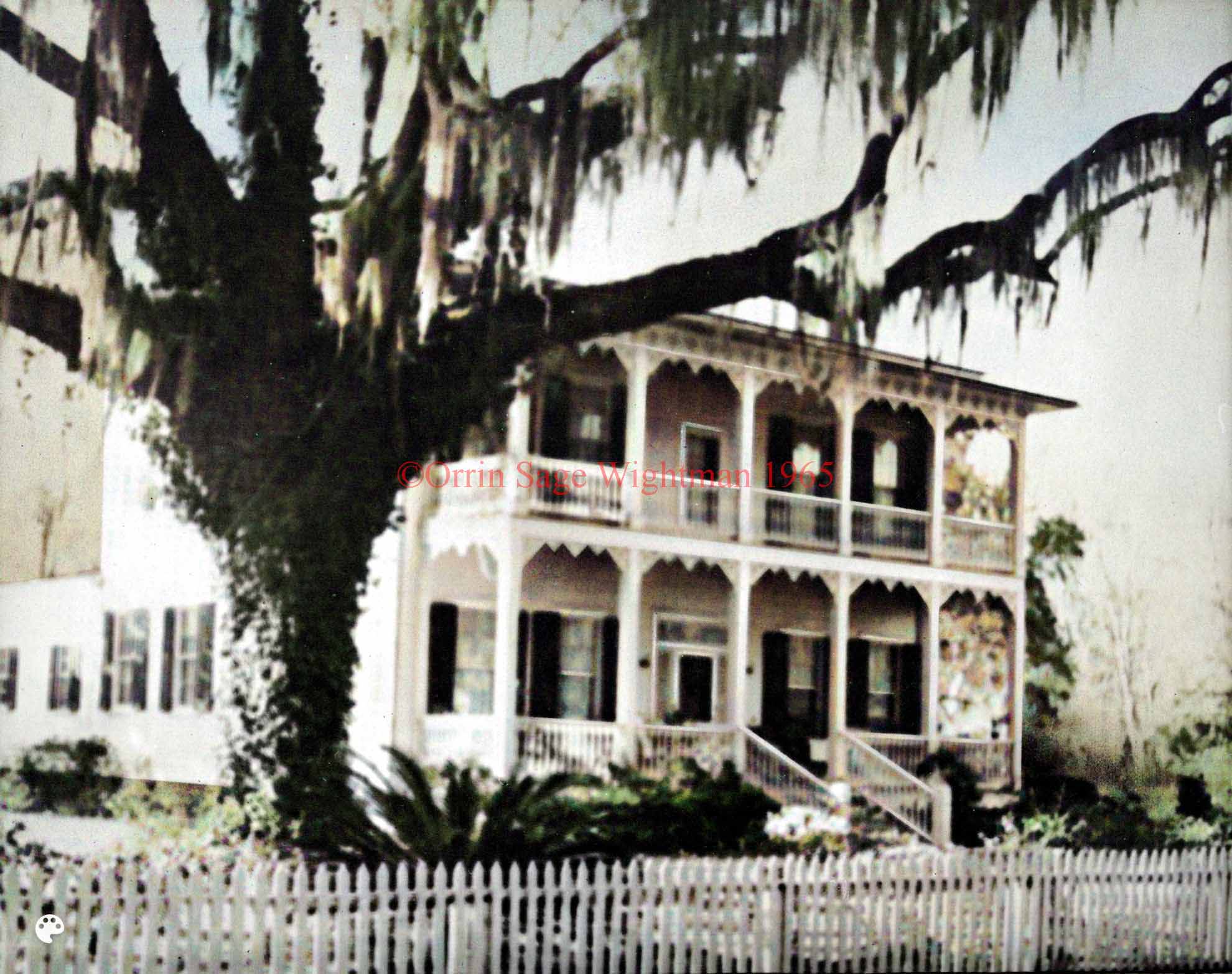
Pg. 131
Downey Home, the Ridge, Darien
This and the other beautiful homes
on The Ridge, a short distances from Darien, are typical of Darien
and its lumber era. Built in 1882 by William Downey, it has
been the family home all these years and its timbers are as sound
today as the day it was built.
Darien’s timber era began soon after the founding of our
nation. Great rafts of long leaf yellow pine, cut in the interior
of Georgia, were floated down the Altamaha River to Darien. Stored
in log booms which lined the waters for miles, the logs were carried
to the mills as needed, where they were cut into lumber and shipped
to all parts of the world in wooden sailing vessels, which crowded
the wharves of the mills waiting for their cargoes.
Generally a raft was made up of about fifty to
seventy-five logs. Two of these logs were fastened together to form
a V-shaped bow into which the logs were wedged tightly and held in
place by cross binders laid on top of the logs. A long piece of
timber, called a sweep, dressed to resemble the blade of an oar, and
mounted at the bow and similar piece at the stern, were used to
steer the raft around the bends and curves of the river.
Each raft was manned by a crew of three who lived on it
during its three or four days’ journey down the river. Planks
covered with sand were laid on the logs, where a fire could be built
and food cooked.
The “raft hands” were a hardy race and lived a rough
life. As they moved around the streets of Darien, they could be
heard even before they were seen. Their approach was
heralded by the jingle of the tin coffee pot knocking against the
iron “skillet.” These utensils were fastened to the belt on one
side, an axe fastened to the other side, and a great piece of
manilla rope coiled over the shoulder. On the streets these “raft
hands” mingled with sailors from foreign vessels who made music on
their harps and accordions and sang their native songs, all of which
gave Darien a cosmopolitan air, very different from that of an
inland Georgia community.
But times change! Railroads supplanted river traffic
and the close of the century saw the end of Darien’s timber era.
But this beautiful house, serves as a link with the day when lumber
was “king” and Darien led all Georgia in its production.
Pg. 132
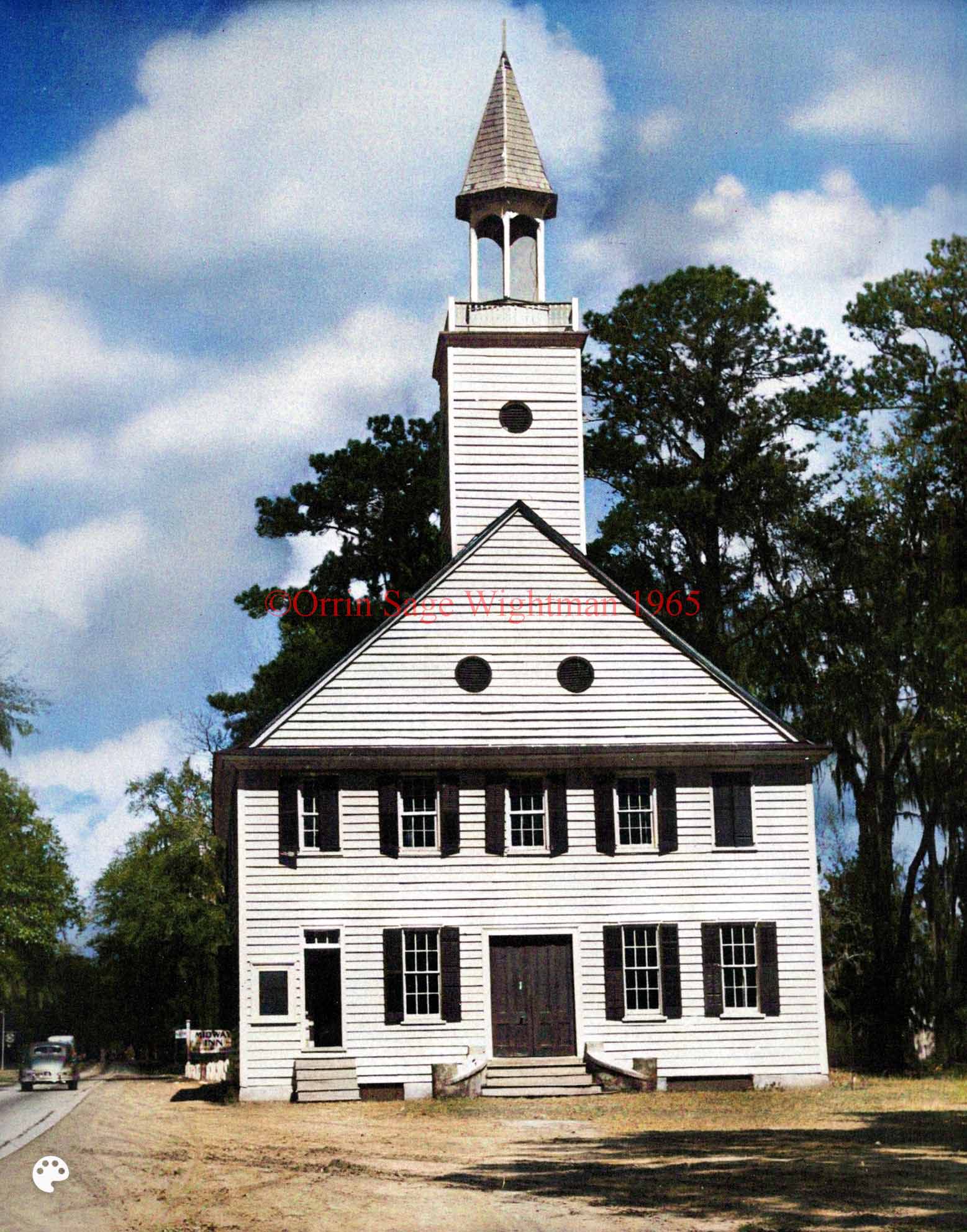
Pg. 133
Midway Church
Driving north from Darien toward
Savannah, at about the half-way mark, you round a curve in the road
and this building looms up directly ahead. With its steep roof,
your first thought is of New England for it seems out of place in
sub-tropical Georgia.
This is Midway Congregational Church, built by a group
who were descended from those who came to America in 1630 on the Mary & John and settled on the shores of Massachusetts at a
place they called Dorchester. Some of them moved to Connecticut and
settled another Dorchester, which today is Windsor. In 1695, a part
of the group moved to South Carolina and founded another
Dorchester. In 1752 some of the South Carolina colony moved to
Georgia, settled on the Midway River and, again, called their
settlement Dorchester, naming their house of worship, Midway
Church. This building was erected in 1792 to replace the original,
burned by the British during the Revolutionary War. These settlers
were Puritans and brought to Georgia an element much to be desired.
They “were the moral and intellectual nobility of Georgia.”
During the several decades just prior to the Civil War,
Liberty County sent to the University of Georgia more than double
the number of students sent from any other county in the State, with
the exception of the county in which the University is located.
During its 113 years of existence Midway Church counted
a total of 752 members and boasted that she sent out eighty-six
ministers. Among the ministers who served this church were the
Rev. Abiel Holmes, father of Oliver Wendell Holmes; the
Rev. Jedidiah Morse, father of Samuel F.B. Morse; and
the Rev. I.S.K. Axson, grandfather of Ellen (Axson) Wilson,
wife of President Woodrow Wilson.
The gallery which extends around three sides of this
church was used for Negro slaves, who attended worship with their
masters. During the Plantation Era, Midway had a white minister, as
well as a Negro preacher, who worked among the slaves of this
district. When a Negro developed ability as a preacher and gave
time to his work, the church provided him with food, clothing, and a
horse and paid his master for such time as he spent in this work.
In one instance, a slave was purchased by the church so that he
might be free and give himself wholly to the work of the church
among his own people.
Pg. 134

Pg. 135
Midway Cemetery
In the cemetery across the road
from the church lie the bodies of many noted men and women, Midway’s
sons and daughters. Among them are eleven ministers, a governor, a
senator, high-ranking Army and Navy officers, about two score
Revolutionary soldiers, doctors, lawyers, and persons prominent in
every walk of life.
Here lie the ancestors of
John and Joseph
LeConte, founders of the University of California, as well as
the bodies of two Revolutionary generals, Gen. James Screven
and Gen. Daniel Stewart, the ancestor of President Theodore Roosevelt and of
Mrs. Franklin Delano Roosevelt.
This Midway District, the Parish of St. John, was
labeled “the cradle of the Revolutionary spirit in Georgia.” The
youngest of the Thirteen Colonies, Georgia was slow to take steps
which would alienate the Mother Country and, when she refused to
send delegates to the First continental Congress, Midway sent her
own representative, Dr. Lyman Hall, who was seated, “as a
delegate from the Parish of St. John in the Colony of Georgia.” By
the time the Second Continental Congress met, Georgia, had fallen in
line and sent regularly elected delegates. Three of these achieved
immortality by becoming signers of the Declaration of Independence,
and two of these Signers, Lyman Hall and Button Gwinnett,
were from Midway.
As a tribute for its devotion to the cause of freedom
from British rule, the first Constitution of the State of Georgia
designated this area as Liberty County.
The service rendered by these people in the founding of
the Nation was recognized in 1915 when the United States erected in
this cemetery a monument to the memory of the two Revolutionary
generals who are buried here.
Pg. 136
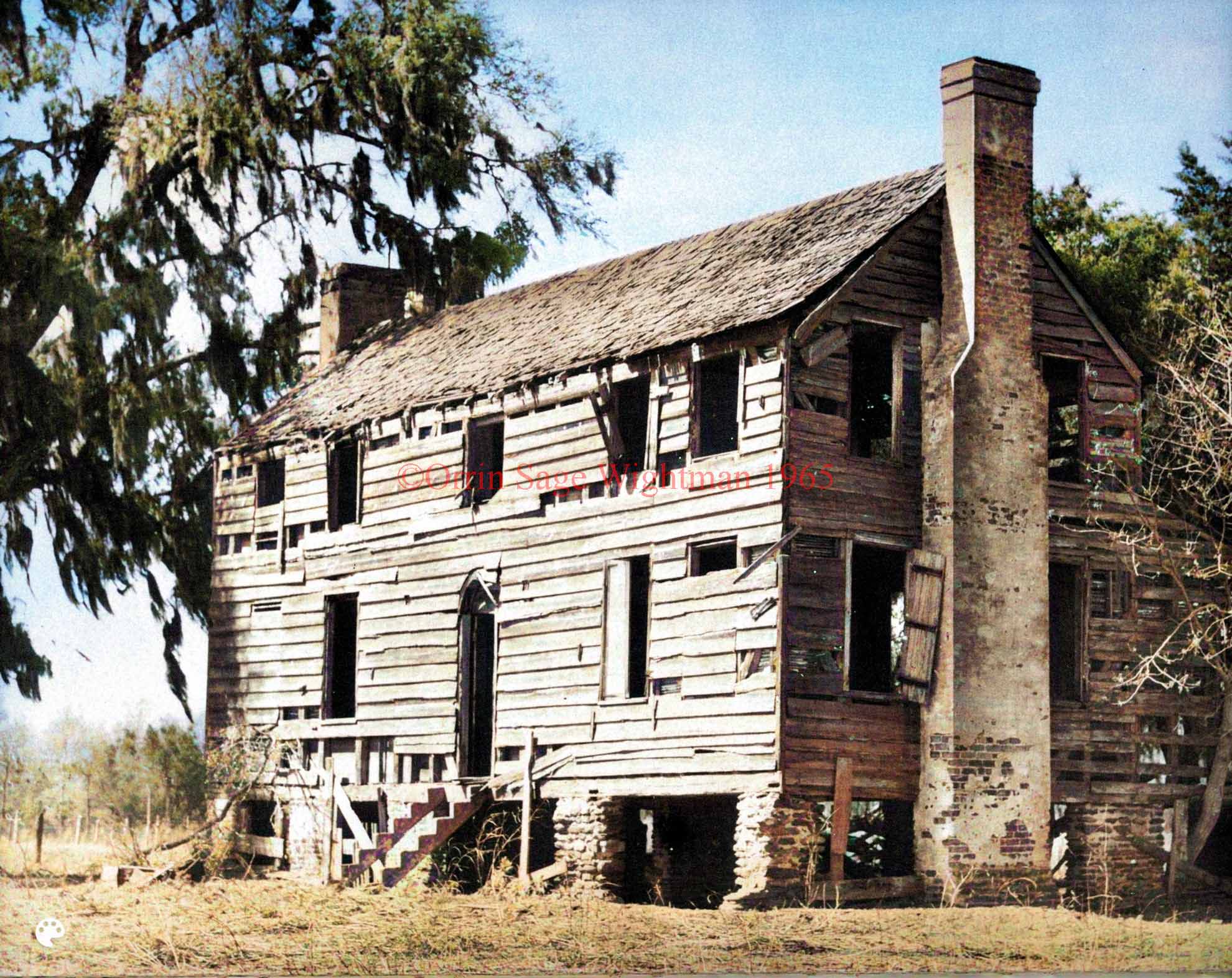
Pg. 137
Old Screven House at Sunbury
Standing as a lone survivor of
Sunbury’s former glory, this old Screven house, built about 1815,
surveys a scene of quiet beauty where once the bustle of trade and
commerce held sway; for Sunbury was the port for prosperous Midway
District which, in the 1770’s, possessed nearly one-third the wealth
of Georgia.
In 1758
Capt. Mark Carr, one of Oglethorpe’s
officers and Brunswick’s first settler, gave the land for the town
of Sunbury. Located on a bluff overlooking the waters of Midway
River and across the Sound from the Islands of Ossabaw and St.
Catherine, Sunbury soon became a place of importance.
A small earthwork, Fort Morris, situated just below
Sunbury, was built for the protection of its inhabitants. In 1778
this fort was commanded by Col. John McIntosh, who
successfully defended it against an attack by the British. To their
demand for its surrender he replied, “Come and take it!” Fort
Morris fell the following year, being the last spot in the State to
surrender when Georgia was overrun by the British.
Dr. Lyman Hall, one of Georgia’s Signers of the
Declaration of Independence, made his home in Sunbury and was the
medical doctor for the community, though his plantation was located
on the Post Road (now Route #17) a few miles north of Midway
Church. It was from this port of Sunbury that he carried 160
barrels of rice and sixty pounds sterling, as a contribution from
its citizens to relieve the condition of the patriots at Boston.
Button Gwinnett, Georgia’s other Signer from
Midway District, had his plantation home on St. Catherine’s Island,
within sight of Sunbury where he transacted business and moved among
its citizens as one of them.
Only this old house remains of the town that had a
population of about a thousand just before the Revolutionary War,
and was considered a rival of Savannah in commercial importance.
Today, Sunbury is a “dead town.”
Pg. 138
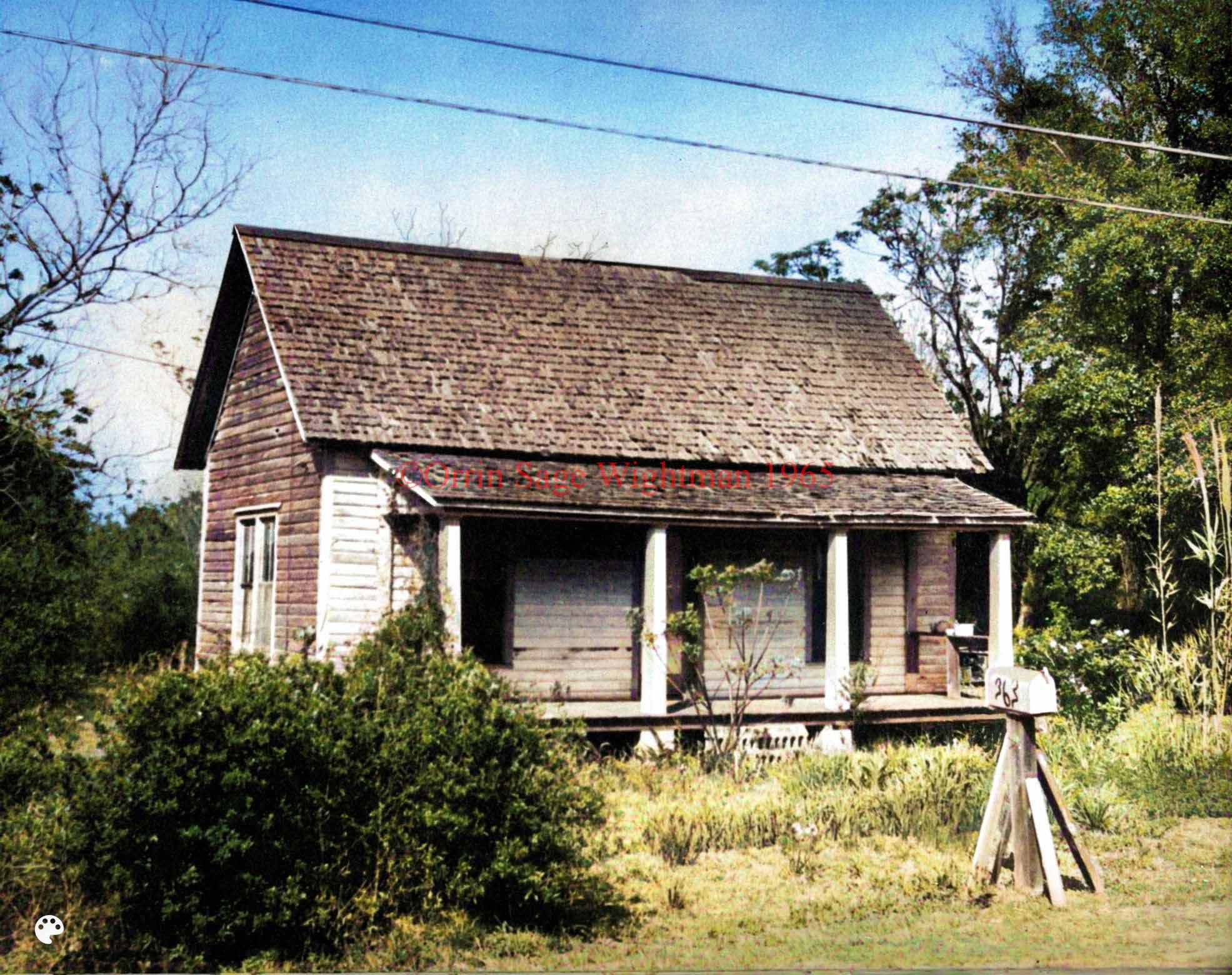
Pg. 139
A Negro Home in Jewtown
After the Civil War the former
slaves of the St. Simons plantations settled themselves in several
communities. Those from the plantations at the North End acquired
land and settled in Harrington, while the Negroes from the
plantations on the lower part of the island grouped themselves in an
area which they called the South End. Another settlement wasl
ocated east of Gascoigne Bluff and near the site of the Hilton Dodge
Lumber Company mill.
At this mill, of course, there was a commissary, where
the workmen purchased their supplies. Soon, a Jewish merchant named
Levison located his store just off the mill property and
between the mill and the Negro settlement. He called the area
Levisonton, but the Negroes called it “Jewtown”; and so it is till
this day, even though Levison moved away in 1880.
In these settlements each Negro secured a small plot of
ground and built his home. Among these people the ambition to own
their homes is very strong. Furthermore, they want that home to
have a sufficiently large piece of land around it so that they will
not feel they are hemmed in.
In these homes they keep alive many of the old practices
of their ancestors. They paint on the doors and windows blue,
believing that, since blue is the color of Heaven, the devil will
not come near the blue opening in the house, so they will be safe
and secure.
Another custom which is thought to be a protection is
the practice of papering the walls with newspapers for when the
“ha’nts” come at night, they have to read every word on the wall
before they can go to work on the people in the house. When the
walls are not papers in this fashion the newspapers may be spread on
the tables, the mantels, or even the floor. No matter where they
are, the “ha’nts” have to read them. Since they could not possibly
finish them in one night and have to start over the next night, the
persons in that house are safe; for no “ha’nt” can work in the day.
“Ha’nts” are creatures of darkness!
Pg. 140
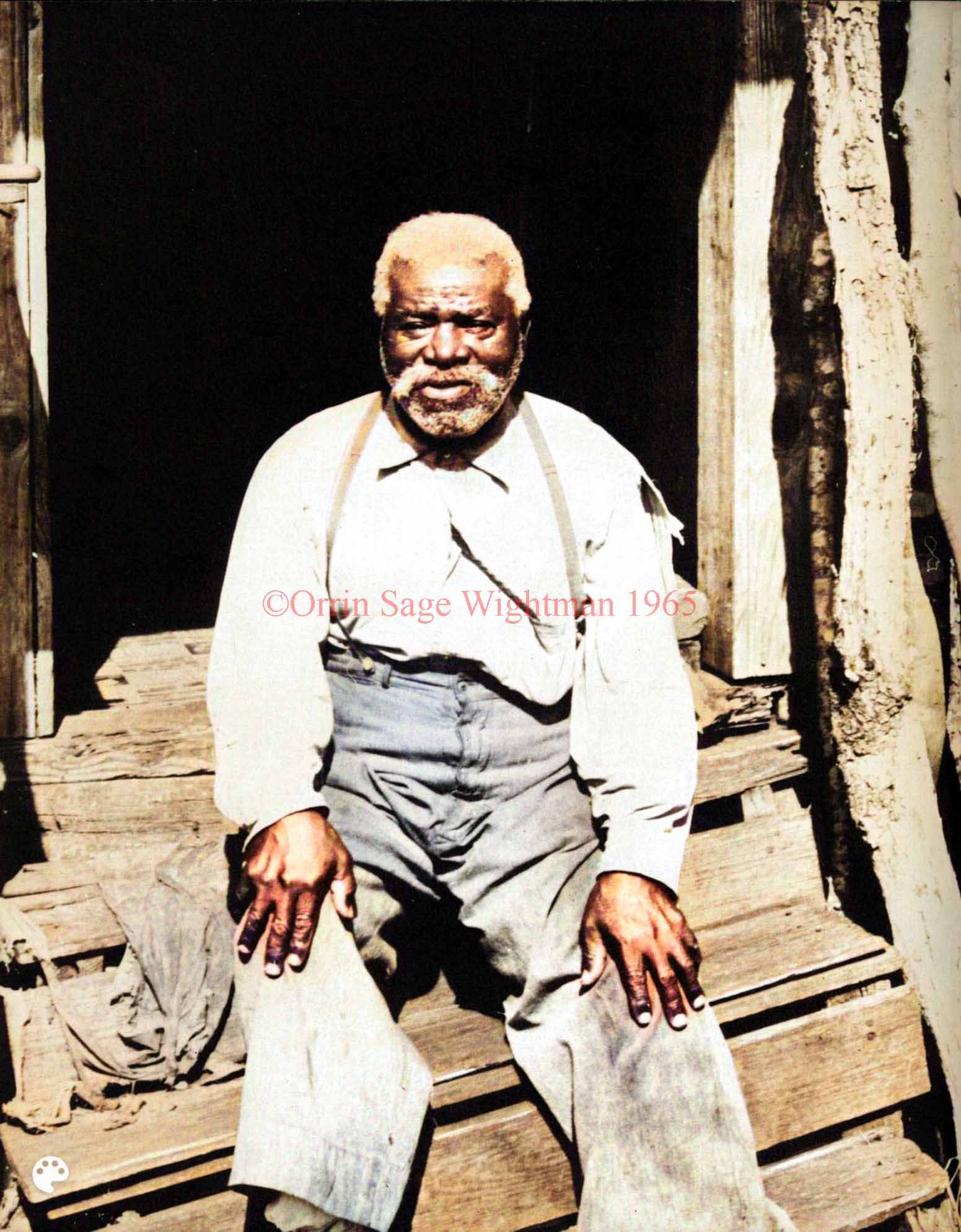
Pg. 141
Bacchus Magwood
A familiar figure among the Negroes
of Jewtown for almost his entire life, Bacchus was an
interesting person and made himself a good neighbor in the finest
sense of the word.
When
Liddy who lived next door became ill, he
took her to his house and cared for her until she died.
Years later
Bacchus’ house burned and he was left
homeless. A friend who inquired where he was staying was told, “I
move over an’ stay wid Lily.”
“Bacchus, I knew someone would give you a home
for I remember when you took Liddy into your home and cared
for her when she was sick and helpless.”
Back came the reply, “You cas’ your bread!”
Pg. 142
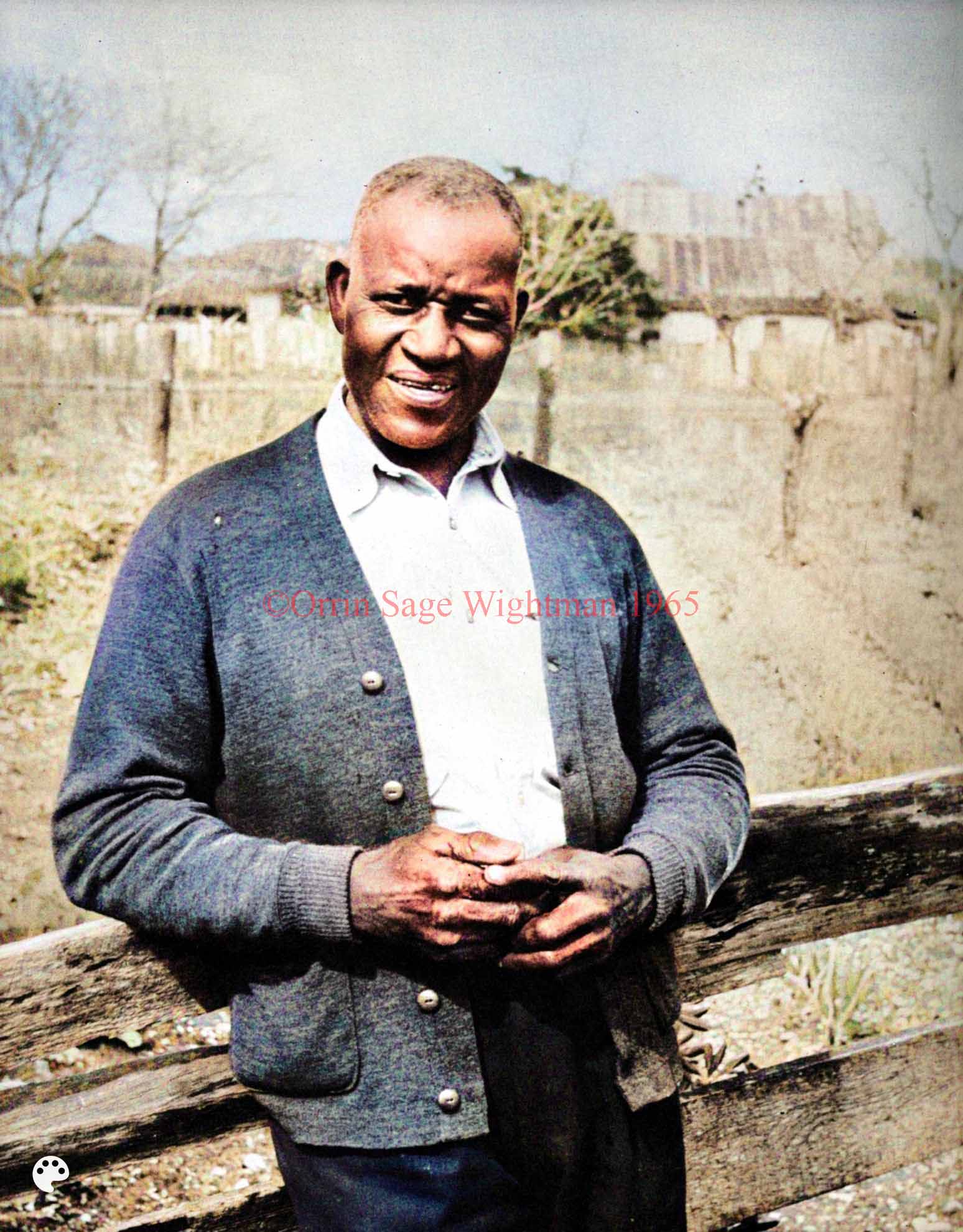
Pg. 143
Willis Proctor
Willis Proctor belongs on
St. Simons Island where his ancestors have lived for many
generations. His mother was Mina, the daughter of Robert
Merchant, who was one of the Retreat “people,” as Mrs. King
called her slaves. It was Robert who, in 1848, planted the
beautiful avenue of live oak trees which formed the entrance to the
plantation. Robert Merchant and Mina are buried in
the old Retreat burying ground just north of the Sea Island Golf
Club House. There, for a century and a half, the Negroes of this
plantation have been buried—and there they still bury their dead.
Willis’ father, Adam Proctor, who belonged to the Goulds of Black Banks Plantation, is buried in the cemetery
belonging to the people of that plantation, located just south of
Harrington.
Willis is a capable man and has held many
responsible positions. For ten years he had charge of he dining
room at the Arnold House on St. Simons and held a similar position
at the Georgia Military Academy at College Park. He later worked
for the Jekyll Island Club and became the personal valet of William Rockefeller at his Indian Mound home on Jekyll. Now,
for many years, he has operated his own store near his home in the
South End section of St. Simons.
Willis has made himself outstanding among the
members of his race. His honesty, his integrity, and his
dependability are the qualities which have made him a leader and
highly regarded by all who know him. He is a leader, too, among the
singers who keep alive the old songs of his people. Of all of these
songs, his specialty is:
One o’ these days, my people; One
o’ these days, my people;
One o’ these days, When the Lord call me home.
Well, we soon shall be done with the crosses;
Well, we soon shall be done with the troubles o’ the
world;
Well, we soon shall be done with the crosses.
Shaking hands with each “Sister” he
in turn sings:
Sister Charlotte, One o’ these
days;
My sister, One o’ these days, My sister, One o’ these
days,
When the Lord call me home.
Going on down the line to “Sister”
after “Sister,” he sings to each as he shakes her hand.
Pg. 144
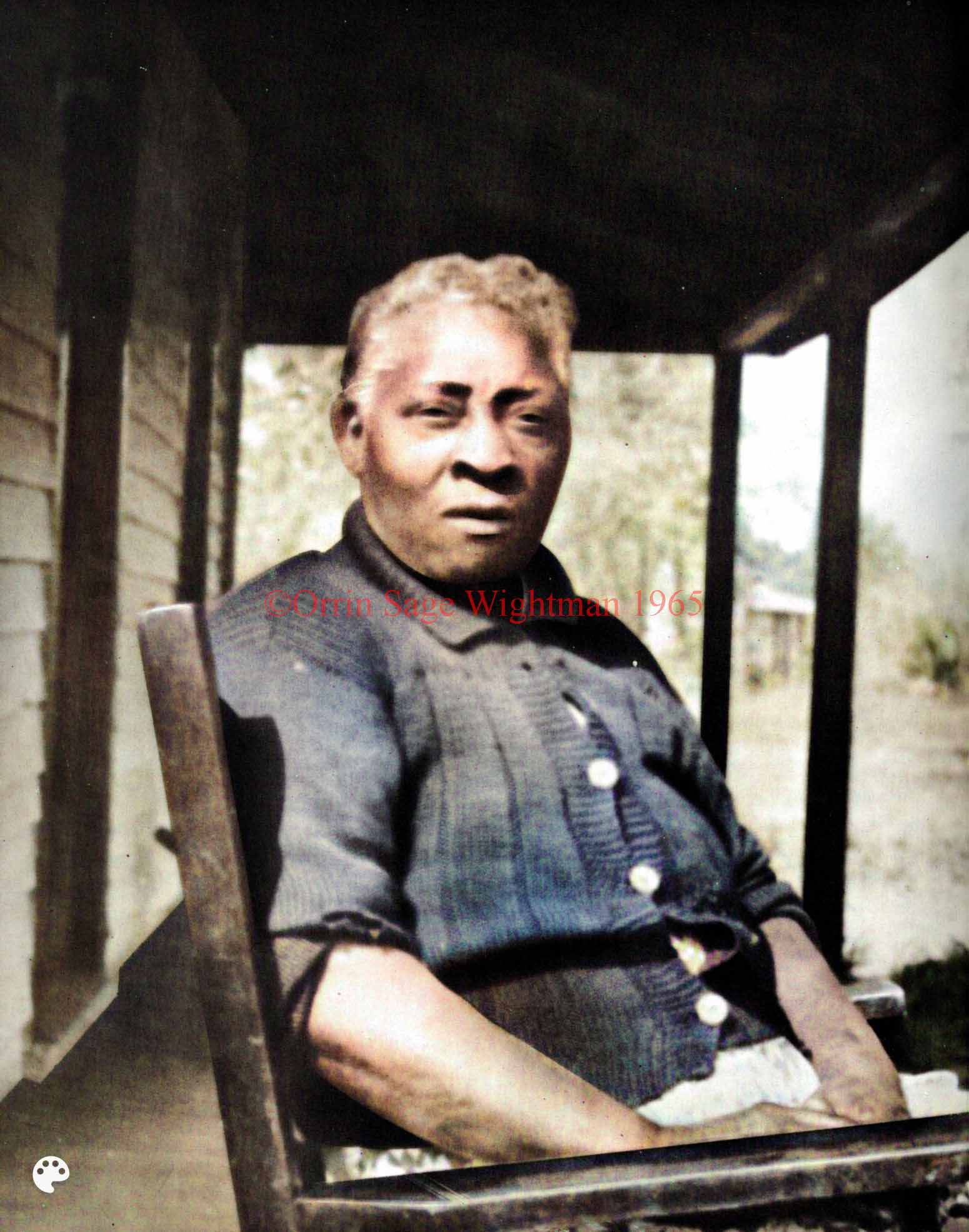
Pg. 145
Julia Armstrong
Willis’ sister, Julia,
the wife of Joe Armstrong, was employed by the late Mrs.
Maxfield Parrish when Mrs. Parrish first came to St.
Simons. Mrs. Parrish became interested in the singing of the
Negroes and Julia found the men and women who could sing the
old songs in the old way. Mrs. Parrish recorded these
spirituals and “shouts” and saved them for posterity in the
publication of her excellent book, Slave Songs of the Georgia Sea
Islands. By insisting that the Negroes sing the old-fashioned
way Mrs. Parrish created in their minds a feeling of respect
for the songs of their ancestors. She held “sings” at the cabin she
built for this purpose and made it possible for visitors to enjoy
them. Now, these “sings” are held regularly at The Cloister Hotel
on Sea Island.
The spirituals are American music, having been developed
on the plantations of the South, but the “shouts” are of African
origin. These religious dances were brought from Africa and kept
alive by the Negroes who performed them in their churches. The
“shouters” go round and round with a shuffling motion of the feet
and a tap of the heel on the floor, singing all the while. In
Africa they would have used with these shouts a drum, but in the
South this instrument was denied them. This came about because of a
slave uprising in South Carolina in 1739, known as the Stono
Rebellion, which, led by a Negro with a drum, resulted in the death
of dozens of people, black and white. So, to take the place of the
drum, they tap on the floor with a broomstick.
The words sung with these “shouts” can have no
connection with the words used for their dances in Africa. One is
“Knee Bone Bend” and as they sing, they bend their knees in
supplication. Another is “O Eve, Where is Adam? Down in the Garden
Picking up Leaves”. As they sing, they go through the motion of
picking up leaves. Still another is “On the Eagle’s Wing” in which
they hold their arms out as if they were the wings of the eagle.
In all of this the Negroes give an authentic production
without modern innovations and free from any touch of the white
man’s influence. A picture from the past!
Pg. 146
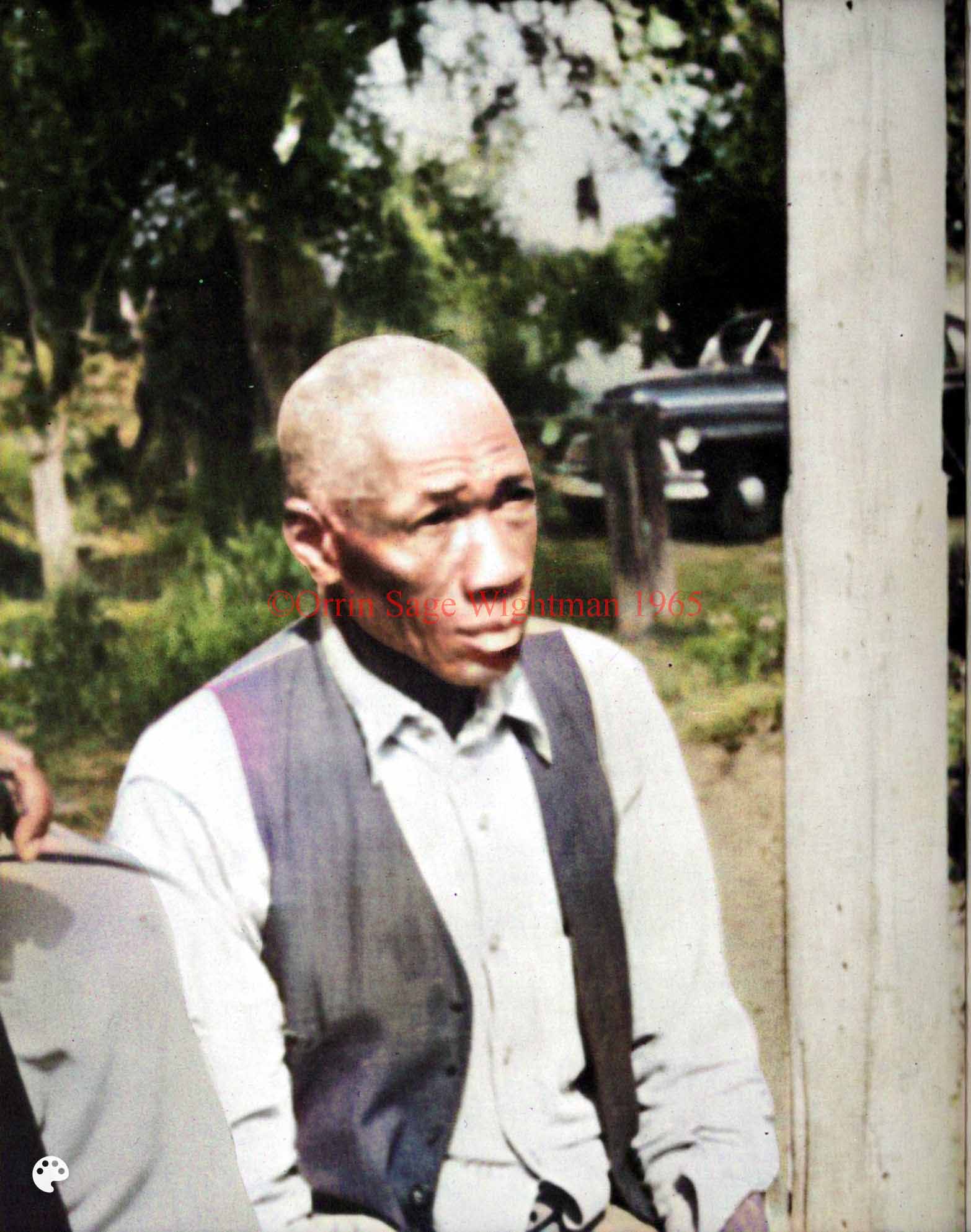
Pg. 147
Joe Armstrong
Joe, who is Julia’s
husband, is also one of the singers. However, he specializes in
work songs or chanteys. For many years he was a stevedore at the
Hilton Dodge Lumber Company mill, located at Gascoigne Bluff on St.
Simons Island, on the site of Hamilton Plantation, now the location
of the Methodist Center, Epworth-By-The-Sea.
The long-leaf yellow pine which supplied this mill was
cut in the interior of Georgia and floated down the Altamaha River
in great rafts. The mill operated from 1874 until it closed in 1903
and vessels from all parts of the world tied up at the wharves to
load this lumber.
Among the Negroes engaged in the loading of these
vessels, those who had the ability and could direct the work of
others were known as stevedores. These stevedores played an
important part in the successful loading of the vessels, for the
heavy timbers had to be carefully stowed away so that they would not
shift and cause damage to the vessel during the ocean voyage. As a
stevedore, Joe had charge of a gang of men who moved these
heavy timbers from the wharf and stowed them in the hold of the
vessel. In order that they might all pull together to move these
timbers, they sang as they worked and, at the proper place in the
song, gave a great pull.
One song which was very popular with the workers—and is
still used when men are moving a house or doing work of that
sort—was:
Oh pay me, pay me, Pay
me my money down;
Pay me or go to jail; Oh pay me my money
down.
Think I hear my captain say Pay me my money
down,
Tomorrow is my sailing day, Oh pay me my
money down.
Oh pay me, pay me, Pay me my money down;
Pay me, Mr. Stevedore, Oh pay me my money
down.
One o’ these days I’m goin’ away, Pay me my
money down,
Won’t be back till Judgment Day, Oh pay me
my money down.
Oh pay me, pay me, Pay me my money down,
Pay me or go to jail, Oh pay me my money
down.
Wish I wuz Mr. Alfred Jones’ son, Pay me my
money down,
Stay in de house and drink good rum, Oh pay
me my money down.
Pg. 148
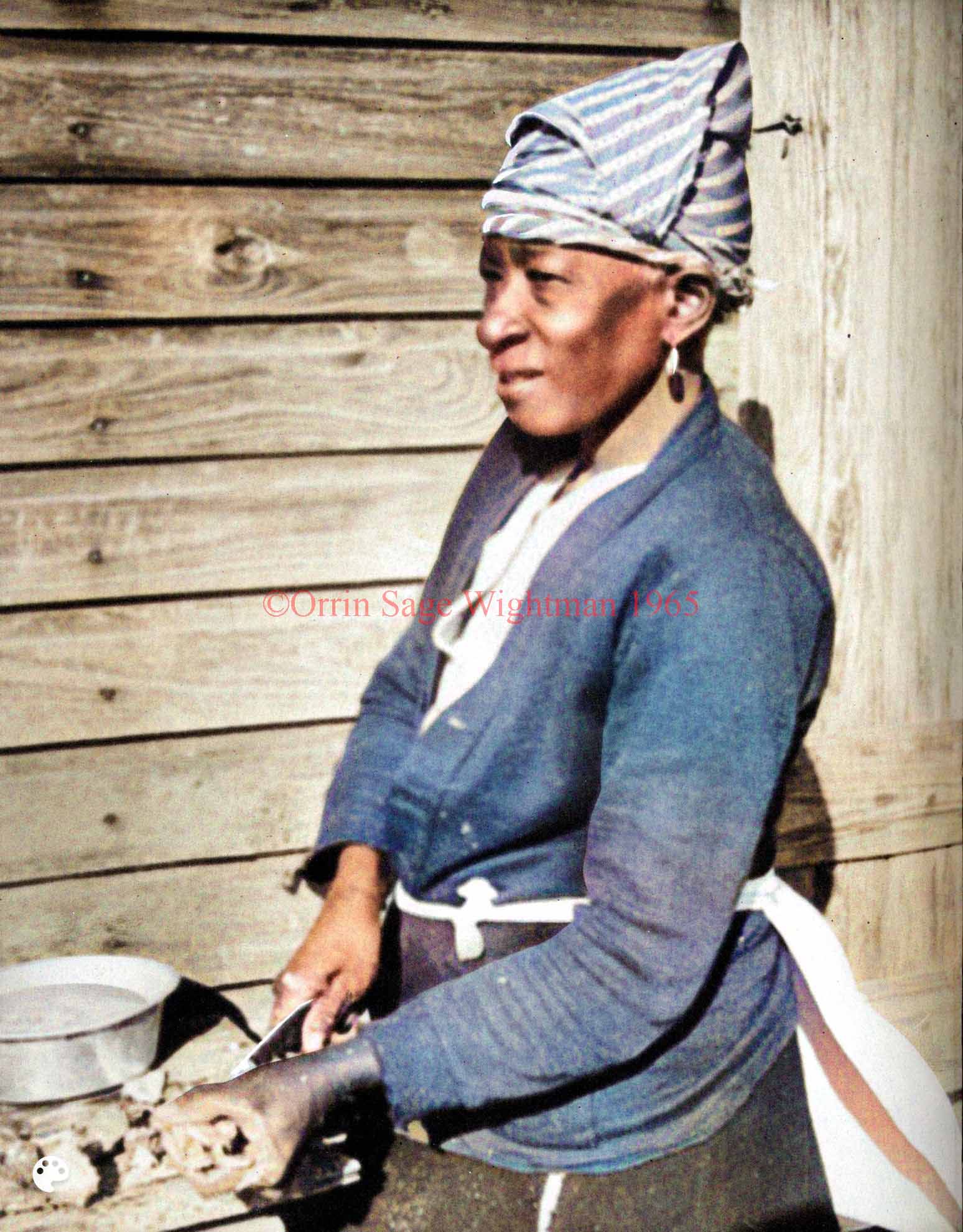
Pg. 149
Edith Murphy
Edith Murphy is a St. Simons
Island woman whose ancestors for many generations belonged to the Demere family.
Capt. Raymond Demere, the first of his family to
come to America, was a native of France who had seen service with
the British at Gibraltar and came to Georgia in 1738 as an officer
in Oglethorpe’s Regiment. He was granted lands near
Frederica where he built his home “rather in the French taste than
the English.” He called his home Harrington Hall in honor of his
friend, Lord Harrington, under whom he had served at
Gibraltar. Later, the Demeres moved to Mulberry Grove at the
South End of St. Simons, a plantation which took its name from the
fact that here were planted thousands of white mulberry trees.
These were to feed the silk worms of the industry which was planed
in the early days of the colony.
The
Demeres have not lived on St. Simons since
the Civil War. Gone are the plantation house and the slave cabins.
The only evidence of their occupation of the place was the family
burial ground, enclosed in a tabby wall and containing the bodies of
several generations, including three Raymond Demeres. When
the airport was enlarged, these tombstones were moved to Christ
Church Burying Ground at Frederica.
Edith lived on land which was a part of Mulberry
Grove and on the site occupied by the slave cabins which houses her
ancestors. She is one of the group of singers who sing the
spirituals and “shouts” in the authentic manner and is one of the
best of these singers, her specialty being “Hush Hush, Somebody
Callin’ My Name.”
Here,
Edith is opening oysters. The empty shells
will go into a tin can on the ground and the aluminum pan on the
table is almost full of oysters. Most people wear an apron to keep
a dress clean. Evidently, Edith’s apron is clean and she
does not want to get it dirty!
Pg. 150
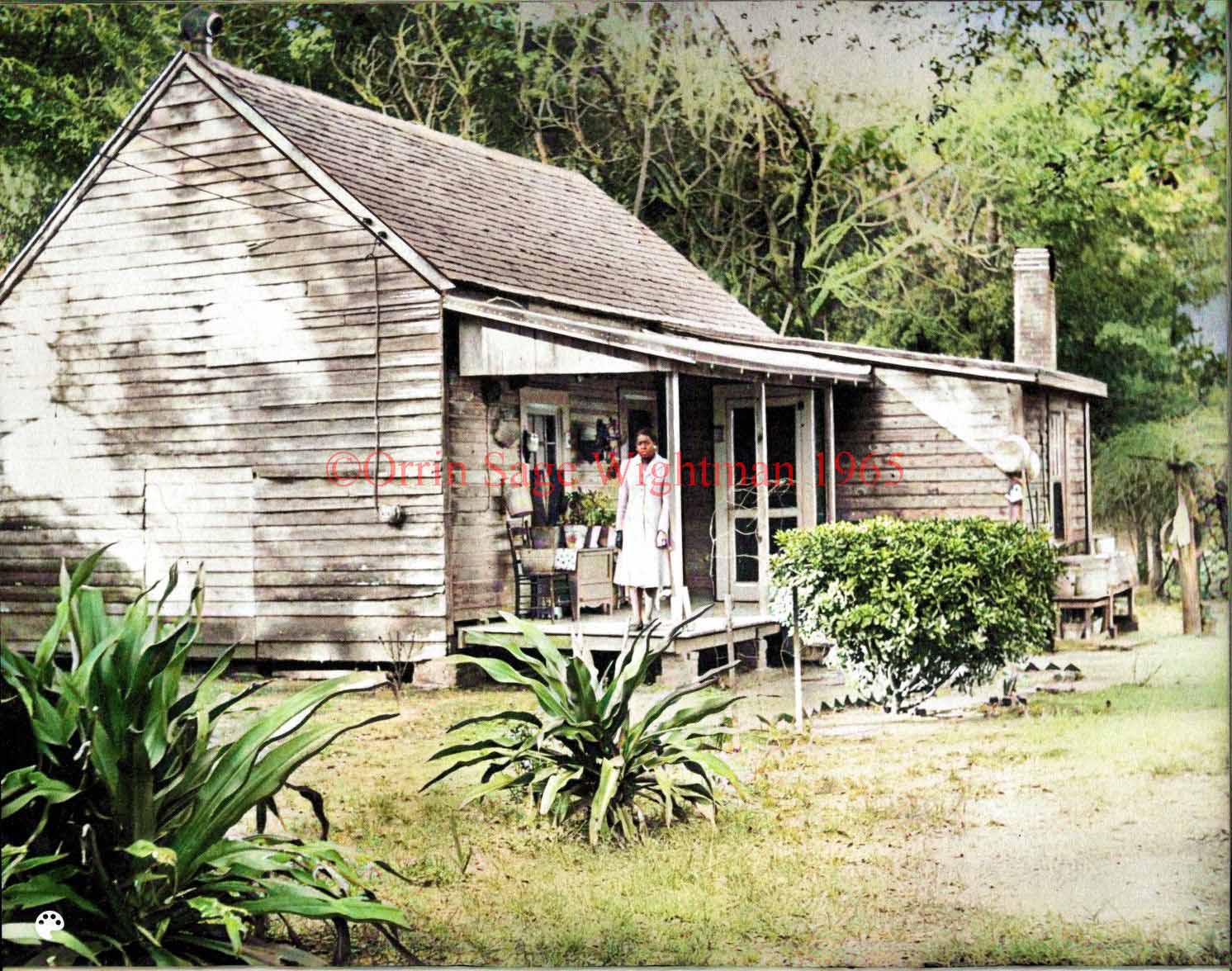
Pg. 151
The House that Neptune Built
Neptune was the faithful
servant of the Thomas Butler King family of Retreat
Plantation. When the son of this family, Capt. Henry Lord Page
King, enlisted in the Confederate Army and went off to war, Neptune went along to act as his body servant. In Virginia at
the Battle of Fredericksburg, Capt. King was killed. When
night came on and the master did not return from battle, Neptune
went out to search for the body, found it, and brought it home—all
the way from Virginia to Georgia. Today, Capt. King’s body
lies in the family burial plot in Christ Church Burying Ground,
Frederica.
After the war,
Neptune was given a piece of
ground on the southern edge of the Retreat lands where he built this
house and made his home. During the reaming years of his long
life—for he died around the turn of the century—“Daddy” Neptune
was honored and respected by all who knew him. (In this area old
Negroes were called “Maum” and “Daddy” not “Aunt” and “Uncle.”)
Looking around for a family name, for there were no
surnames in use among the Negro slaves before the war, Neptune
took the name Small, because of his own small stature. His
descendants living here now are very proud of their ancestor and
proudly relate the story of his heroism.
Neptune is buried in the old Retreat Burying
Ground at the Sea Island Golf Course, his grave marked by a bronze
tablet which tells the story of his heroism. Set in a base of
tabby, such as Neptune would have built, his marker is a most
appropriate memorial.
Neptune’s daughter, Cornelia, lived with
him even after her marriage to Cassius Murphy; and a daughter
of Cornelia and Cassius, Charlotte (Murphy) Reese,
was born in this house and lived there until recently.
A visitor who knew the house and had seen it many times
during the eighty-five years that it had been occupied as a home,
drove around in the area looking for it. Failing to find it, she
stopped in a Negro settlement and asked what had become of the house
and was told, “Neptune house been tore down. Yes ma’am,
Charlotte wuz libin’ dere in a nes’ o’ white folks an’ she sell
out an’ move ober here wid us.”
Pg. 152
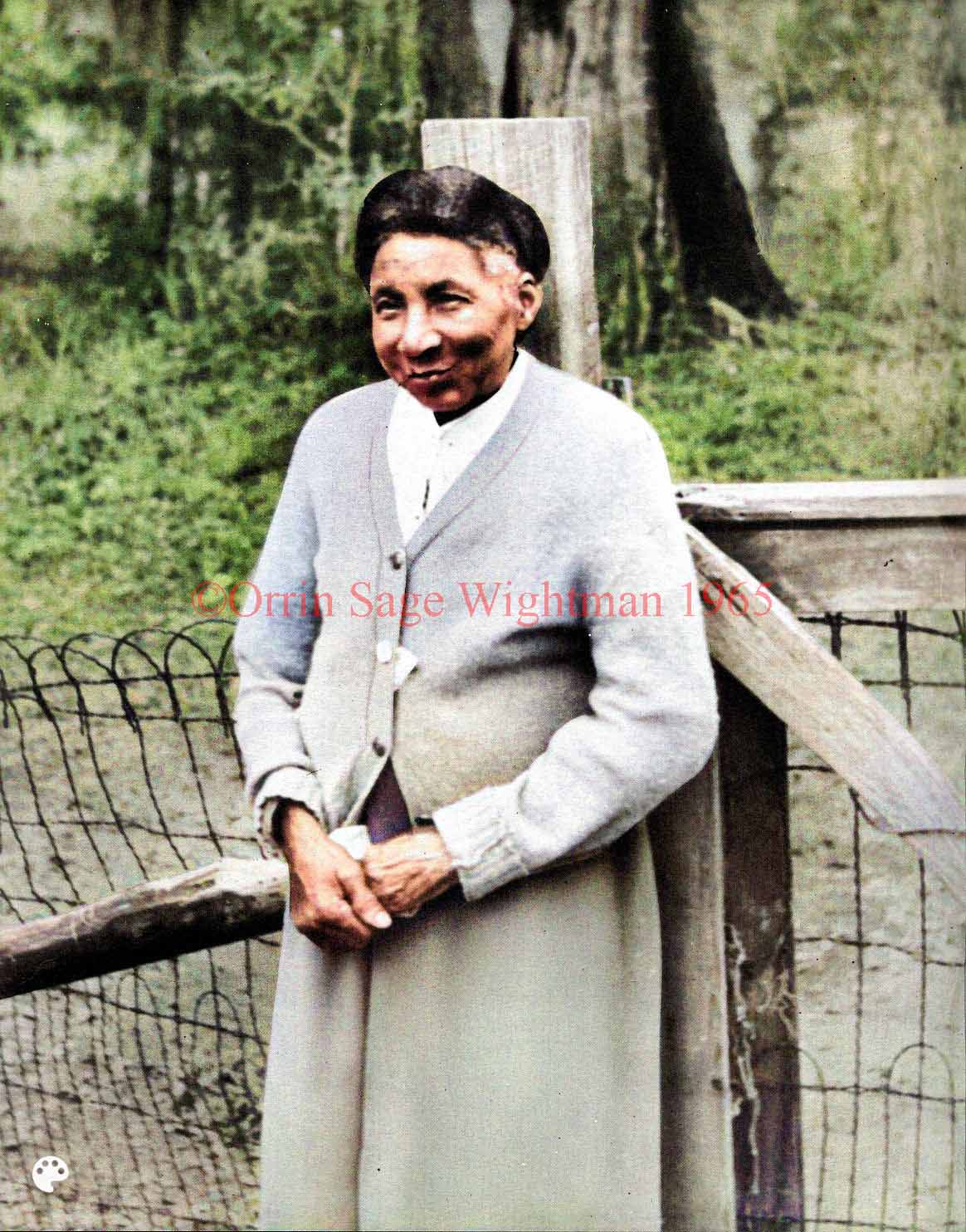
Pg. 153
Lavinia Abbott
This woman,
Lavinia (Sullivan)
Abbott, and her brother, Ben Sullivan, whose picture
appears on the next page, are from a well-known St. Simons Island
family of Negroes, being the grandchildren of old Tom, whose
African name was Sali-bul-Ali. Tom, who was of the
Foulah tribe, was purchased in the Bahama Islands about 1800 by John Couper of Cannon’s Point Plantation, St. Simons.
Mr.
Couper and his son, James Hamilton Couper of Hopeton and
Altama Plantations, were high in their praise of Tom’s
industry, his intelligence, and his honesty.
Tom was given positions of trust on the
plantation, finally being made the head man of Hopeton Plantation, a
position he held for three decades. James Hamilton Couper
wrote that he left Tom in charge of the plantation and its
450 Negroes, without an overseer, for months at a time and found him
fully capable of managing the estate.
Tom, who was a Mohammedan, abstained from the use
of spirituous liquors, kept the fasts, and was free of the African
belief in evil spirits. He had a Koran and could read but not write
Arabic. His African home was on the Niger River, where he was a
native of the Town of Kianah in the District of Temourah in the
Kingdom of Massina. He said his parents were farmers and were
possessed of considerable property. In 1785, when he was fourteen
years of age, he was captured and sold into slavery.
During
Tom’s lifetime there were a number of
Negro slaves on the plantations along the Georgia coast who were
Mohammedans. One of the best known of these was Bilalli of
Sapelo Island. His owner, Thomas Spalding of Sapelo, made
him the head man of the Sapelo Plantation. This Bilalli of
Sapelo could read and write Arabic and a manuscript which he wrote
in that language is preserved in the Georgia State Library in
Atlanta. Though these men kept their faith and were strict
Mohammedans, their children were Christians.
Pg. 154
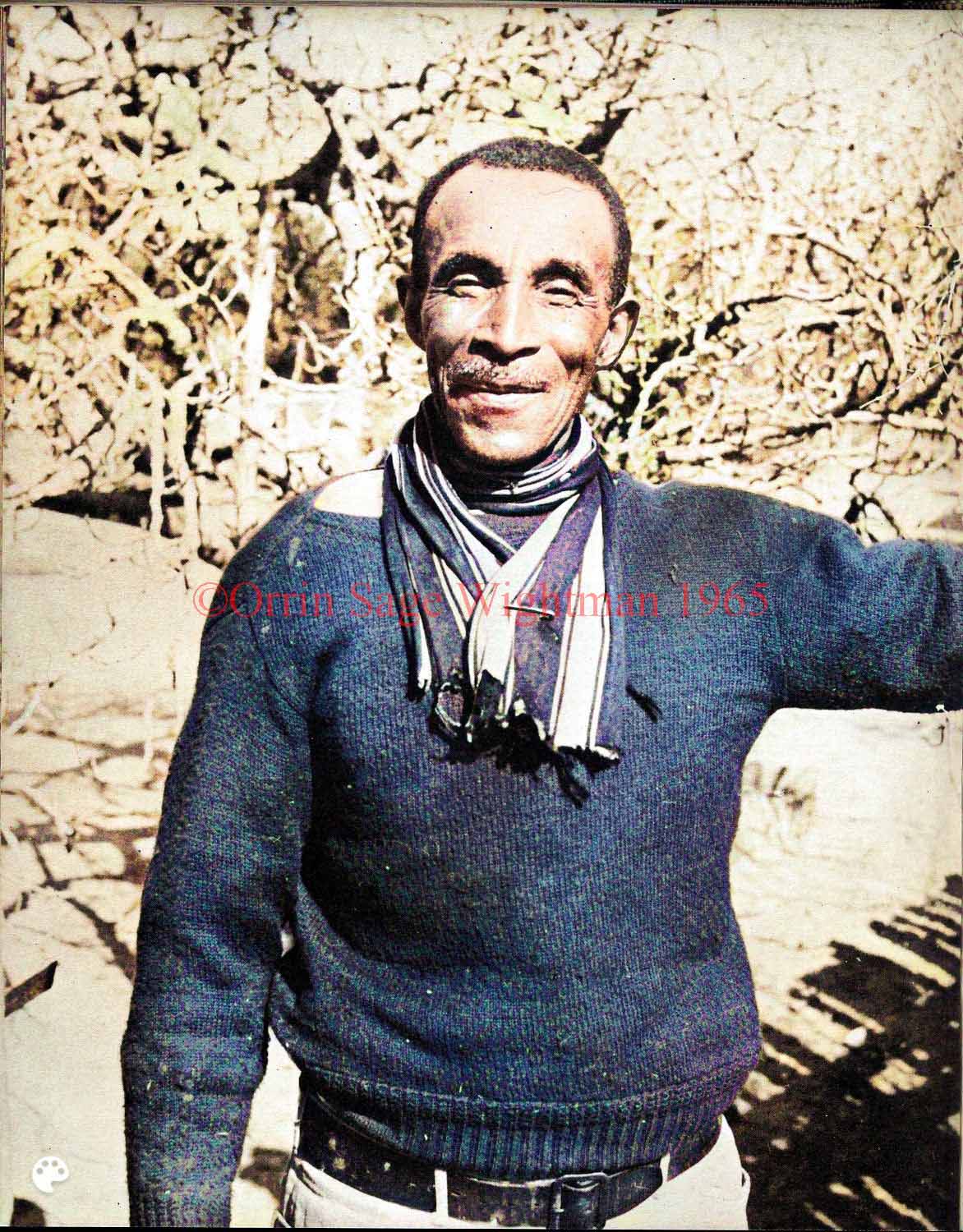
Pg. 155
Ben Sullivan
Ben Sullivan comes of a
family that can trace its ancestry back to a definite spot in
Africa, being one of the very few Negro families in this country who
can do this.
Old Tom—or, to use his African name, Sali-bul-Ali—had a son who was called
Bilalli. After the
emancipation of the Negro, Billali adopted the family name of
Sullivan and his numerous descendants now living on St.
Simons are a superior group of Negroes who owned their homes and
operate their businesses or follow some trade or profession with the
same good judgment and attention to duty which characterized their
grandfather, old Tom.
Many of these descendants, like the ones pictured here,
possess the same physical characteristics described as belonging to
old Tom. James Hamilton Couper wrote that Tom
was “tall, thin, but well made. His features are small, forehead
well developed, mouth well formed, with lips less protruding than is
usual with the Negro race, the nose flat, but not thick. His eyes
are peculiar, being like those of a Chinese, without their
obliquity…” Mr. Couper further stated that Tom’s hair
was wooly and his skin a brownish black.
Many of the
Sullivan family on St. Simons live in
a settlement known as “Harrington”. During the Colonial Era these
lands were granted to Capt. Raymond Demere of Oglethorpe’s
Regiment, who called his home “Harrington Hall” in honor of Lord
Harrington under whom he had served at Gibraltar. After the
emancipation of the Negro many of the former slaves of the old St.
Simons plantation began to settle here in a group. They acquired
small tracts of land which gave them sufficient space for a garden,
a cow, hogs and chickens; and, with the money they made at “The
Mills,” they were able to live comfortably. Today, this entire
settlement of about a hundred houses is occupied by Negroes who own
their homes and are respected citizens.
Pg. 156
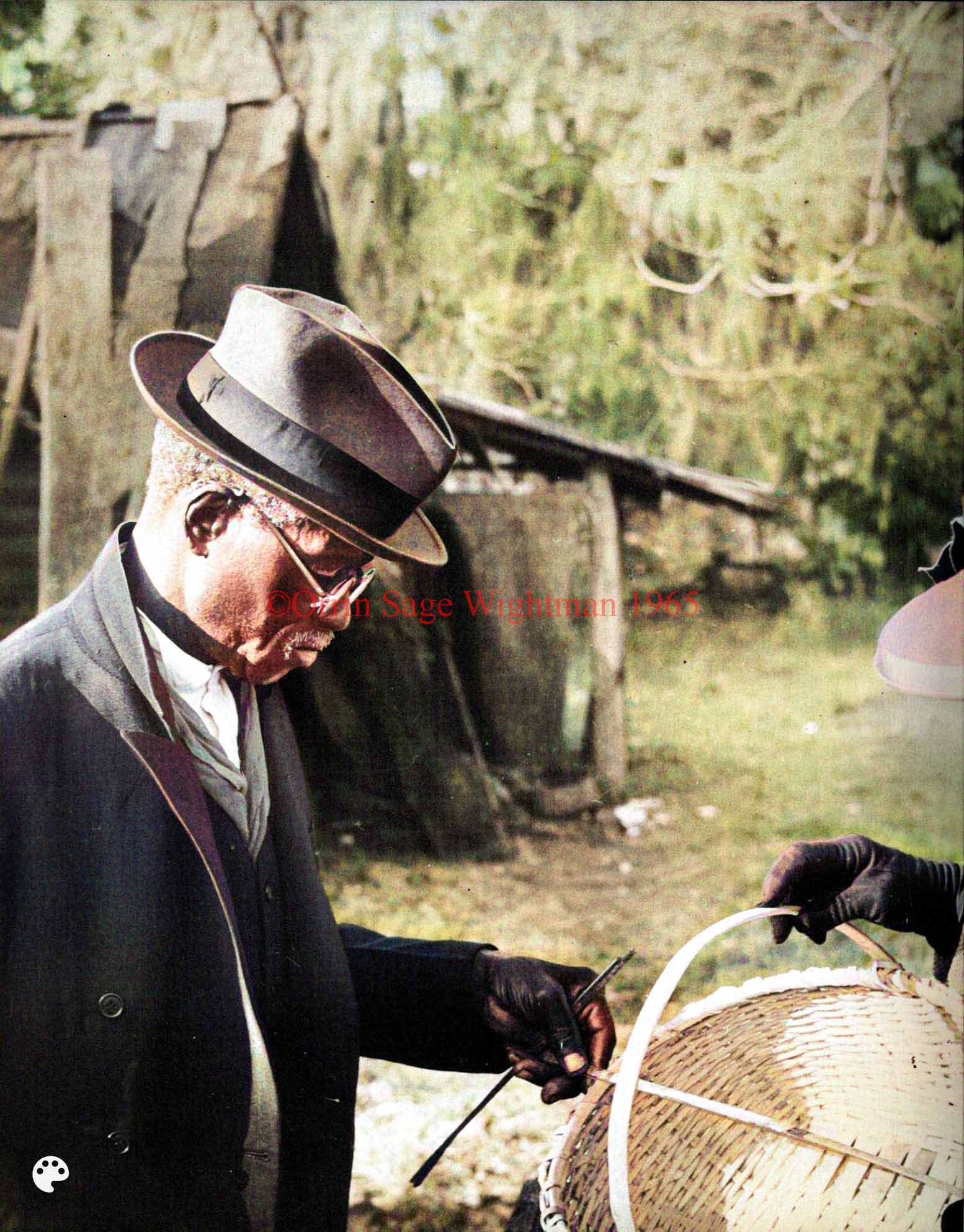
Pg. 157
Charles Wilson, The Basket Maker
Charles Wilson was the last
of the old basket makers to ply his trade in this area.
His baskets were beautifully made and no shoddy piece of
work ever came from his hand. To make his baskets Charles
used the leaf stem of the cabbage palmetto, or sabal palm. He split
these leaf stems and worked them to a uniform width and thickness
with a pocket knife. As eh wove these pieces into baskets he turned
the outer surface of the stem to the outside so as to give the
baskets a highly polished finish.
Once, when he was asked to duplicate a basket, he
started looking around on the ground for his “ya’d stick.” Thinking
he meant a thirty-six-inch ruler, which most people call a “yard
stick,” the visitor was surprised to see him pick up a stick which
he kept in the yard and was, therefore, his “ya’d stick.” With this
he measured the basket and scratched on the stick with an oyster
shell to make the dimensions!
On the table is a rice “fanner,” made of light weight
grasses and used to fan the rice to separate the chaff from the
grain.
In the background is the house where
Charles
lived almost half a century. He built this house and was very proud
of it. The original shingle roof had rotted and Charles had
patched the roof with tarred paper, layer after layer piled one on
top of the other. Finally, he lived in one room and did all the
repairs to that room, but he was careful to keep the door closed so
that visitors never saw inside.
Charles owned the ten-acre tract of land he
occupied and lived just as he wanted to. His younger brother lived
nearby and Charles fared well with the care he received from
this brother and his family.
Pg. 158
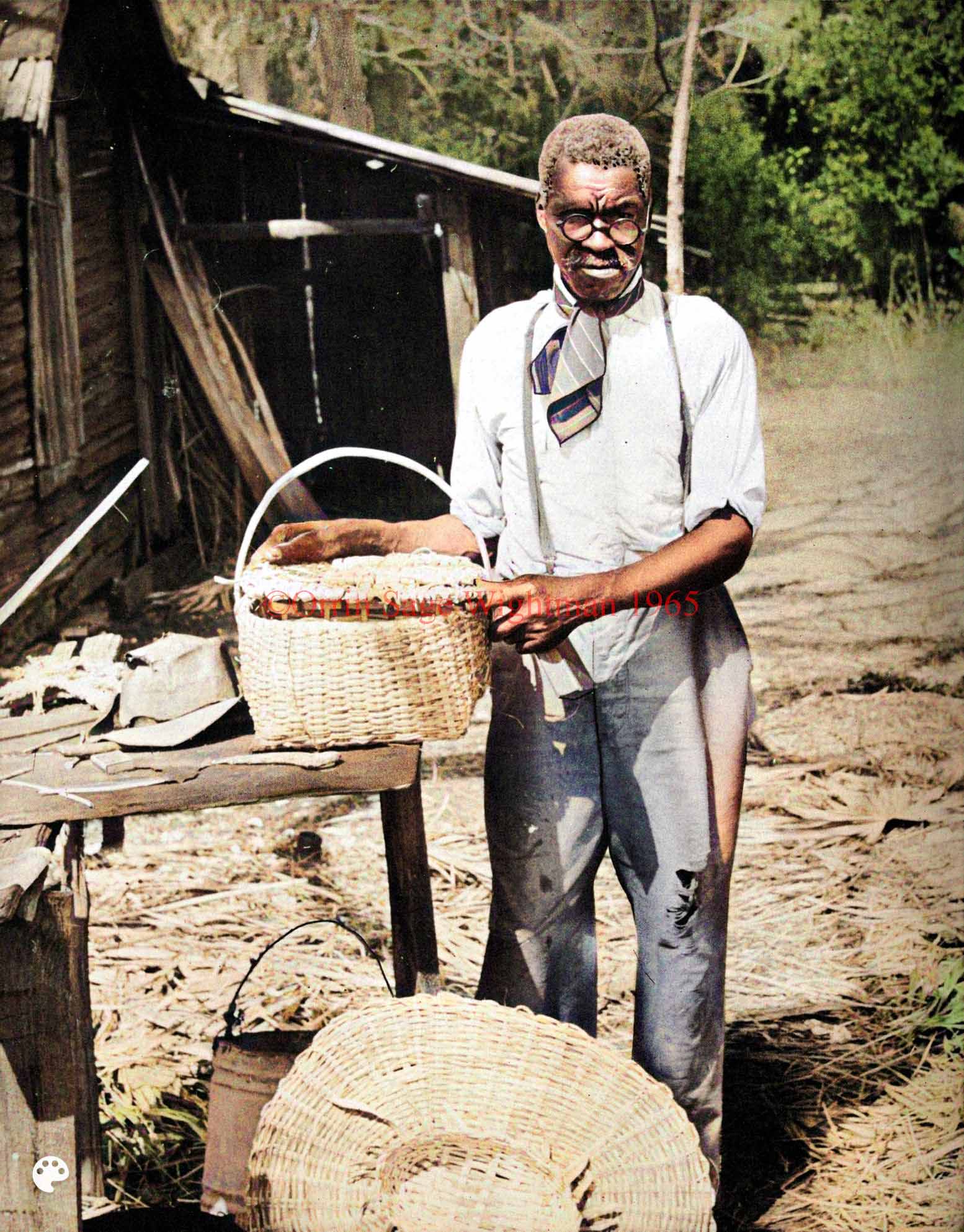
Pg. 159
Charles Wilson
Charles did all of his
cooking out of doors. He never made a fire in his house for he was
afraid it might burn down. He rigged up a fire bucket and across
the tope placed pieces of green wood or bricks and some iron bars to
hold his pot or frying pan. A piece of tin formed a screen to keep
the wind from blowing the fire.
He used a “Dutch oven” for baking bread or roasting
potatoes but said that a hoe cake cooked in the frying pan was as
good bread as any and that potatoes roasted in the ashes were better
than any other.
He always had a garden from which he got his
vegetables. His poultry flock supplied a pot of chicken quite often
and, when a ‘possum began to feast on his chickens, Charles
put the mother hen and her “biddies” in a basket and hung them up in
a tree, set a trap for the ‘possum, and Charles ate the
‘possum!
Charles had much trouble with his eyeglasses. He
wore the variety that would fit anyone and they were always falling
off. When the side pieces (bows) were broken he used wire to make a
new bow and, in order to insure against their falling off, eh bent
the wire into the shape of a ring which went over and around his
ear.
Generally the lens in his spectacles, one or both of
them, was cracked, even broken into many pieces, but he continued to
use them; and it did not seem to make much difference, for he looked
over the top of his glasses most of the time.
Charles was ingenious; he learned early in life
“ter mek what yer hab do!”
Pg. 160
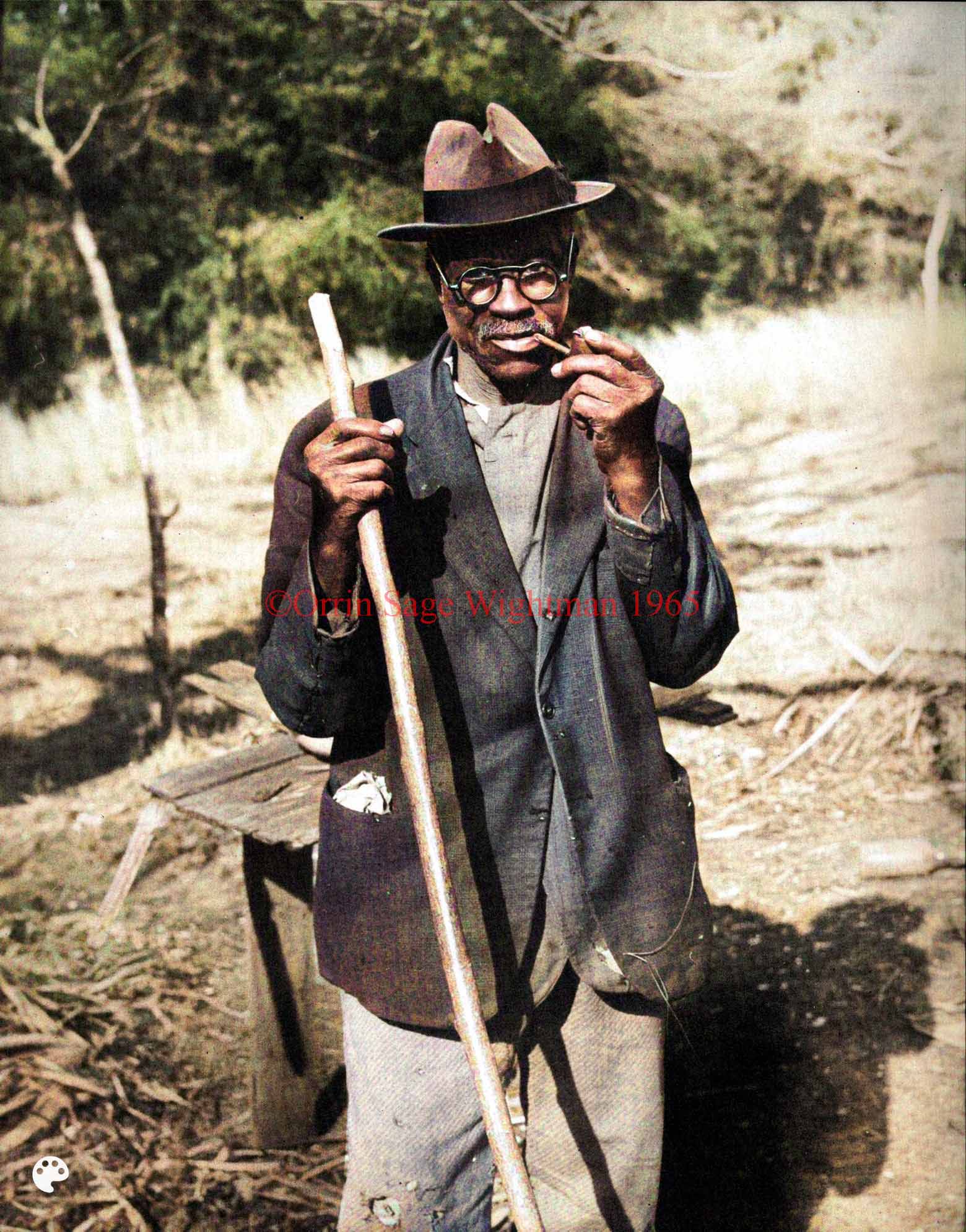
Pg. 161
Charles Wilson and His Pipe
Charles said that, when he
went out in the woods to gather palmetto leaves for making his
baskets, he always lost his pipe, so he never bothered with a
“boughten” pipe, but made his own. He gathered the tuberous root of
the briar (Smilax lanceolata of Florida smilax), dried
them, hollowed out the bowl and bored the hole of the stem. When
asked what he used for a stem, he replied, “Chicken leg bone make a
good pipe stem.”
Just as
Charles went to the woods to get the
material for his pipe, so he did for remedies to cure any ailment.
Around the door of his little cabin were various herbs, barks, and
berries, which he had gathered and hung to dry. He explained that
these were made into tea and told of the use to which each was put.
Tea from life everlasting was good for sore throat, that
from the berries of the saw palmetto would cure a cold in the head,
while sassafras tea was a good Spring tonic and would thin your
blood for the hot weather of Summer.
Growing in the yard were other plants which he believed
had medicinal value. The leaves of the castor oil bean (Palma
Christi) made a poultice that would cool the fever and the beans
could be pressed for the oil. To open up your head if you had a bad
cold, put a handful of mullein leaves in a tea pot of hot water and
breathe the steam from the spout.
His directions for the preparation of one of his best
remedies gives full instructions on some details but neglects
quantities: Take a handful of life everlasting, “blade and root,”
break it up and put it in the bottom of the pot. Sift some oak
ashes and put these ashes in a cloth bag, tie the bag and put it in
the pot on top of the life everlasting. Then take a handful of
snake root (You want more life everlasting than snake root.) and put
it in the pot. Next, chop some “fat light wood” (heart of long leaf
yellow pine) into splinters and add to the other things in the pot,
cover all this with water and boil “at a simmer” half a day. Strain
and drink this tea. Charles said this would cure the flu,
“crick” in the neck, cold on the chest, or fever!
Pg. 162
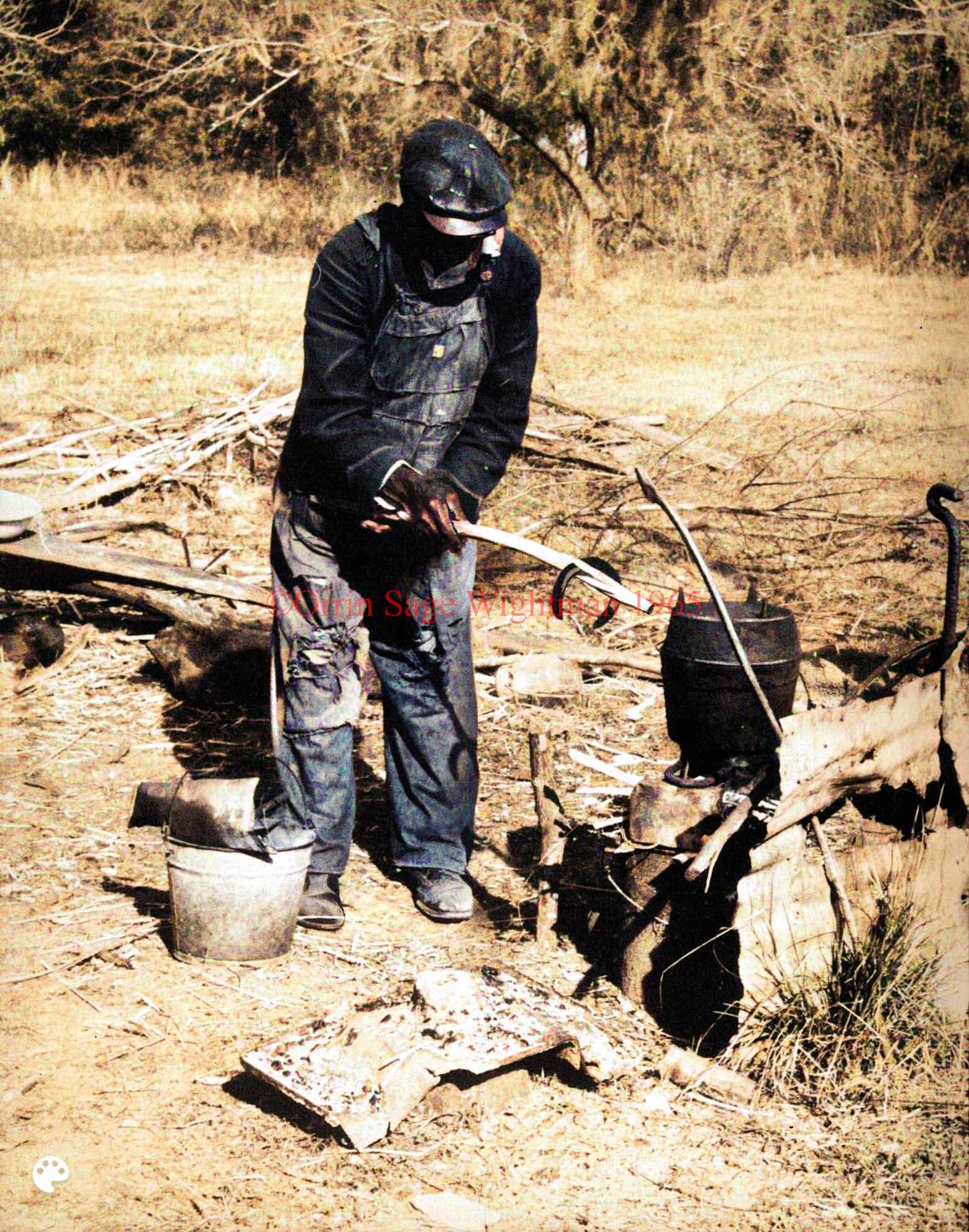
Pg. 163
Charles Wilson and His Horseshoe
Though
Charles cooked
out-of-doors, sometimes he had a fire when there was nothing
cooking!
In the foreground of this picture there is an iron door
from the oven of an old wood stove. In this Charles built a
fire to heat a horseshoe, believing if he kept the horseshoe hot the
hawk could not catch his chickens. In fact, if the horseshoe was
kept hot, the hawk could not close his talons on the chicken if he
caught it! Furthermore, even the smoke from this fire which heated
the horseshoe had special powers and no hawk could alight in a tree
if this smoke was blown through its branches.
Charles was very serious about this and believed
implicitly in the efficacy of the horseshoe. After many years of
burning, his horseshoe wore out and broke in two pieces. He was in
despair for he had young chickens that would be easy marks for the
hawk. Finally, he got another horseshoe, built a fire, heated it
and relaxed; his chickens were safe.
Of course
Charles lost sight of the fact that in
order to keep the horseshoe hot he had to stay out in the yard and
keep the fire burning; the hawk saw him and did not come around to
bother the chickens. But it worked!
Living alone and in a community of Negroes,
Charles
continued to practice these superstitions which he had learned from
his parents long after they had been discarded by other Negroes. He
was the last of the old Negroes to plant bene (Sesamum) at
the end of every row of cotton, corn, etc. in the field. Bene was
called the “good luck” plant and was said to bring a good crop.
When asked where he got his bene seed,
Charles
said he saved it; but when pressed to tell where he got his original
start, he said his parents always had it and he was told “Dey brung
it fum Africa.” He said the “old folks” gathered the seed to use in
cooking. They made bene cakes and, on special occasions, bene
candy. Also, it was ground in a mortar to extract the oil, which
was used as a shortening in the making of cake, oyster stew, or as a
butter substitute.
Pg. 164
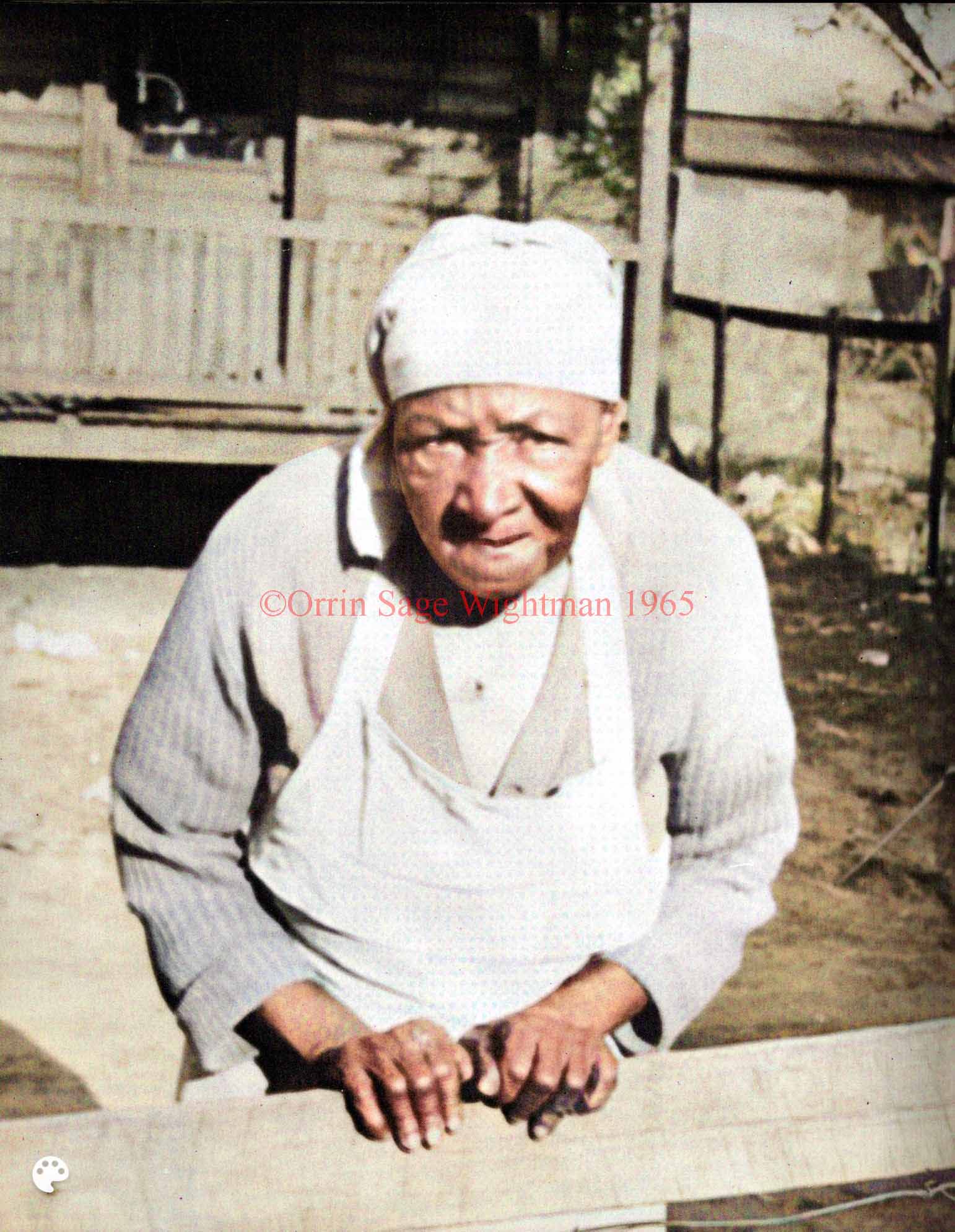
Pg. 165
Mary Williams
Mary’s parents belonged to
the Robert Hazlehurst family who owned Anguilla Plantation.
As Mary was born after “the War,” she was not a slave; but
she always proudly claimed she was “of the pure Hazlehurst
stock.”
Many years later, while her family was still living
there, Anguilla became the property of Hardee M. Stafford,
who built the old Anguilla house which became the Townsend
home. Mary adopted the new owners of Anguilla as her
“family” and, when the Staffords sold the plantation, she
moved to Brunswick. However, this did not sever the bond and she
continued to claim the protection of the Hazlehursts and the
Staffords—her “white folks.”
Anguilla Plantation, located on the mainland about
fourteen miles west of Brunswick, took its name from the famous Sea
Island cotton whose long silky fibres brought wealth to the
plantations of this area for a century. This was a Persian cotton
which had been developed in the British West Indies and was sent to
St. Simons Island from the Island of Anguilla. For many years it
was called “Anguilla Cotton”; later, it became known as Sea Island
cotton since it was believed that it would grow only on the sea
islands. However, the Hazlehursts, having planted it on
their plantation, proved that it would grow on the mainland as well
as the islands, and named the plantation Anguilla.
Anguilla and adjacent Marengo, the home of the
Nicolau family, were among the plantations served by Georgia’s
first Post Road and oldest highway. Waynesville, located near this
road, became a popular watering place in the 1830’s when planters
from the coastal area established summer homes there to escape the
“miasma” of the dreaded night air which was thought to cause malaria
fever. Beyond Waynesville and these Post Road plantations lay the
“pine barrens” of the section known as “Wiregrass Georgia,” with a
way of life in sharp contrast to the plantation life of the coast.
The Post Road marked the western boundary of this Coastal Culture.
Pg. 166

Pg. 167
Reverend Elijah J. Rozzell
Reverend Elijah J. Rozzell
has the distinction of having served one congregation for
fifty-eight years. In 1895, he became the pastor of the Mt. Olive
Baptist Church in Brunswick and continued in this capacity until his
feeble health necessitated his retirement. His gentle voice and
manner were what one would expect of his calling and his life and
work in this community earned for him the respect of all who knew
him.
Rozzell was not a local man and the story of his
coming to Brunswick is interesting. He, his father and other
members of his family, were among a group of 297 men, women and
children who arrived here on February 23, 1893. They came from
McCrory, Arkansas, having been prosperous farmers in Jackson, White
and Woodruff Counties in that State. Beguiled by the tale of an
unscrupulous man who promised to send them to Liberia, these people
sold their farms and livestock to secure the money for the trip.
Paying this man five dollars apiece for the voyage, they packed
their household goods for the train trip to Brunswick, where they
expected to board the vessel for Africa.
Arriving here, they found that the man had absconded
with their money and there was no ship awaiting them. Transplanted
into a strange community, with only their clothes, household goods,
and some food-stuffs which they had brought from their farms, the
presented a tragic picture. The people of Brunswick took them in
hand, provided shelter, and offered work. Turpentine and lumber
operators and farmers from all over South Georgia heard of them and
came to Brunswick to offer them homes and work. Many found
employment on the wharves which lined the harbor of Brunswick.
Today, the descendants of these Arkansas Negroes live throughout
this section and have proved themselves to be good citizens.
Pg. 168
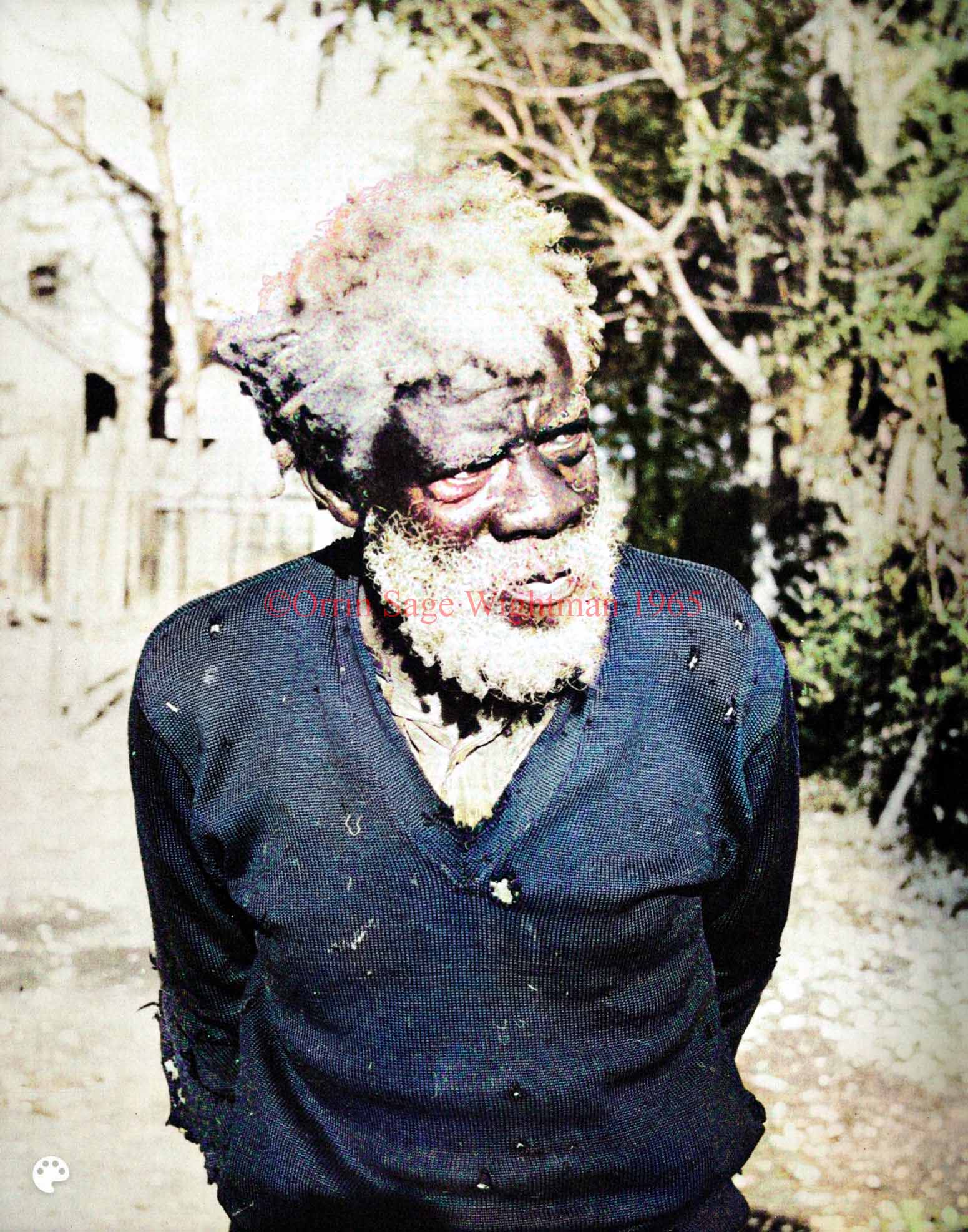
Pg. 169
Dan Hopkins
Dan Hopkins was born on
Cumberland Island “about ten years befo’ de war broke out.” He was
the property of Robert Church and after the war he came to
Brunswick where he lived with “Ole Missus” until she died. After
that he started in as a deck-hand, finally, working upt to the
position of engineer on the various steamers that made regular trips
from Brunswick to Darien and to St. Simons, Jekyll, and Cumberland
Islands. He worked on the Egmont, City of Brunswick, Hessie,
Attaquin, Emmeline and Atlantic.
In 1882 he was married to
Lena Carter of Sapelo
Island, the record of their marriage being carefully recorded in the
Bible of the bride’s family. Dan and Lena lived in
Brunswick where they owned a comfortable home in Dixville.
In his old age as
Dan’s mind became feeble, his
wife would not allow him to go on the street alone for fear he might
get hurt. They had a big yard where he spent much time, talking
over the fence with the neighbors and amusing himself for hours at a
time.
A visitor who called to see
Dan asked his wife
where he was and was informed, “He’s out in de yard.”
Then came the question, “What does he do in the yard?”
The wife’s answer was, “Oh, he picks up shells.”
“What does he do with shells?”
“He polishes ‘em off nice an’ clean, puts ‘em in his
pocket an’ brings ‘em in de house.”
“Then what do you do with them?”
Dan’s good old wife’s reply showed her
understanding heart: “I puts ‘em back in de yard so he kin pick ‘em
up agin.”
She apologized for the appearance of his hair, saying he
did not want his hair cut; and, if he did not want his hair cut, he
did no have to have it cut. That was his business! And we
agreed.
Pg. 170
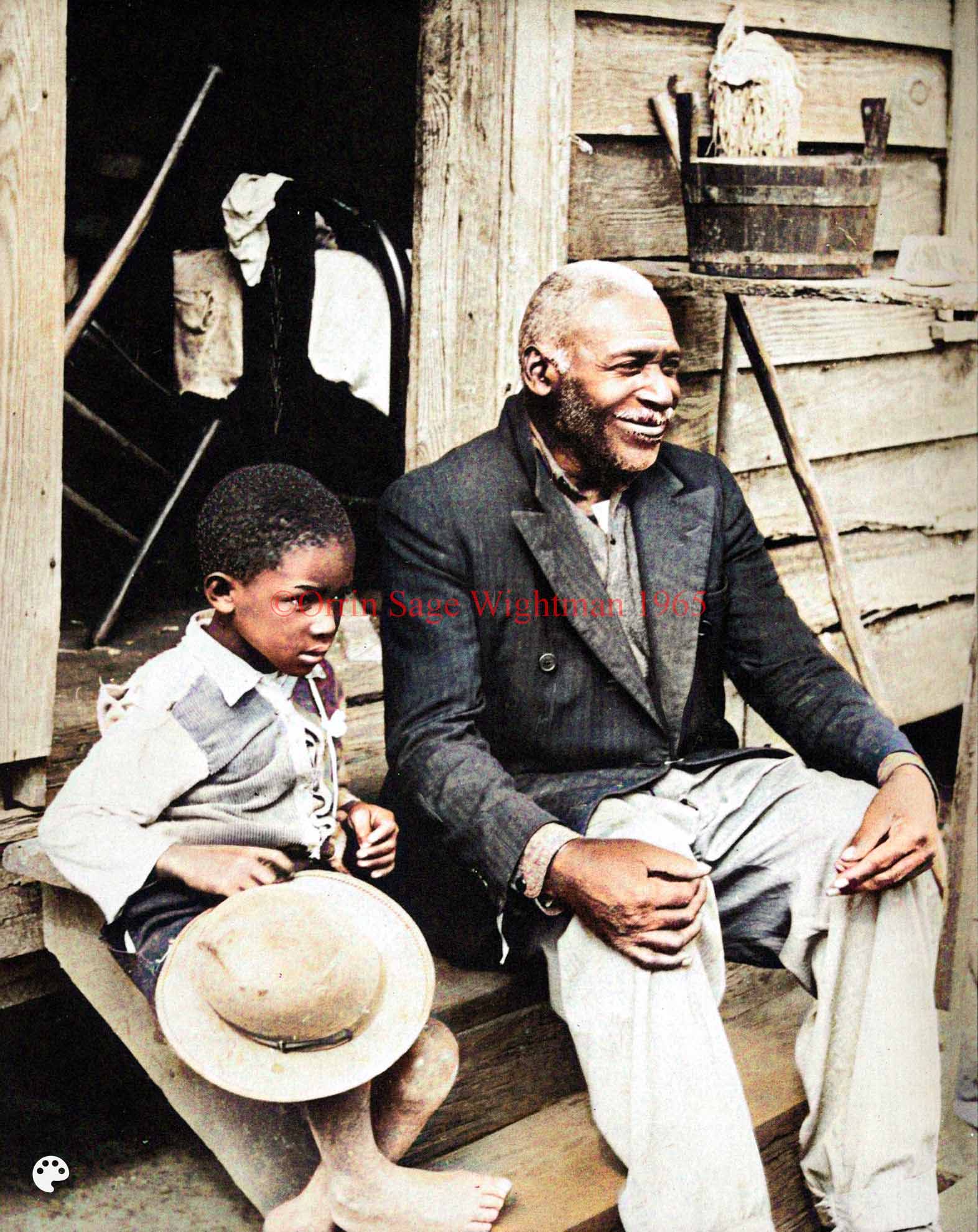
Pg. 171
Rufus McDonald
Rufus McDonald lived in the
Pennick section of Glynn County in a house that had belonged to his
wife who had been dead many y ears. When talking about the house he
referred to it as “heirs’ property,” meaning that it was not his
house but would go to the children of his wife by a previous
marriage.
Here, near the kitchen door, were the hoe and the mop,
while the wooden tub held the supply of water within easy reach of
the kitchen, with the water dipper and a bar of Octagon soap nearby.
Rufus lived to be eighty hears old and in his
last illness he said, “I won’t be here much longer, but I ain’t
tired o’ being here yet!”
Rufus looked like “Uncle Remus” and it seems
entirely proper that there should be a child in the picture with
him. No doubt he was Uncle Remus to this child and told him
the old stories which the Negroes brought from Africa and which have
been handed down from generation to generation. Joel Chandler
Harris preserved the folk tales of the Middle Georgia Negro
while here on the coast where the dialect is entirely different,
these old African tales were collected and published about a quarter
of a century after the war by Georgia’s eminent historian, Charles Colcock Jones, Jr., under the title,
Negro Myths from
the Georgia Coast.
This little boy was one of the “heirs” who would claim
the property when Rufus was gone. While playing around in
the yard, this child, like all people who live much in the open, was
quick to notice the new moon which had appeared in the western sky.
Turning to look at it, he clasped his hands in an attitude of prayer
and said, “God bless the new moon!”
Pg. 172
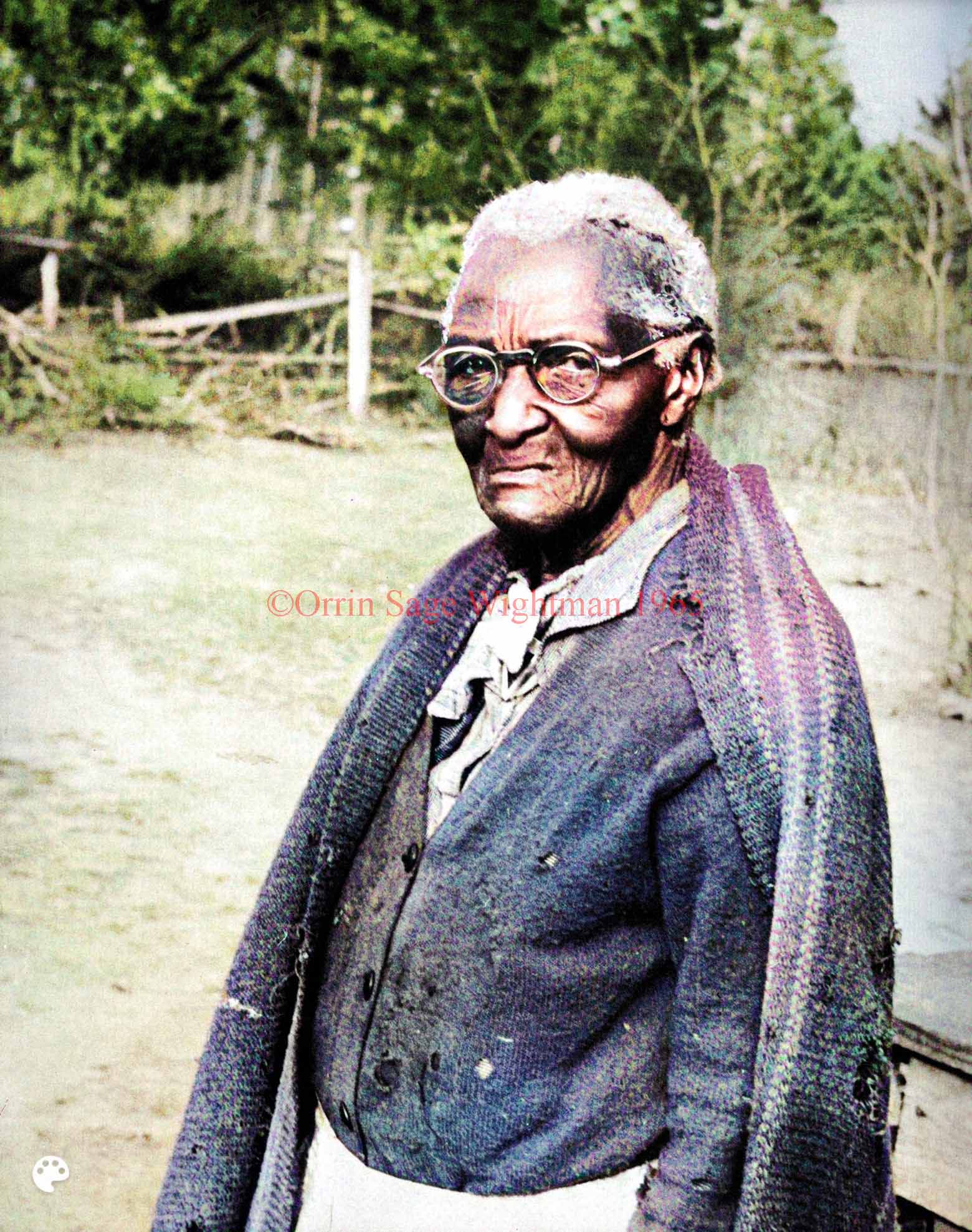
Pg. 173
Ella Pinkney
Ella Pinkney, whose years
rounded out a century, was very proud of the fact that she ha been a
house servant. When asked her age, she dated herself with the
statement that she was a big girl waiting on the table at Mr.
Berrie’s house “When freedom come,” which was her way of
referring to the emancipation of the Negro.
Ella’s pride in having been a house servant was
typical of the attitude of slaves of the plantations. Among them
there was a definite caste system, headed by the house servants—the
butler, cook, maids, and children’s nurses—and the artisans—the
carpenter, blacksmith, seamstress, and nurses for the sick—who
looked down on the “field hands.” The Negroes trained for these
special positions were chosen because of their superior
intelligence. Many of these were Senegalese, who had a strong
Arabic strain in their ancestry and were considered the most
intelligent of the African tribes and, therefore, especially desired
as house servants and craftsmen.
As would be expected for one of her great age, sometimes
Ella was not well and had to stay in bed. On such an
occasion she told a visitor, “De han’ ob de Lord is on me, so I jus’
keep quiet till He lif’s it.”
Her little vegetable garden with its straight rows, free
of grass and weeds, brought forth the question, “Ella, who
made your garden?”
“I made my own garden,” she said.
The visitor protested, “But,
Ella, you’ve just
been telling me about the misery in your back.”
Ella’s reply expressed her wonderful philosophy
of life: “O missus, yer got to resis’ yer fellin’s!”
Pg. 174
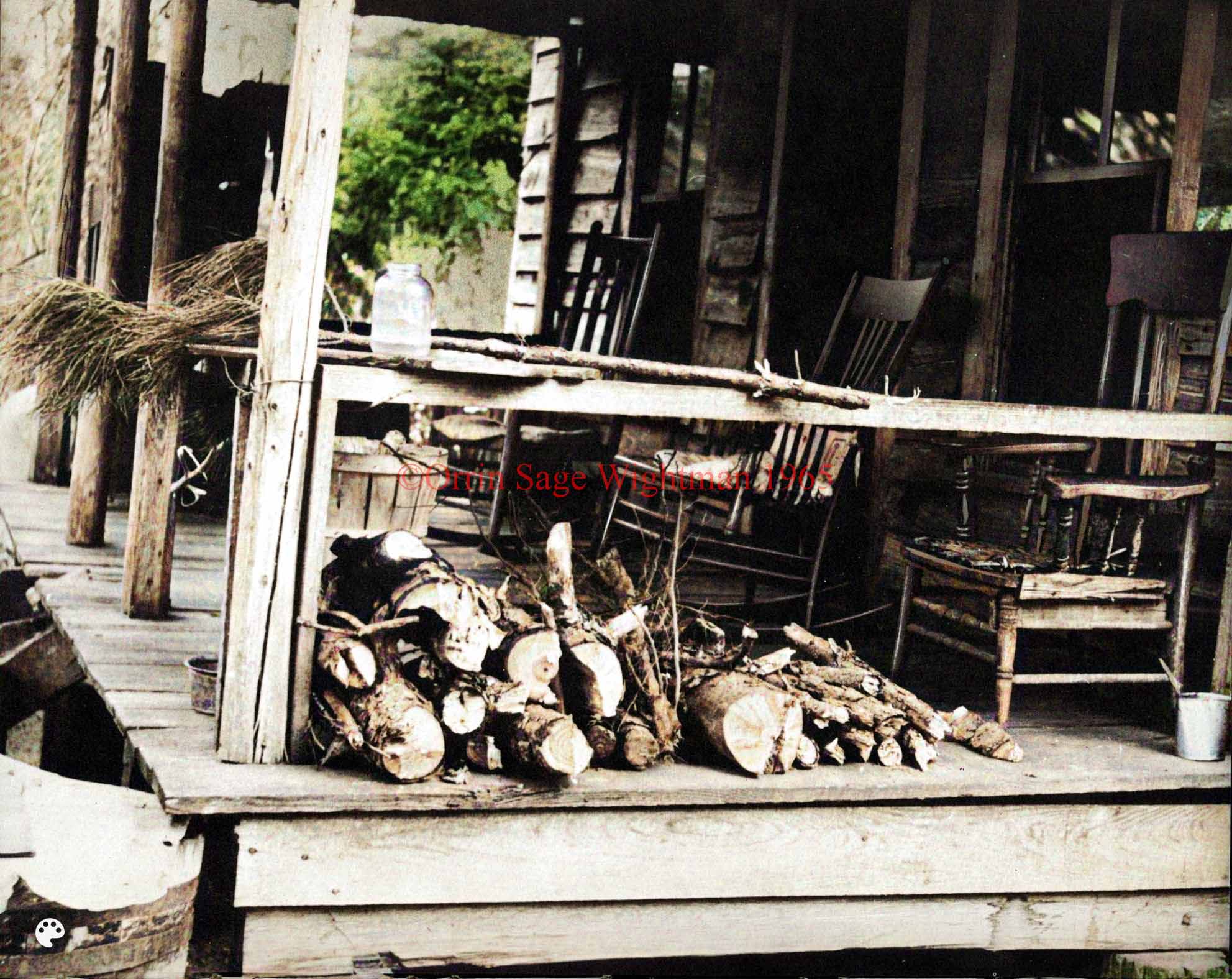
Pg. 175
Ella Pinkney’s Front Porch
Ella’s plan of living was
reduced to a simple formula and life centered on her front porch.
Here she could sit and see who passed by on the road. If she had
company, there were chairs for them also; if she wanted wood for the
fireplace in the house, she did not have to go out in the yard to
get the wood. The wash-tub was here, too, so that she could do the
washing and still not miss the passerby.
The brush broom with which
Ella swept her yard
was lying on the banisters. Negroes always sweep their yards and
never allow grass to grow in any part of them. Having fought to
keep grass out of their fields, they want one of it in their front
yards either.
The arrangement of the flowers in their front yards
followed the pattern of the plantation garden, though on a greatly
reduced scale. The walks and designs for small flower beds were
outlined with sea shells. These designs were small circles or
diamond-shaped beds balanced on either side of the walk which led
from the gate to the front steps.
In these circles or diamond-shaped beds were the cap
Jessamine, ribbon cane, moss or cabbage roses, japonicas, crepe
myrtle, oleander, hydrangea, spirea, spider lily, and other flowers
which they had gotten from their “white folks.” The beds and walks
were bordered with violets, hearts’-ease, snow drop, jonquil, and
narcissus, and everywhere was clean white sand to be swept with the
brush broom.
These Negro houses were built a foot or two off the
ground and rested on wooden blocks or brick pillars. This allowed
circulation of air under the house which was insurance against
termites, besides providing a storage place for many odds and ends!
Pg. 176

Pg. 177
Salem Baptist Church
This Negro Baptist Church located
near Sterling serves the Negro population for many miles around.
Its congregation is made up of families of former slaves from the
various plantations nearby, many of them being from the rice
fields. Up until the organization of this Salem Baptist Church,
these Negroes had worshipped in the Broadfield Baptist Church; but
in 1874 eighty-four members of the Broadfield Church asked for
letters of dismissal from their old church and organized the new
Salem Church.
The Baptist Church is very popular among the Coastal
Georgia Negroes to whom the baptismal ceremony is an important
event. Though most modern churches have pools built into the
building, the time-honored custom of the early churches was to
baptize in the river.
Marching from the church and singing as they marched,
the entire congregation formed the procession. Led by the minister
and the deacons and followed by the candidates robed in white, the
group proceeded to the bluff where the ceremony was to take place.
The deacons and the minister walked cautiously into the water,
measuring the depth with a staff and picking out a safe place for
the baptism. This was carefully timed so as to take place at “high
water” just after the tide had turned and was on the ebb, for the
water must be going out in order to take away the sins of the newly
baptized members. If the tide had not turned, the water might bring
the sins back and it was important that they be carried away by the
outgoing tide.
For a half century after it was built this building went
unpainted. Then the members found the money to paint the front, and
for a quarter of a century it stood with only that part of the
building painted. Being a thrifty people and knowing how hard it is
to pay a debt, they hesitated to obligate themselves. A visitor
hearing their story and admiring the spirit of the people who could
do without that which they could not afford, gave the paint for the
entire building and the members did the work themselves. This new
coat of paint called for other improvements and repairs, so that now
in the last quarter of its first century this old building has taken
on new life.
Pg. 178
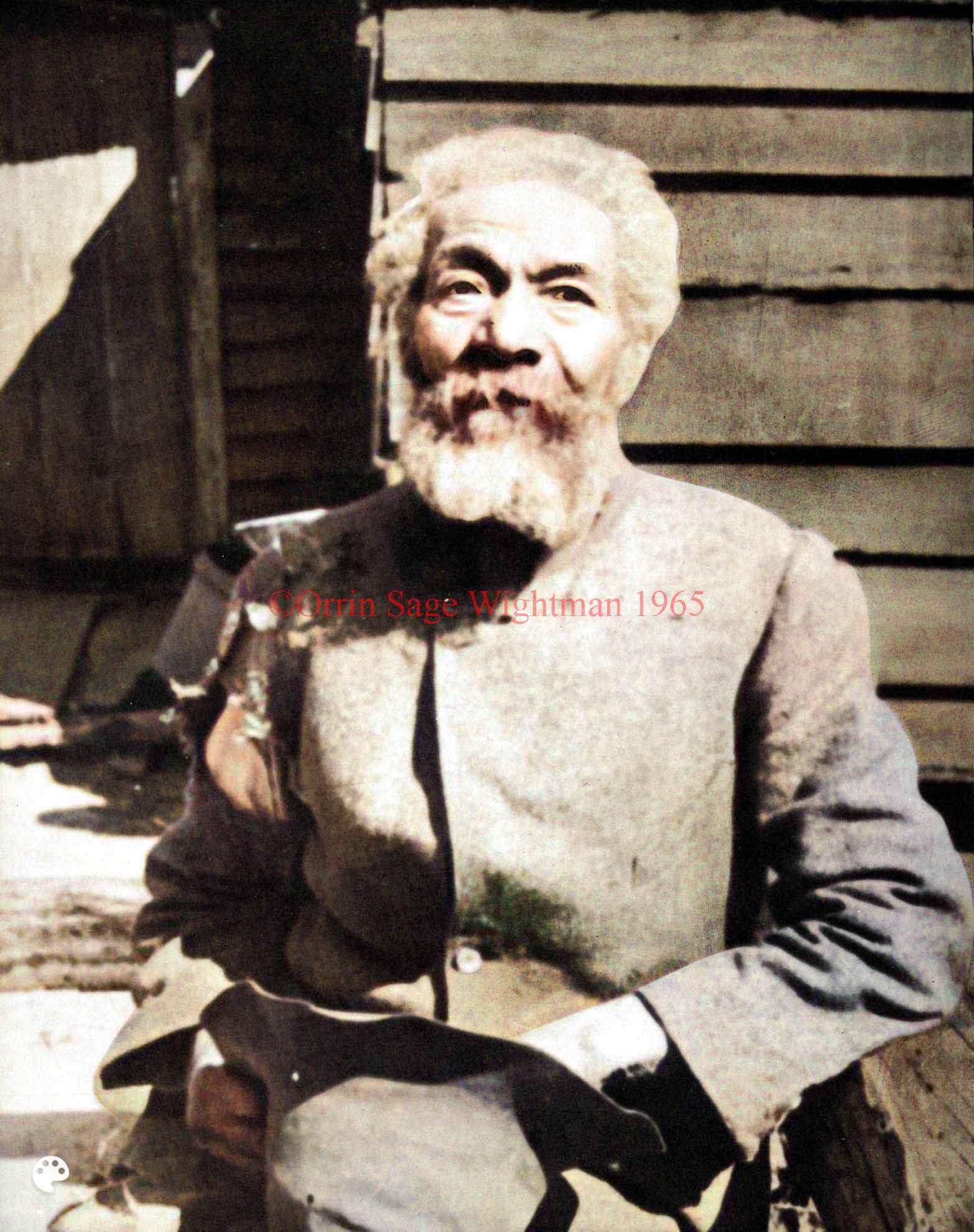
Pg. 179
Charles Alexander
Charles Alexander was born
at Butler Point on St. Simons Island the first year of “the War.”
Since he was born before the emancipation of the Negro, he always
said he was born a salve even though he knew nothing of slavery.
His mother,
Minta, belonged to the Butlers
and Charles said she lived for a time in Philadelphia, where
the Butlers had one of the finest residences in that city.
Speaking of her, Charles said she was a “valuesome” woman.
One of his brothers bore the name of their old master,
being named Pierce Butler Alexander, and Charles had a
grandson with the same name; however, they wrote it as they spoke
it, “Pace Butler Alexander.”
Charles had gone to school when he was young; he
said he went through the blueback speller four times. He was one of
a large family of children, all of whom were outstanding in the
community in which they lived.
His brother,
John Ellison Alexander, worked out a
unique method of keeping up with the days of the week. He nailed
seven nails in a row and moved a looped wire from nail to nail for
each new day. When he reached the last nail in the row the looped
wire was then moved back to the first nail and a new week was
ushered in.
These men had a sister who became a deaconess of the
Episcopal Church and operated a school in their neighborhood, a
settlement known as Pennick. Deaconess Alexander earned and
held the respect of all who knew her. Her influence for good in the
lives of the children who came under her guidance is her monument.
Pg. 180
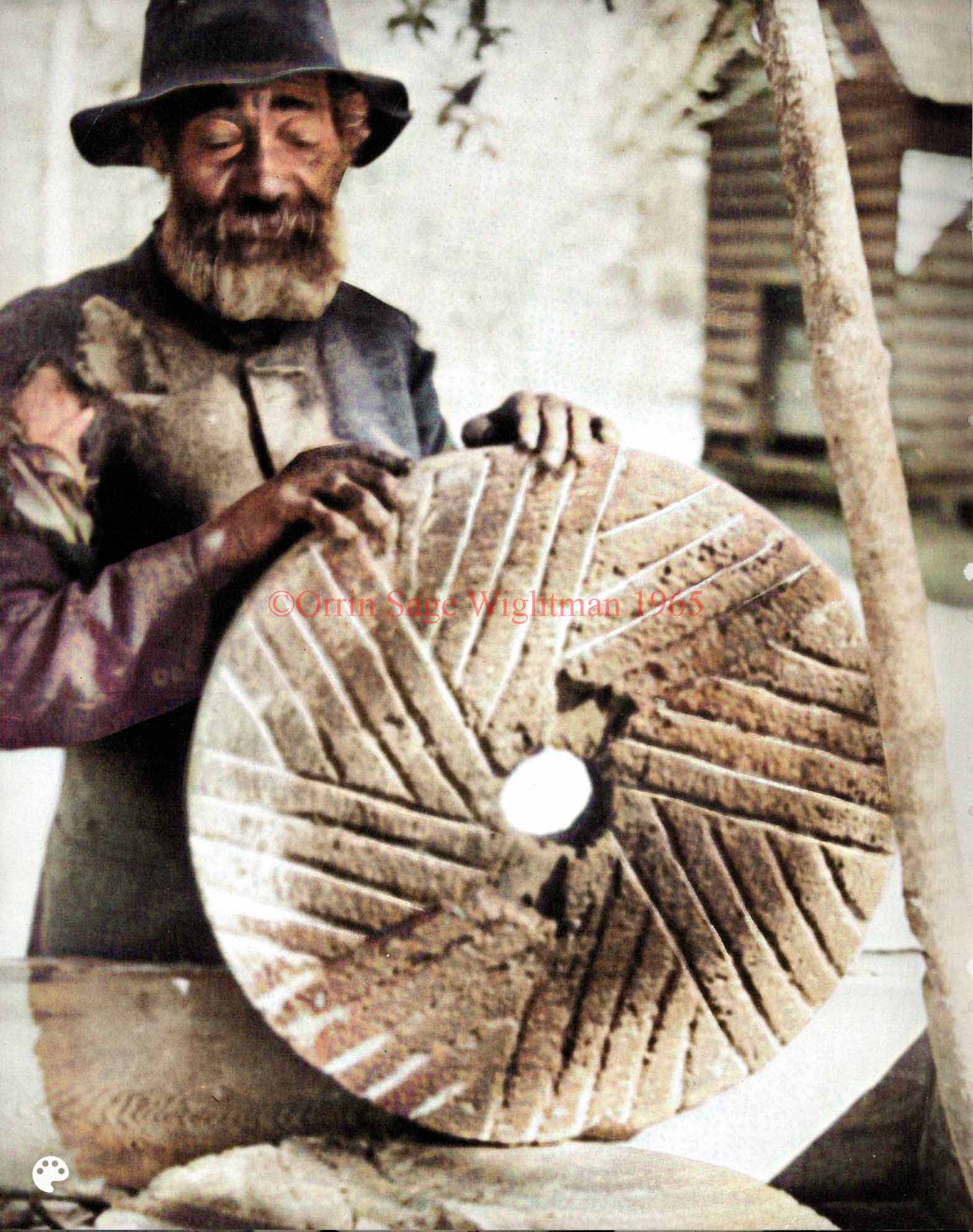
Pg. 181
Charles Alexander’s Mill
This old mill had been used by four
generations of Charles Alexander’s family to grind corn into
meal and grits. He explained, however, that he did not use it any
more for now he bought his meal and grits at the store.
This mill was made of two round stones about two feet in
diameter and four inches thick. The lower, or nether stone was
fixed in the box which housed the mill, while the upper stone, known
as the “runner,” was turned on the nether stone.
The inside surfaces of these stones were cut with
grooves or “furrows.” In such mill stones the pattern of these
furrows varied greatly but always the furrows were arranged so that
they threw the ground grain out into the box from which it was
collected.
The smooth surface of the stones between the furrows was
known as the “land.”
The grain to be ground was poured into the “eye” or hole
in the center of the runner, while the oblong depression in the
middle and around the eye of this upper stone, or runner, was called
the “bosom” and was made to hold the “frog,” which held the two
stones apart and made it possible to turn the runner on the nether
stone.
A long pole, which went through a hole in the horizontal
timber above the mill and rested in a socket near the outside edge
of the runner, was used to turn the stone. Two people, standing on
opposite sides of the mill, grasped the pole and turned the runner.
Here,
Charles is showing the inner surface of the
runner, the furrows of which make a pleasing design.
Pg. 182
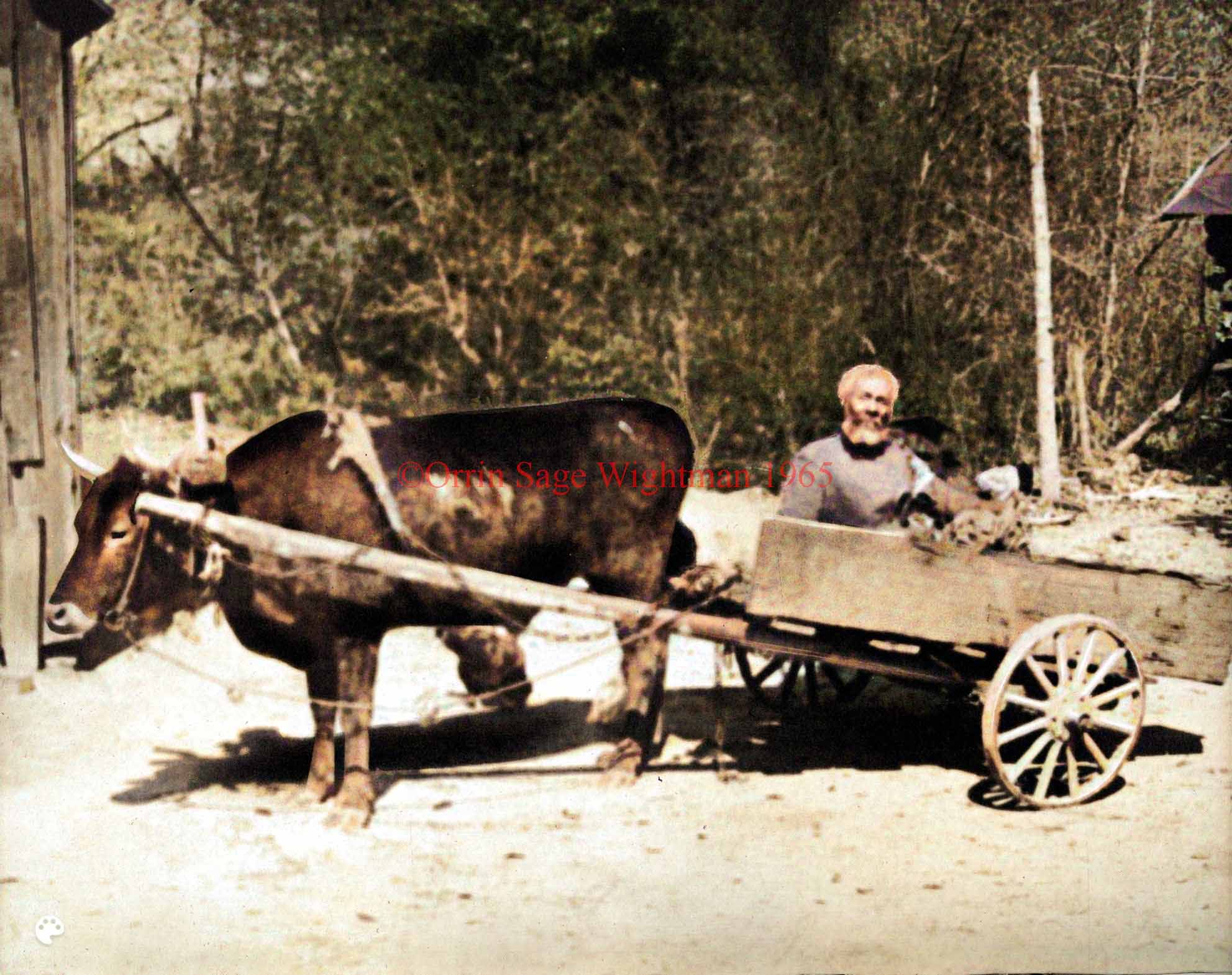
Pg. 183
Charles Alexander’s Ox Cart
Seeing the cart in the yard at
Alexander’s home in the Pennick section of Glynn County, the
visitor inquired, “Charles, do you have a critter?” (A
critter being a horse, a mule, an ox, or anything that does the
work.”
The reply was, “Yas’m, I got a critter.” He then got
his critter out of the woods and hitched it to his cart to show how
he would ride down the road to the store. He said it took all day,
but it was better than walking! We wondered.
Some of the harness was crocus sack and did not look
very substantial; but perhaps it was safe, for it did not seem
probably that this steed would have any inclination to run away!
Though
Charles used a yoke to hitch up his ox, he
“drove” with plow lines as reins instead of guiding his ox with the
“gee” and “haw” commonly used for such animals.
The small wheels put the cart close to the ground and
made it easy for Charles to crawl into the cart for his slow
ride down the road. Evidently he was like the man who told his son
to ride always and never walk if he could help it: “Ride a
horse if you can get it; if you can’t get a horse, ride a mule; if
you can’t get a mule, ride an ox—but ride!”
Pg. 184
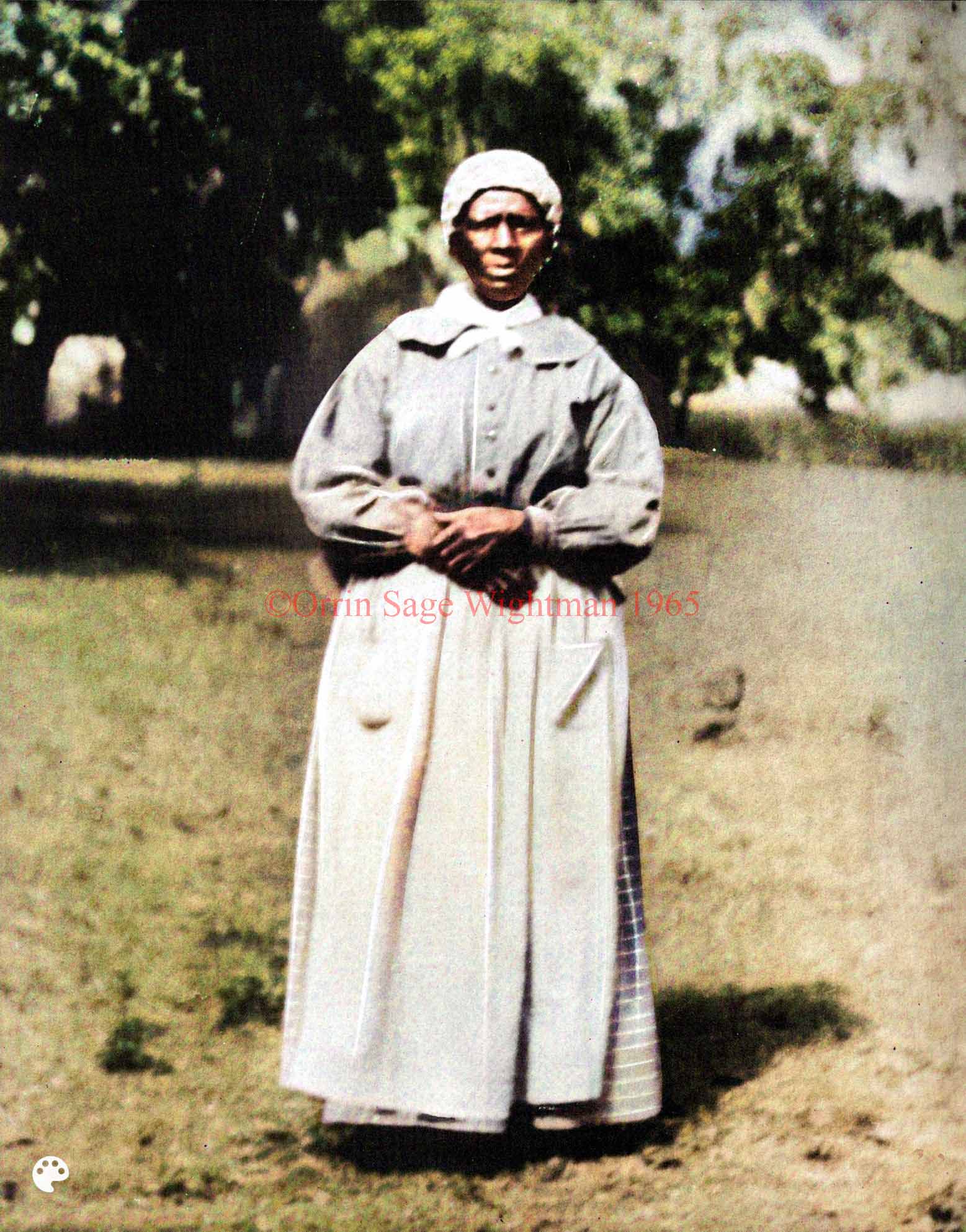
Pg. 185
Tyrah Wilson
Tyrah Wilson was the
mantuamaker of Mrs. George C. Dent, nee Ophelia Troup,
of Hofwyl Plantation. Trained as a seamstress, Tyrah was in
charge of the sewing room and of a group of women who worked under
her direction and whose task it was to make the clothes for the
Negroes of the plantation. Measuring and cutting the cloth under
the direction of the mistress of the plantation, the sewing room
workers were a busy group.
Old plantation record books are filled with individual
entries that tell of the purchases of supplies for this department,
such as ten pounds of thread, one hundred needles, and hundreds of
yards of Osnaburg, grey cloth, Kersey, and linsey Woolsey, as well
as homespun, linen drill, and bleached shirting.
This old picture shows the correct dress of a house
servant of the plantation. The gingham dress consists of a shirt
waist with long sleeves and high neck finished with a collar, while
the skirt is ankle-length and made of several widths of cloth
gathered to the waist band.
The white apron, with two big pockets, covers the front
and reaches almost to the bottom of the skirt. In these pockets, no
doubt, Tyrah carries the keys to her work rooms since she
would be responsible for the materials kept there. Keys were
considered a badge of authority and the person who carried them was
a trusted servant.
The kerchief at her neck and the cap on her head
complete this perfect picture of an old-time servant.
The pride in her bearing tells of her knowledge that, in
the world in which she moves, she is a person of importance.
Pg. 186
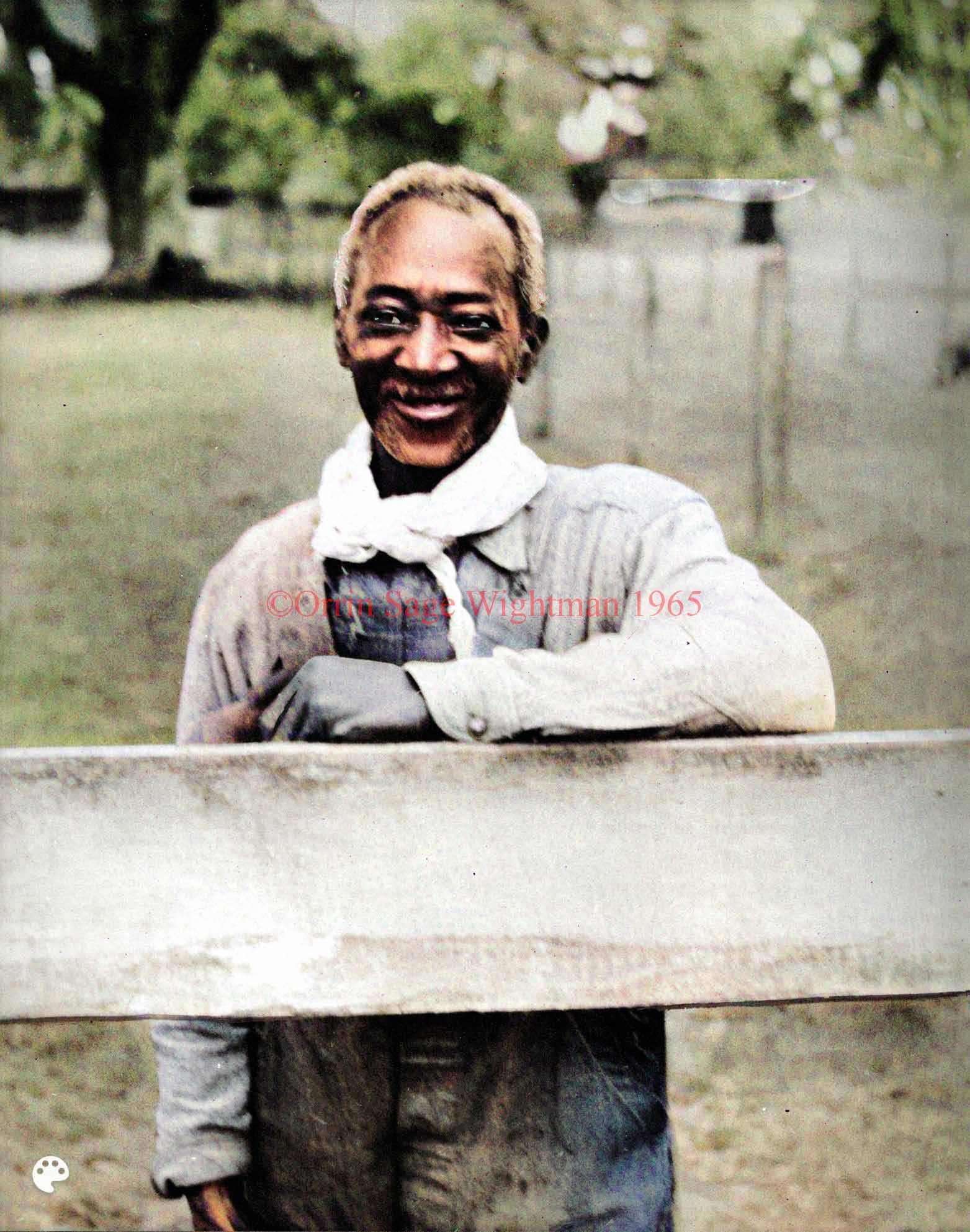
Pg. 187
Morris Polite
From the time he was old enough to
work until his death at the age of eight, Morris Polite
worked on Hofwyl Plantation and for three generations of one
family. At his funeral the preacher commented on this saying, “That
speaks well for Morris and speaks well for the family, too!”
As far back as anyone knows this
Polite family
has belonged to Hofwyl Plantation or Broadfield Plantation, Hofwyl
having once been a part of Broadfield. Since “the War” Morris’
grandfather, his father, Morris, his sons, and his
grandsons—five generations—have worked on this same plantation where
their slave ancestors toiled.
Morris lived in a settlement known as
Petersville, which was formerly a part of the Broadfield-Hofwyl
tract. Here he owned a small plot of ground where he built a modest
cottage in which he and his wife, Joan, raised a family of
thirteen children. In this Petersville settlement many of Morris’ children, grandchildren and great-grandchildren still
live; so that, slave and freedman, the members of this family have
lived in an area not more than two miles square for about a century
and a half.
This family of Negroes still live up to the reputation
of their ancestor who took the name “Polite” after the
emancipation of the Negro. Morris’ grandfather, who adopted
the name, was noted for his politeness. Of him it was said, “He
always had his hat in his hand and was bowing and scraping.”
Morris’ features show his descent from those
African tribes who had superior intelligence, being of the group who
were trained as house servants or for specialized work—never as
field hands.
Pg. 188
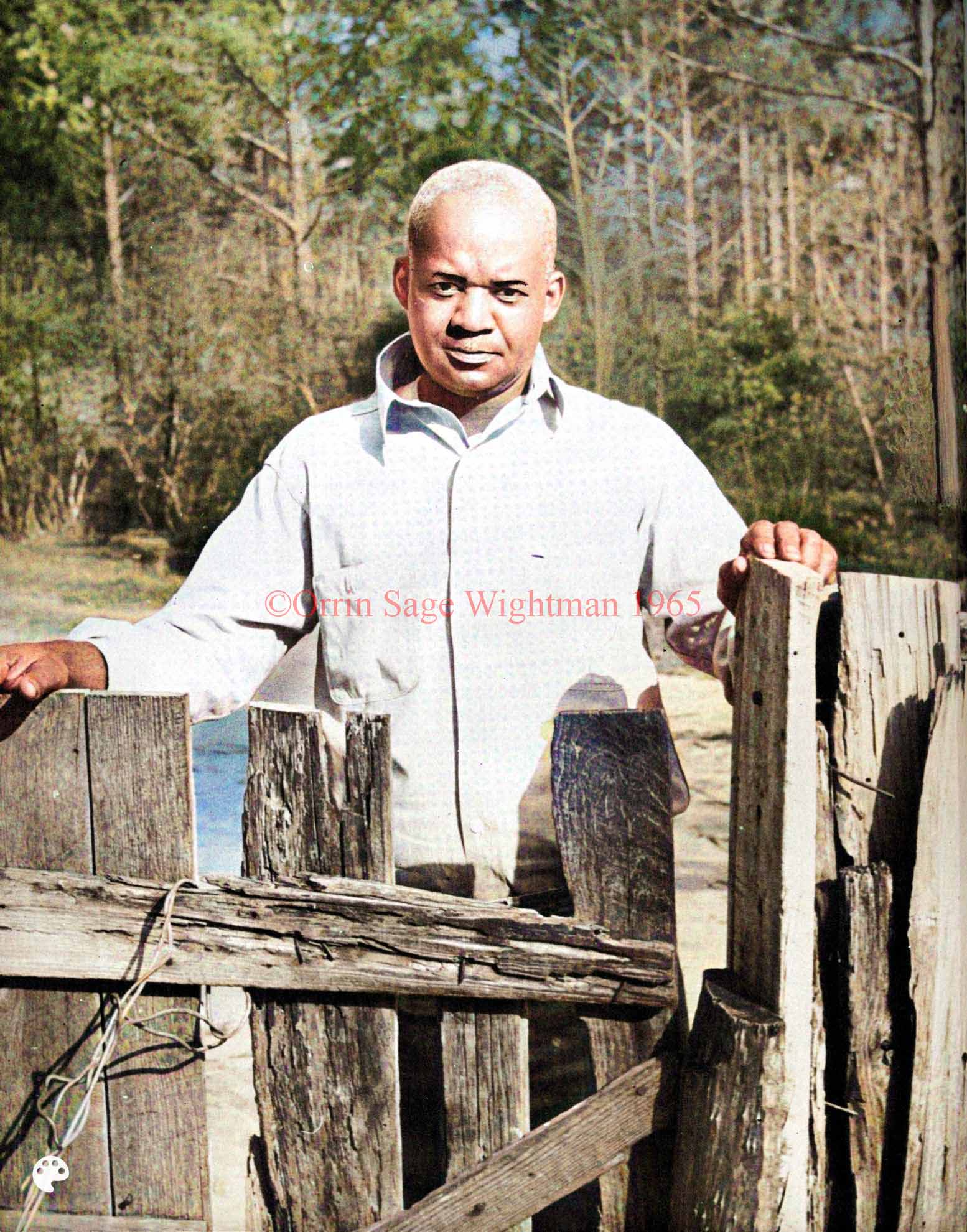
Pg. 189
London Polite
London was Morris’
oldest son and in many ways was like his father. However, Morris
was sober and sedate while London always found something to
laugh about. His happy disposition made him a favorite with
children who liked nothing better than to be with him.
London had charge of the Cate farm,
Touchstone Ridge, for twenty-six years and was a faithful, loyal
servant. His wife, Mamie, was sick for a long time and he
attended her every need to the very end.
When
Mamie died, London was discussing
affairs with the “Missus” who asked, “London, have you ever
been married before?”
“Oh yes, Missus, I got a wife right here in Brunswick.”
“Oh! Then you were divorced.”
His reply was a trifle startling for he said, “Missus,
de guvment ‘vorce me.”
His “Missus” asked, “Well,
London, how was that?”
London’s reply was a full explanation: “Well,
you know, Missus, I was drafted in de fust World War an’ dey tol’ me
ef I wuz libin’ wid her dey wouldn’t sen’ me to France; an’ I tol’
dem dey could sen’ me to war, I wouldn’t lib wid dat woman no mo’.
Dey didn’t gib her none o’ my ‘lotment and dat wuz all de same as a
‘vorce!”
The Missus’ reply, “O, yes!” might have seemed slightly
skeptical to London, for he further bolstered his defense
with this statement:
“But, Missus, dat wouldn’t uh made no diffunt. I
married her in Darien an’ I married Mamie in Brumsick!”
Pg. 190
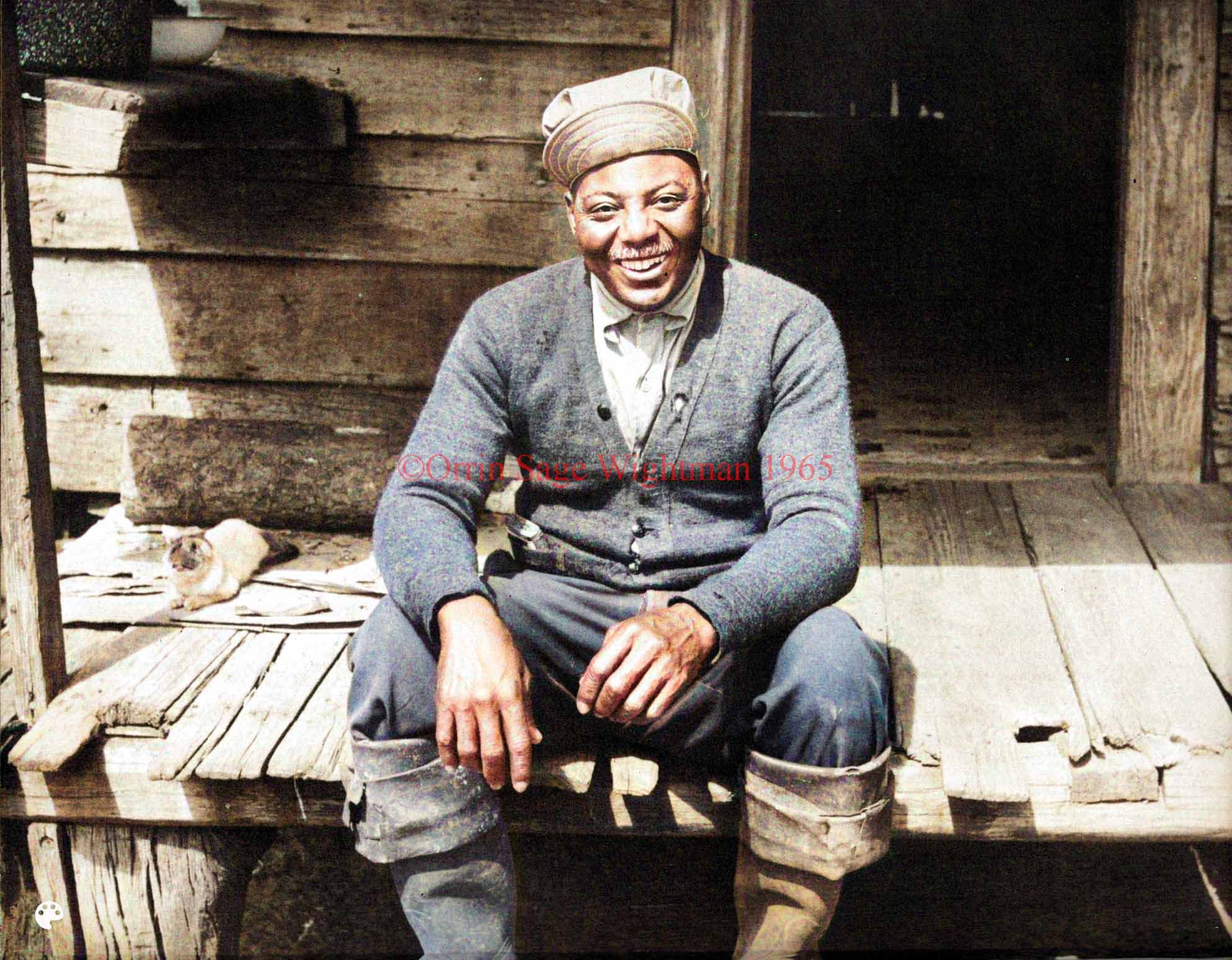
Pg. 191
Jerry Harris
For a man to live his life in one
community, to raise a large family and send his children through
high school, to operate his own business, to use his influence for
good, and to become a leader in his community, thus, earning the
respect of his fellowman, is all that could be expected of
anyone—and Jerry Harris had done all of these. One would
think that all this would be sufficient to say about Jerry
but something else could be added: in addition, he has a happy
disposition and so has his wife, Leola, the daughter of Morris Polite.
Like the
Polite family, Jerry’s ancestors
belonged to the Broadfield-Hofwyl Plantation. He, too, lives in
Petersville and can claim the same distinction that goes to the Polite family in that all the generations of his family who have
lived in America, as far back as anyone knows, have spent their
lives in this small area. In fact, there are no “displaced” persons
in Petersville; all of them belong there.
After the Civil War the Negroes who had lived on the
Glynn County rice plantations located on the south bank of the
Altamaha River—Hopeton, Altama, Elizafield, Evelyn, Grantly,
Broadfield, Hofwyl and New Hope—settled themselves in communities
nearby. Here, they acquired small tracts of land, built their
little cabins and continued to work on the same plantations where
they had labored as slaves.
Petersville was one of these communities, having taken
its name from an old man named Peter who lived there.
Another settlement was Needwood, so named because of a shortage of
“fat lighter wood” (heart of the long-leaf yellow pine). Still
another such community bore a name which needs no explanation,
Freedman’s Rest!
Pg. 192
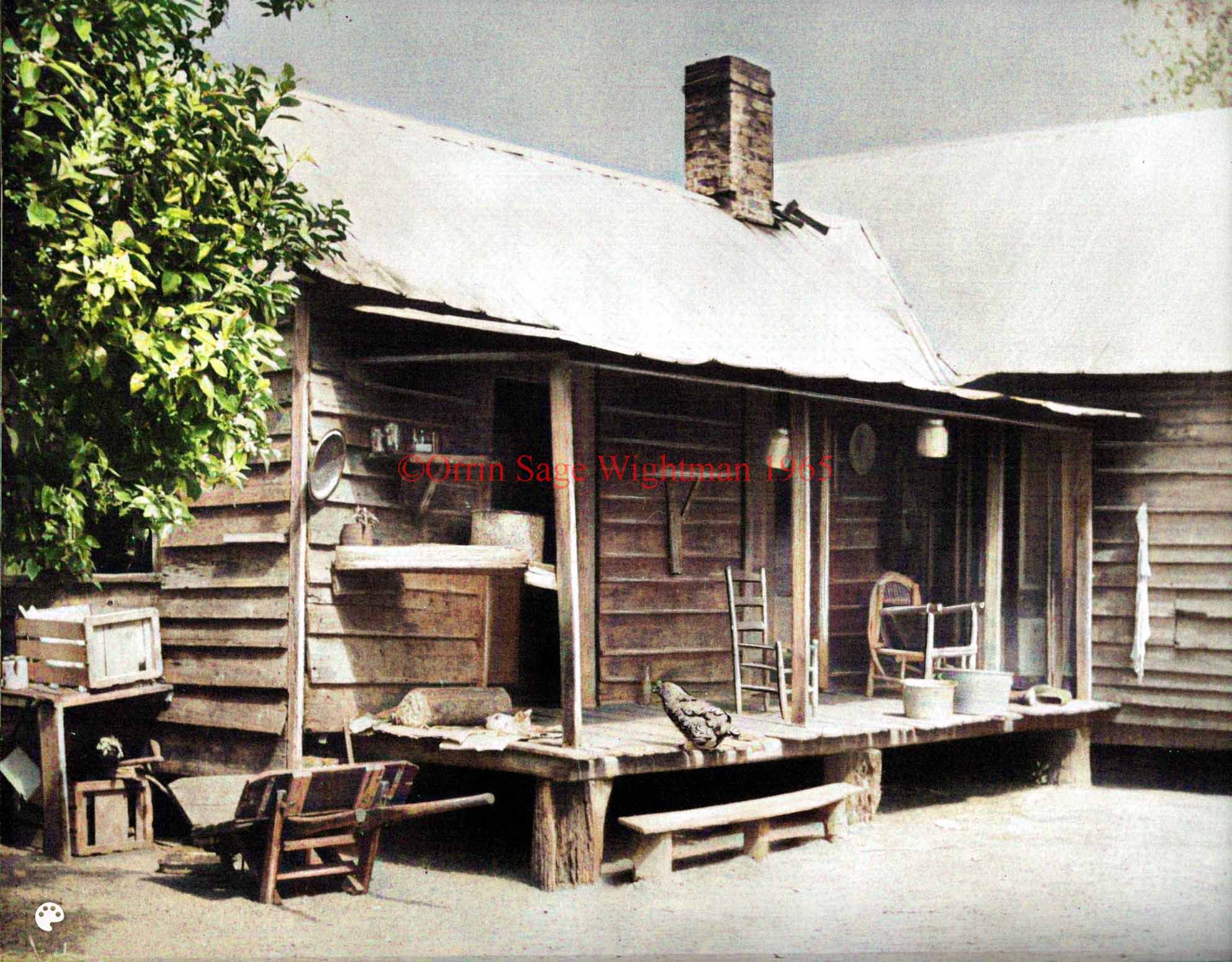
Pg. 193
Jerry Harris’ Back Porch
This house has seen a lot of
living, for here Jerry Harris and his wife, Leola (Polite)
Harris, have raised a large family. This picture speaks of
their way of life.
The milk cans are hung within easy reach for their trip
to the barn, wash tubs are placed at a good height, and chairs await
the worker who has time for resting. On the shelf at the end of the
porch sits a large pot, the lid hanging nearby. The wheelbarrow
stands where its load of wood was discharged and the cat sleeps
contentedly in the patch of sunshine.
Through the open door of the kitchen can be seen the
kitchen cabinet, while the electric refrigerator stands just
beyond. The absence of a pump or a bucket of water tells you that
this house uses water from an artesian well, which is pipe into the
kitchen.
The box on a shelf just outside the kitchen window has
in it a nest to which the chicken that has just hopped up on the
porch is making her third trip. She first flew up on the porch,
walked into the kitchen, hopped up into the window and down into the
box. Finding something not to her liking, she flew to the ground,
then hopped back up on the porch, into the kitchen, up into the
window, down into the box and out again. On this third trip she
seems satisfied to settle down on the next and get on with her work
of laying an egg.
The beautiful sour orange tree shading the kitchen,
gives a delightful fragrance when in bloom and furnishes fruit for
drinks and for marmalade. Leola’s love of growing plants and
flowers is seen in the “cutting” which is being rooted in the tin
can on the shelf.
Pg. 194
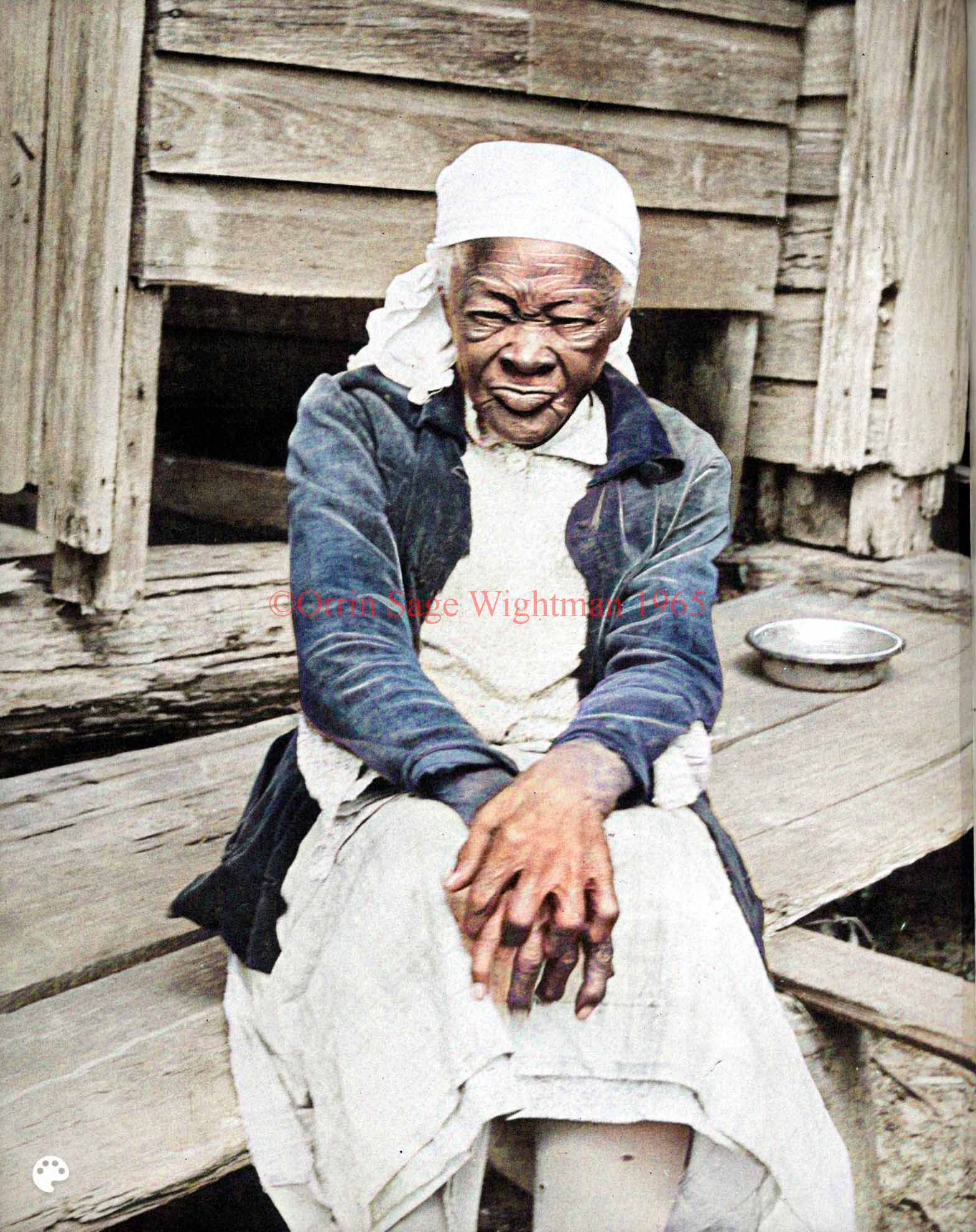
Pg. 195
Sibby Kelly
Old
Sibby Kelly was a
“granny woman,” or midwife, who lived in a Negro settlement known as
Petersville, about fifteen miles from Brunswick.
Sibby served her people well. It is believe that
she brought more babies into the world than any white doctor who
ever lived in Glynn County. When asked how many babies she had
“birthed,” she replied that she “didn’t keep no count.” But when
asked how many she had lost, she was positive in her statement,
“Ain’s los’ none; some ob ‘em die but tain’ my fault!”
She would never talk about the “birth beads” and the use
of a knife or other sharp instrument which was put on the floor
under the bed in the belief that it would cut the pains. Those were
her secrets and she guarded them jealously.
Fashions come and go, but
Sibby never changed
from the old-fashioned method of tying up her head. A piece of
white cloth folded smoothly above the forehead and tied in the back
with the ends hanging down on the back of the neck was the proper
method and she stuck to it.
Sibby lived alone in her little cabin. The
Welfare Director, who administers the pensions these old people
receive, tried to persuade her to move down the road and live with
some relatives who could cook for her and wait on her, but Sibby
would have none of it. She backed up against her little cabin and
said, “Here I libs; here I dies! And there she died, just as she
wished, in her own house. She did not want to live in the house of
someone who could boss her, tell her when to get up, when to go to
bed, what to eat. Sibby kept her independence and was her
own boss!
Pg. 196
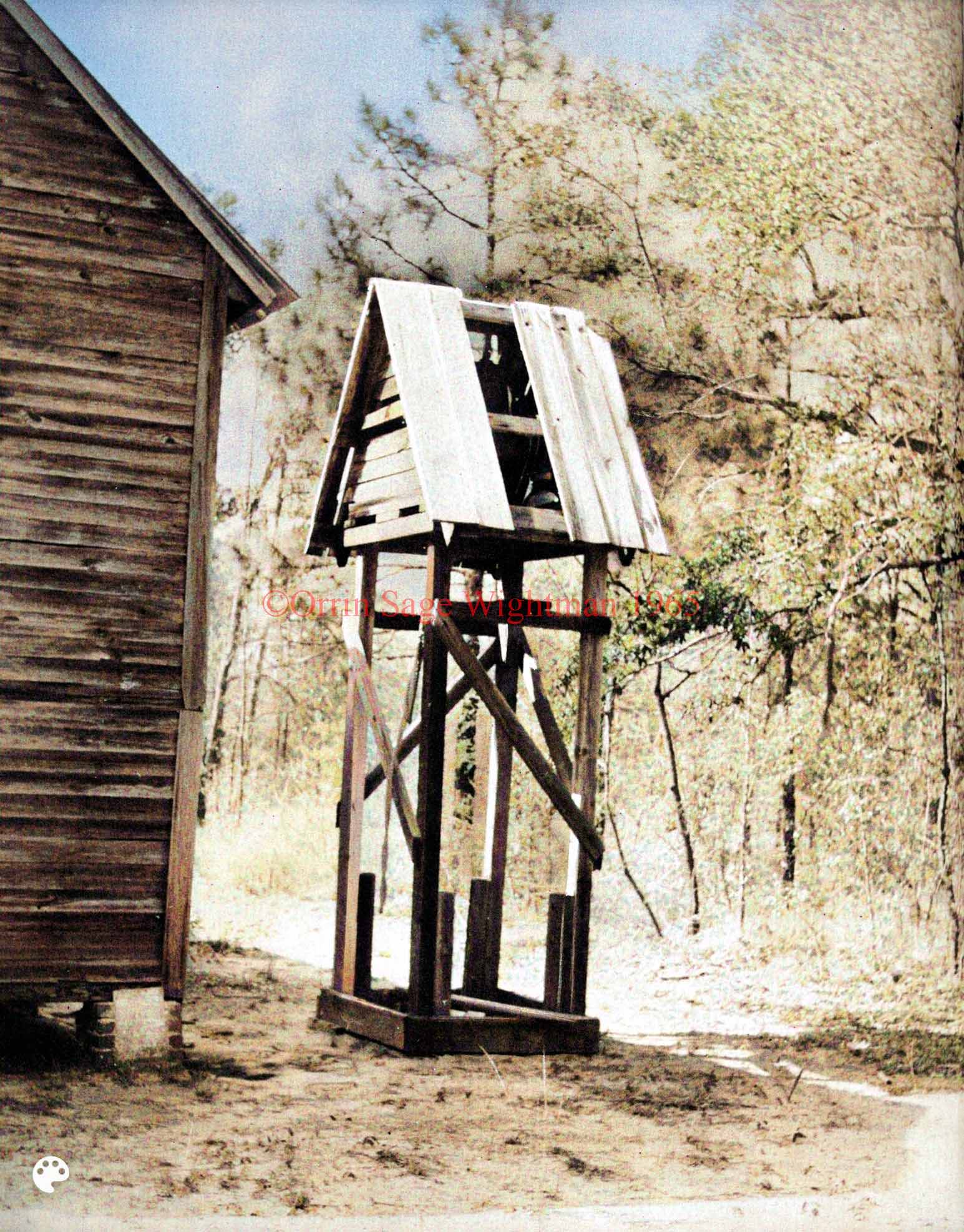
Pg. 197
Bell Tower of the Petersville Baptist
Church
The members of the Petersville
Baptist Church felt that their church would not be fully equipped
unless it had a bell. Building a steeple to house the bell would
have been an expense beyond their mean, so they erected this simple
structure near by. Here the bell was mounted where it could ring
out its summons just as effectively as though it had been installed
in a steeple above the church.
Pg. 198
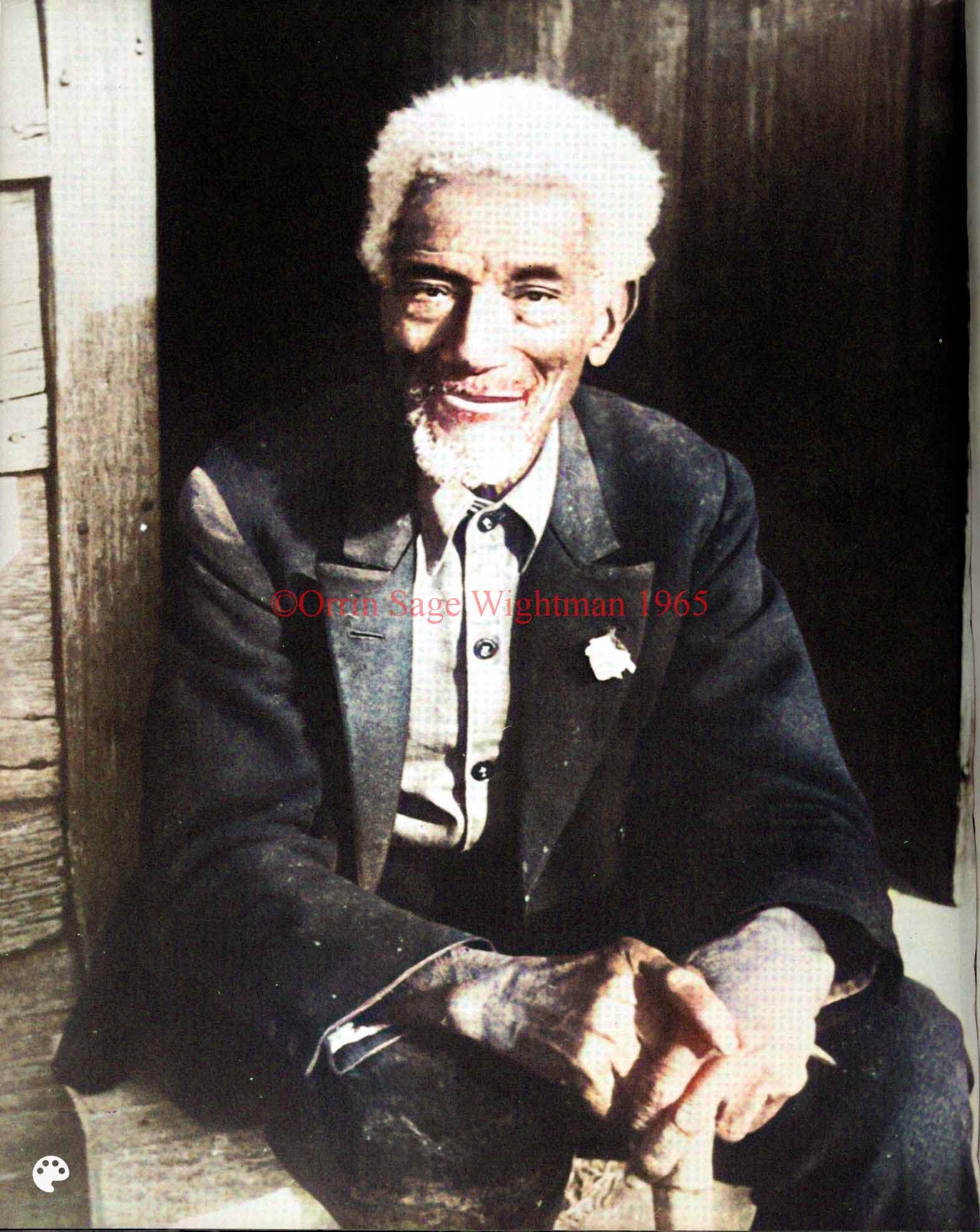
Pg. 199
Liverpool Hazzard
Liverpool was the last of
the Butler slaves. The Pierce Butler holdings in this
section were Hampton or Butler Point, the Sea Island cotton
plantations at the north end of St. Simons Island; Butler Island,
the rice plantation in the delta of the Altamaha River; and
Hammersmith, a tract on the mainland. At the height of their
prosperity these plantations were people with almost a thousand
slaves.
Born in 1828,
Liverpool lived until 1938. One
hundred and ten years is a long time to live! Yet his mind was
clear to the last and he was almost valuable source of information
on the life of another era. Furthermore, he was able to be up and
around and to enjoy life.
When he was 107 years old, an enterprising Georgian
built a fence around him and charge admission to his home. However,
Liverpool stipulated that his friends, white and black,
should not be charged for seeing him. Though he lived three years
longer, the age painted on the fence in figures a yard high was
never changed; on the fence he remained 107 years old.
During the Civil War,
Liverpool was the cook for
a company of Confederate soldiers commanded by Capt. William
Miles Hazzard and stationed at Camp Walker, on the mainland in
Glynn County. Though he was a Butler man and proud of it,
after the war he took the name Hazzard for, as he said, that
was the last white man who was his boss while he was a slave.
Liverpool delighted in telling of his experiences
during the war. The soldiers of the company which he had served
were his especial interest. He maintained contact with these men,
their children, and grandchildren, feeling almost as if he, too, had
been a Confederate solder.
One of the tales which he told small boys was of the
time when he and some of the soldiers hid the horses down in a swamp
so that they would not be found by the Federal troops who were in
the neighborhood. The Confederates held their hands over the mouths
of their horses for fear they would neigh when they heard those of
the enemy. Thus, they prevented detection. It seemed to please
Liverpool very much that he had a part in this scheme which
saved the horses from capture.
Pg. 200
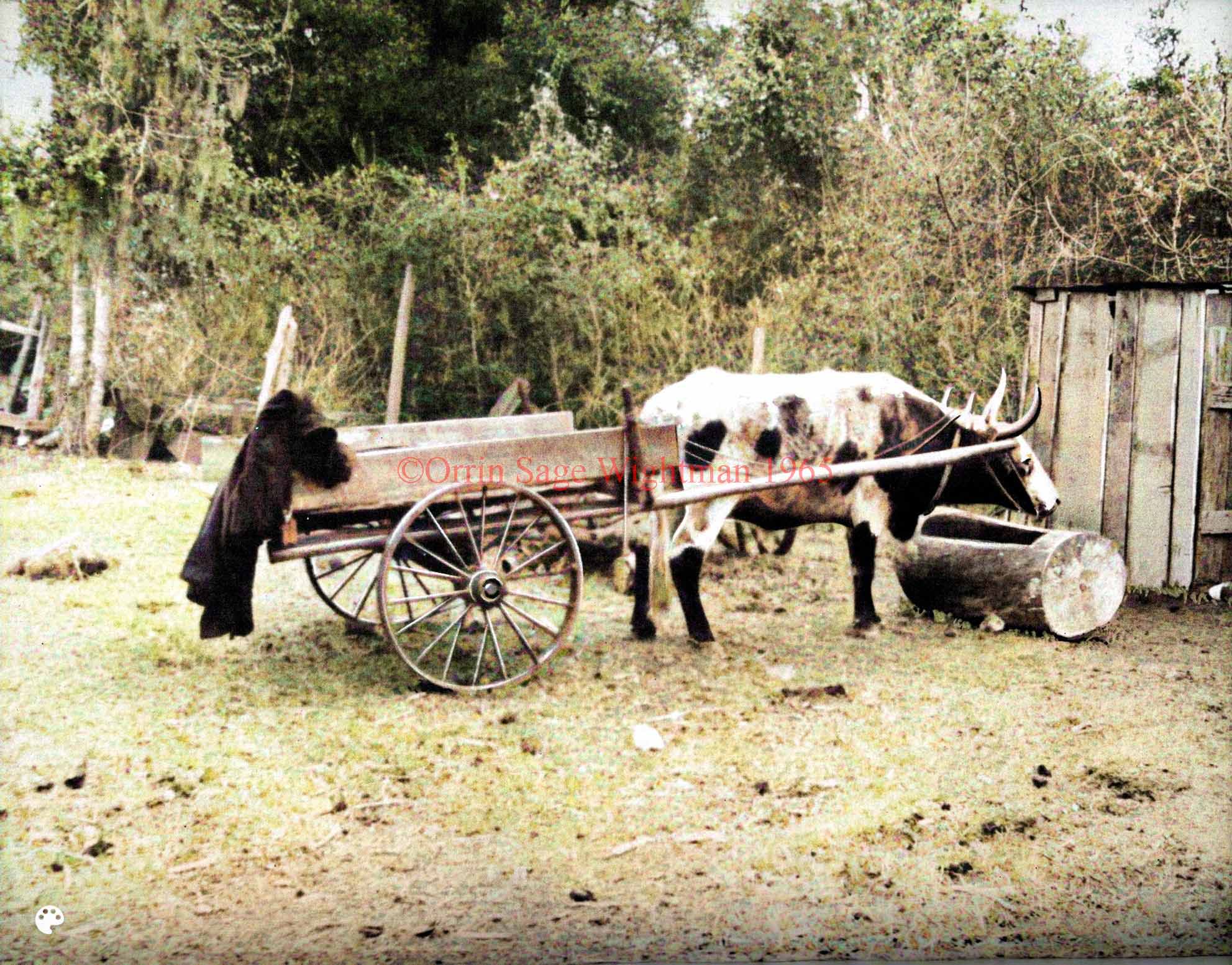
Pg. 201
Liverpool’s Ox Cart
For many years
Liverpool
lived alone in his little cabin in Darien. A granddaughter who
lived nearby cooked for him and took care of his needs. He rode
around Darien in his cart and seemed not to mind the pace of his
steed, though it must have taken all day to get anywhere. He and
his ox had been together a long time and seemed to understand each
other.
Both before the war and after,
Liverpool’s work
was on Butler Island. Here he was an oarsman, one of a crew who
rowed the plantation boats. These boats were built from a single
cypress tree, hollowed out much as the Indians built their canoes.
After wet sand was placed around the edge of the boat, the middle
was burned and worked with tools until it was of the right
thickness. Finished to a polished smoothness on the outside with a
drawing-knife, these boats were “streamlined” and moved smoothly
through the water. Equipped with outriggers of iron to increase the
leverage of the oars, the boats were manned by four to ten oarsmen
and ranged in length from thirty to as much as forty-eight feet.
As they passed up and down the waterways, the boatmen
sang, their oars keeping time with the rhythm of the song. Each
plantation had its own songs and, if a boat passed in the night, it
could be identified by the songs.
Such craft, a necessity on the plantations in this
section, were in constant use, being the popular means of
transportation. In addition, they provided the plantation masters
with a means of entertainment. Boat races were a popular sport and
drew enthusiastic crowds.
The gentlemen gave fanciful names to their craft—Comet,
Swan, Flea, Lizard, Leopard, Star, Minerva, Sunny South, Goddess of
Liberty, Devil’s Darning Needle, Lady of the Lake—and painted
them and costumed the crew accordingly. The Goddess of Liberty,
a six-oared boat, thirty-two feet long and three feet, eleven inches
wide, was painted white, with a blue band in which there were
twenty-four stars (for the twenty-four states of the Union), while
the crew was dressed in red. The Devil’s Darning Needle was
painted black and the crew dressed in green. The crews, trained to
a high degree of perfection, frequently covered the half-mile course
in tow minutes, twenty seconds.
Pg. 202
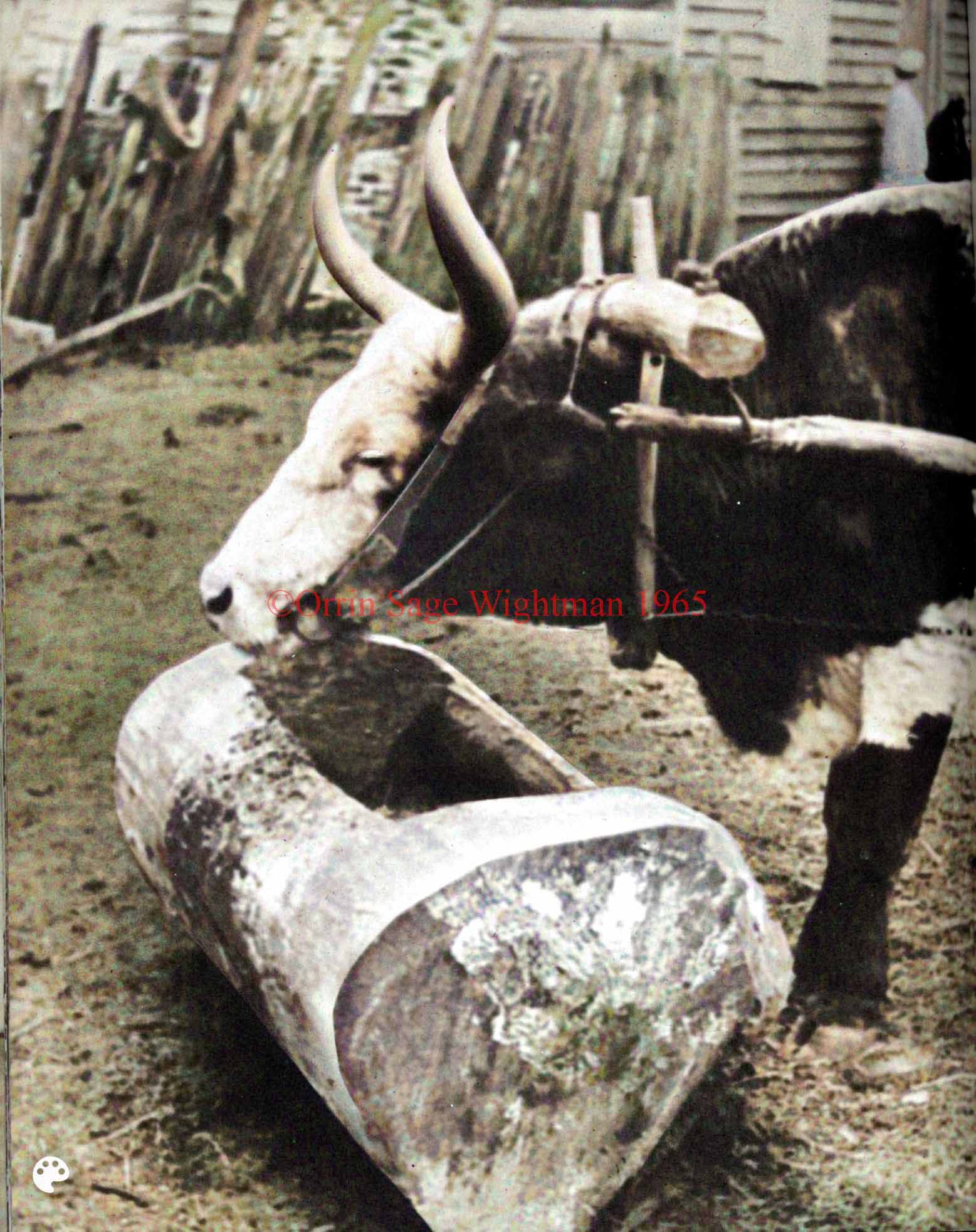
Pg. 203
Liverpool’s Ox Cart and Trough
Liverpool was quite modern
in many ways, learning to enjoy a cigarette when he had always been
accustomed to a pipe. However, in most instances he clung to the
ways of his youth, as in his use of this trough used to water the
ox. Typical of those used in this section for many generations,
such a trough was made of oak or long-leaf yellow pine and hollowed
out with tools and by burning. Since it was made of durable
materials, it would last a lifetime, or even be passed down from one
generation to another.
Liverpool was the type to have been used as a
household servant and, when not used as an oarsman, that was his
work. When Pierce Butler, Fanny Kemble’s husband and
Liverpool’s “Massa,” was stricken with malaria fever, Liverpool rowed him to Darien for medical attention.
Mr.
Butler died and was buried in Darien, but later his body was
removed to Philadelphia.
After the death of
Pierce Butler, his daughter Frances, who became the wife of the
Rev. James W. Leigh,
lived here and operated the Butler Plantations for some years. Her
book Ten Years on a Georgia Plantation, gives a picture of
life during Reconstruction. Liverpool continued as the
oarsman for the Leighs and took part in the races held on the
river, though these races were among the craft in this particular
area and not between the plantations up and down the coast.
The
Leighs had an only child, Alice, who
married a distant relative, Sir Richard Pierce Butler.
Lady Butler often visited Georgia and kept in touch with these
Bulter Negroes. On these visits she would give a party for
them and their descendants, who came from over the area to see their
“Missus.” On one such occasion, in thanking her for the party, the
speaker said, “Dis festival will long be remembered. It will be
remembered by the offsprings when de foresprings is
done dead an’ gone!”
Lady Butler gave Liverpool a monthly
allowance which enabled him to live. Henry Ford also
assisted in caring for him, so that he was comfortable in his last
years.
Pg. 204
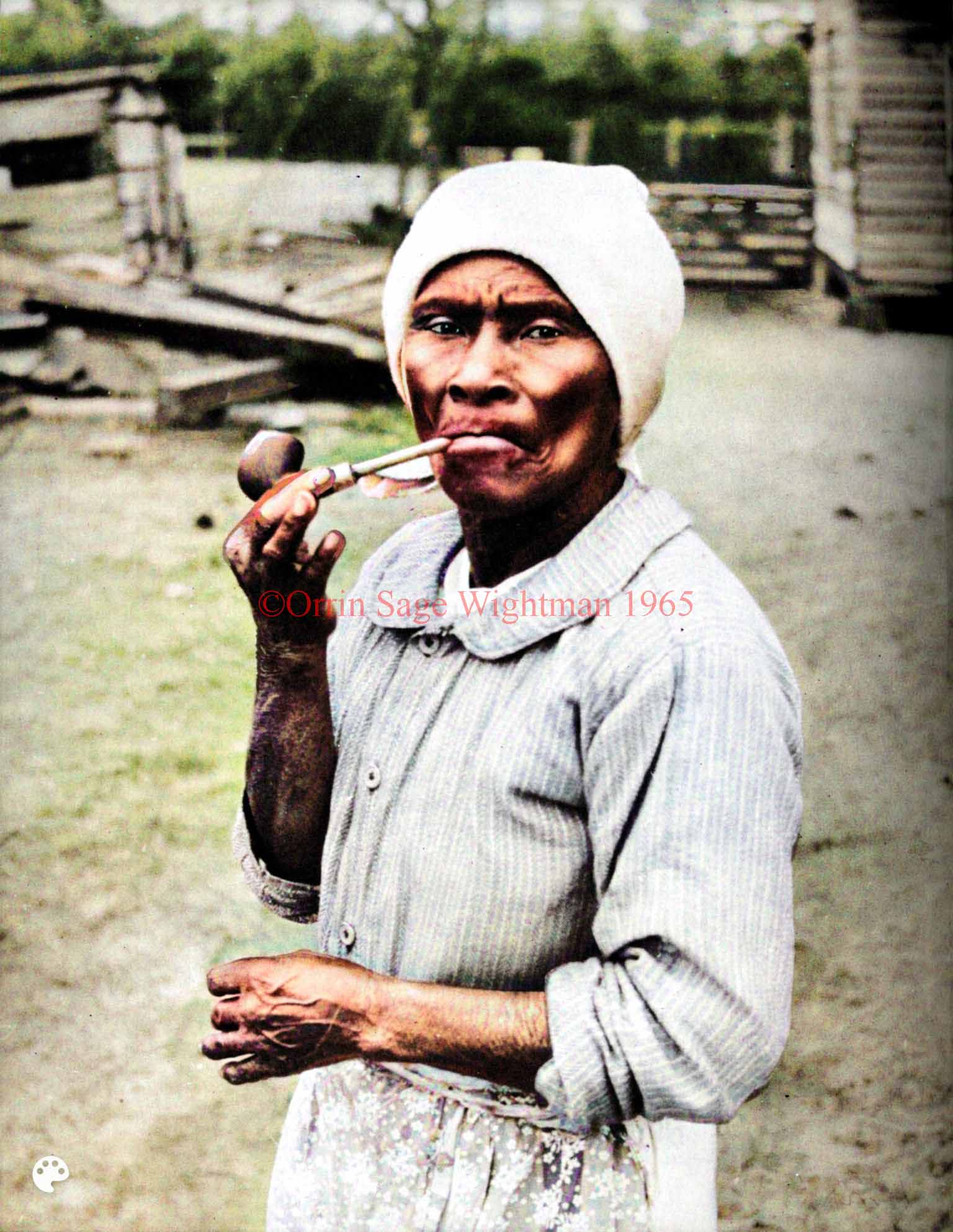
Pg. 205
Old Jane
Jane was raised on a rice
plantation and was what was known as a “Geechee” from the Ogeechee
River which was noted for its rice plantations. In South Carolina
she would have been called a “Gullah” from the African tribe,
Angola.
These terms were not used to designate Negroes who spoke
a very poor grade of English. Living on these large rice
plantations, they saw very little of white people since the
plantation master and his family, in an effort to escape malaria
fever, left the plantation in summer. The Negro, with his immunity
to malaria, could live in an area that would have meant death to the
white man. Because of this lack of contact with white people, these
rice-field Negroes developed a jargon all their own which bore
little resemblance to the English language and which, to a stranger,
is like a foreign language.
Jane supervised the work of the children who were
tying chickens to send them to market. She made the children count
aloud so they would be certain to tie three chickens—not two, nor
four—in each bundle. This is what they said,
“Dis’n un; dis’n tied pun top ur tarruh. Now, dem foots all tie
tergurruh!” Translated, this would mean, “This is one: this is
another; this one that’s tied on top is the other. Now, their feet
are all tied together!”
Jane was a McIntosh County woman and lived her
last years in Darien just across the road from Liverpool Hazzard.
When people went to see Liverpool—and paid admission for the
privilege of seeing a man who was more than a hundred years old—Jane
would meet them and fuss because they did not pay to see her for she
claimed to be as old as Liverpool.
She was one of the fortunate recipients of
Henry
Ford’s bounty. When Mr. Ford was living on his Richmond
Hill Plantation in nearby Bryan County he became interested in the
old Negroes and helped them to live more comfortably. He had
Jane’s house repaired, supplied furniture and equipment, paid a
woman to take care of her, and made a monthly allowance to meet
current expenses.
Pg. 206
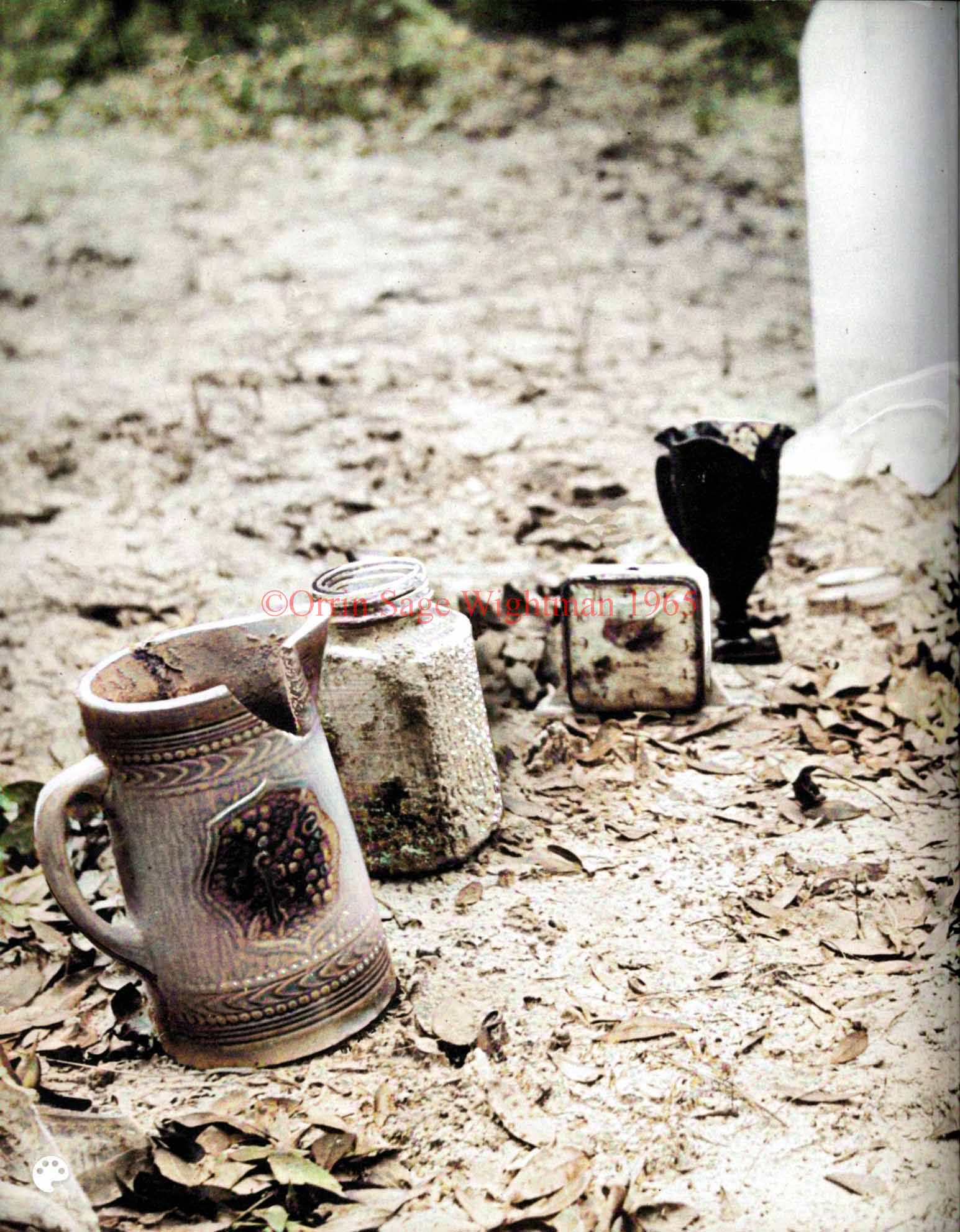
Pg. 207
Negro Graves
In old Negro burying grounds the
grave is outlined with various and sundry items. In some cases
there is a board at the head and another at the foot of the grave
with these articles placed along the ground between these two
boards.
The articles on the graves include every kind of
container or utensil—sea shells, salt and pepper shakers, pickle
bottles, shaving mugs, moustache cups, piggy banks, the interior
mechanism of a radio, alarm clocks, lamps, automobile head lights,
electric light bulbs, flash lights, combs, cold cream jars, plates,
cups, saucers, ash trays, milk bottles, and chamber pots.
Everything on a Negro grave is broken. To them this is symbolic.
Life is broken; the vessel is broken.
No doubt many of the articles used to decorate these
graves had been broken accidentally and were then brought to the
grave, but some of them are broken deliberately. In fact, this is
standard procedure at a funeral. After the grave is filled and the
earth shaped into a neat mound, the flowers are placed on the
grave. If any of these are in a vase or other container, this
container with its flowers is knocked against a stump, or some other
object, and a hole broken in the bottom of the vessel before the
vase and flowers can be placed on the grave. The same treatment is
given a potted plant, the bottom of the pot being broken before the
pot with its growing plant is placed on the grave.
Years ago Negroes put these broken articles on all their
graves; but, today, one finds them only in isolated communities far
removed from the influence of the white man’s culture. To seek them
out, one must leave the paved roads and search in remote areas where
the Negro still keeps alive his African culture and practices those
customs handed down from generation to generation.
Pg. 208
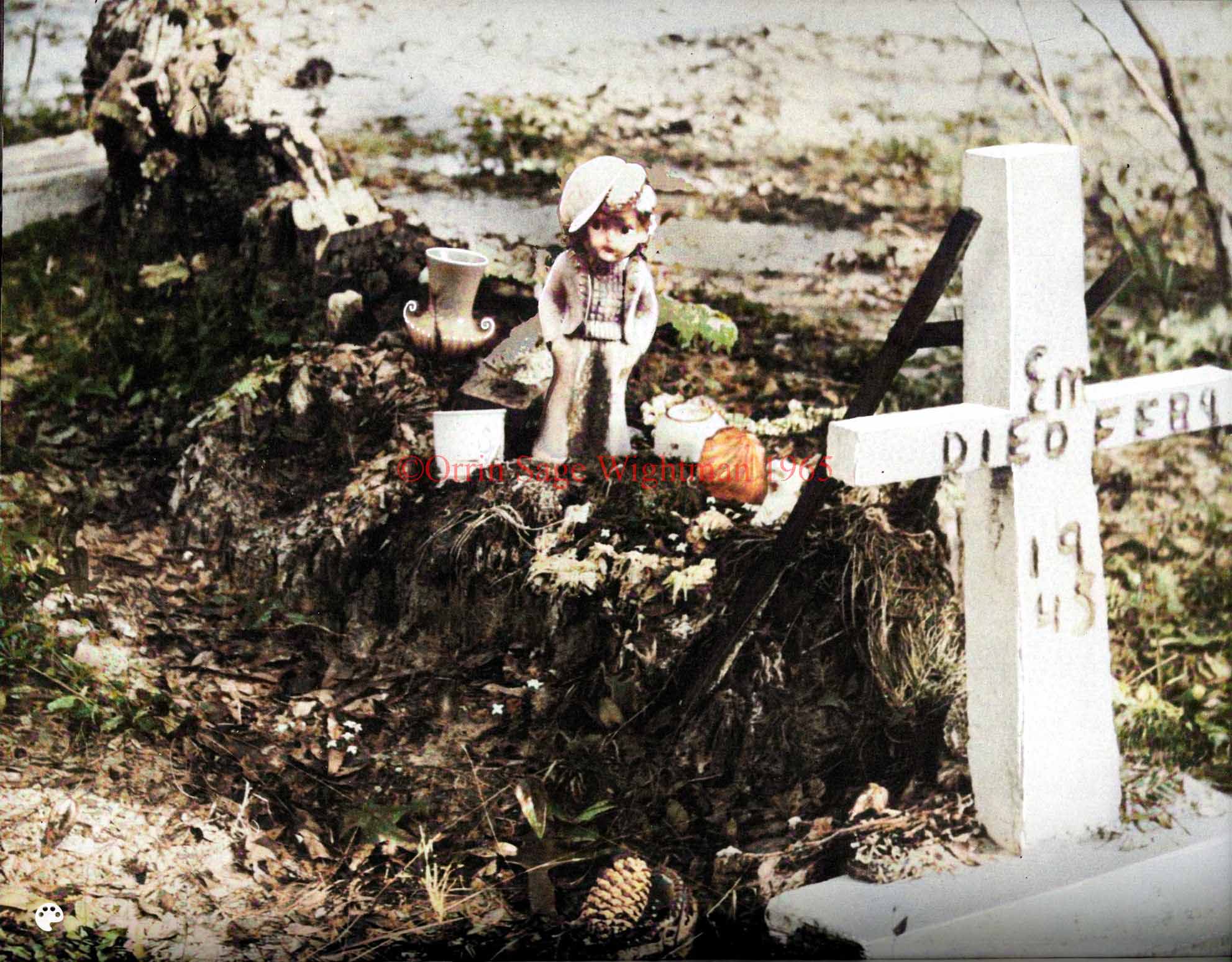
Pg. 209
Jackie Coogan
Though the decorations on the
graves usually follow the same general patter, being items
attractive to the Negro and, perhaps, articles which had been owned
by the dead, yet, sometimes there are things that are most unusual.
Such is this figurine of Jackie Coogan in the role that made
him famous when he played with Charlie Chaplin in “The Kid.”
About fifteen inches high and made of bisque, this figurine
withstood the ravages of the weather for many years.
Jackie Coogan stands near a shaving mug marked in
gold paint with the number “6” and amid a collection of vases and
jars of every description. Behind him lies a papier-mâché cross
decorated with a wreath and all around there are such things as
dishes, pine cones, the remains of a wreath from a florist shop, and
a wooden ladder-like arrangement which was used to hold the floral
offerings at the funeral.
Even when it was first put on the grave, this
Jackie
Coogan statue was broken and had to be pushed down into the
earth so that it could stand up.
Some of the Negroes believe that these broken articles
will keep the “ha’nts” from walking on the grave; to them this is
important, for they feel that the dead should be allowed to rest in
peace undisturbed by these evil spirits.
These pieces of broken glass, lying in the sand and
exposed to the weather, undergo a chemical change and take on
beautiful amethyst tints. However, the Negroes believe this change
in the color of the glass comes about because of it shaving been on
a grave.
Pg. 210
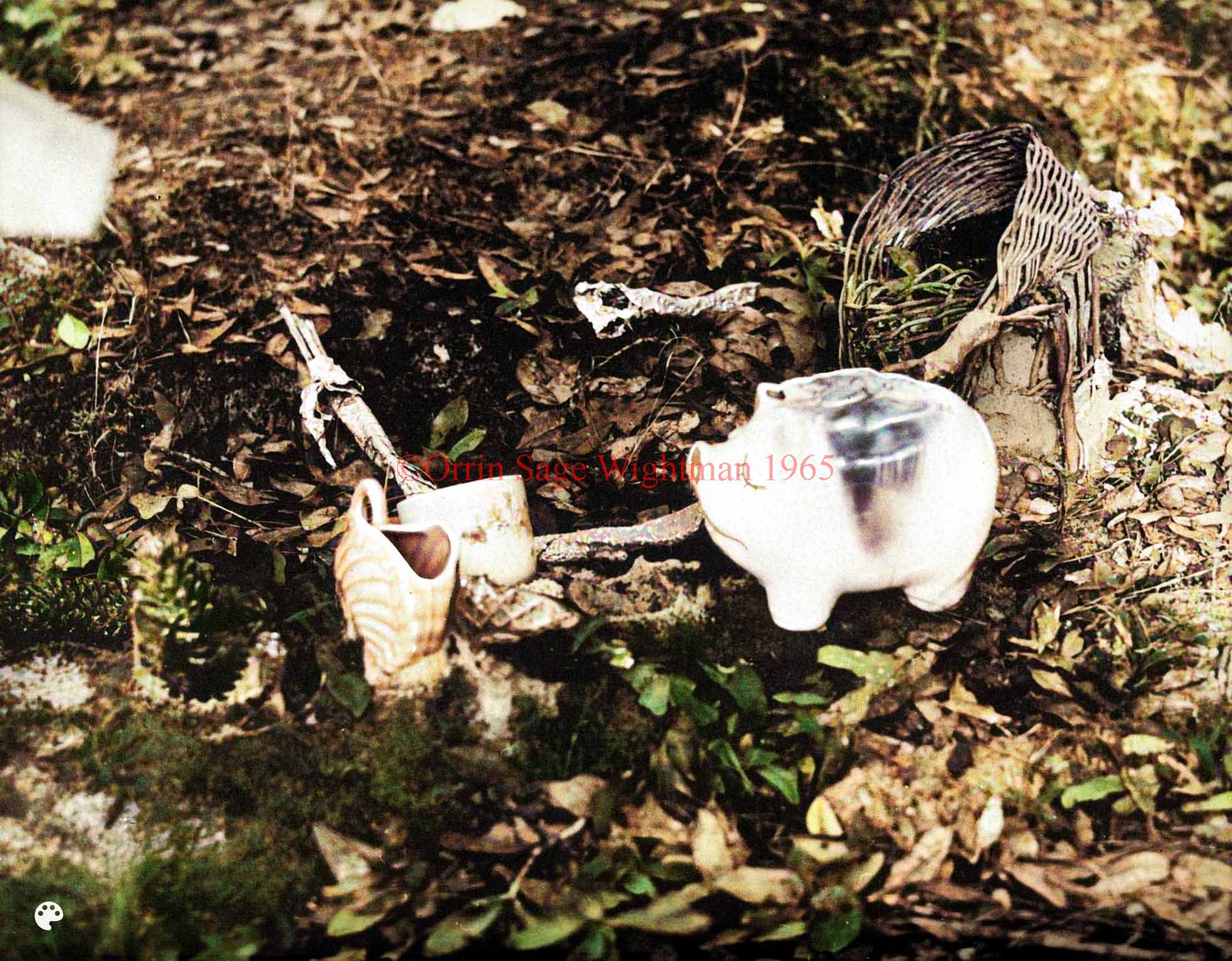
Pg. 211
A Piggy Bank
Though there is little doubt that
much of the material used to decorate these Negro graves is put
there when the grave is new, still articles are added from time to
time.
This crockeryware piggy bank is on the same grave which
at one time was decorated with the bisque figurine of Jackie
Coogan that crumbled after some years. Now, with his long
eyelashes turned-up nose piggy stands in Jackie’s place!
These queer practices are so much a part of the life of
the old-time Negro that they do not seem strange or unusual either
to the Negro or to those white people who knew the Negro. Many
other practices which are tied in with their African inheritance
were continued by the Negroes. For instance, they would not sweep
the floors while a corpse was in the house. Neither would they wear
clothes that had belonged to a dead person, for that person might
come back in search of his apparel.
If a ha’nt did come back and try to catch you, it was a
good plan to pour whiskey on the ground. The ghost would stop to
drink the whiskey and you could get away safely.
A broom across the door would keep the ha’nt from coming
through the door, for every straw in the broom would have to be
counted. A sieve or wire screen served the same purpose for the
number of holes in the sieve or screen must be determined.
The old Negroes were greatly concerned with luck. They
studiously avoided bad luck and carefully cultivated those things
that brought good luck. Among these good luck items rice was most
important. When one moved into a new house, a few grains of rice
were thrown on the floor in each and every corner of the house.
Many years ago Mrs. Maxfield Parrish built a new cabin in
which the Negroes could sing. Visitors on the opening night well
remember the ceremony with which Julia Armstrong threw rice
in each corner, thus assuring good luck for the singing of the
Negroes.
Pg. 212

Pg. 213
Superman
On a grave near that which had the
Jackie Coogan statue stood Superman. Dressed in some sort of
garment that looked like a yellow unionsuit, he had a red scarf
draped over his elbows in much the same fashion that women wear a
stole.
Superman was not able to stand alone and so he was
leaning against a wooden cross which had been decorated with large
crepe paper flowers. A visit to these grave several years later
showed that the papier-mâché figurine had not been able to withstand
exposure to the weather and Superman had crumbled!
Each Negro settlement has its own burying ground,
following the practice of the Plantation Era when each plantation
had a burying ground for its slaves. Many generations of the old
Negro families of this area have been buried in these old slave
burying grounds and they continue to bury their dead in these same
old cemeteries. The belief is strong among the Negroes that your
body must lie with those of your ancestors. Sometimes this meant
that a husband and wife were buried in different cemeteries, the
woman being buried by her parents in one burying ground while the
husband was laid with his family in another. Even today when
Negroes die elsewhere their bodies are brought back from great
distances that they may rest with their own people.
In these old Negro graveyards one never sees shrubbery
planted to beautify the area or fresh flowers kept on the grave, as
is the custom in white burying grounds. However, the Negroes always
carried flowers to the funeral and placed them on the new-made
grave.
Pg. 214
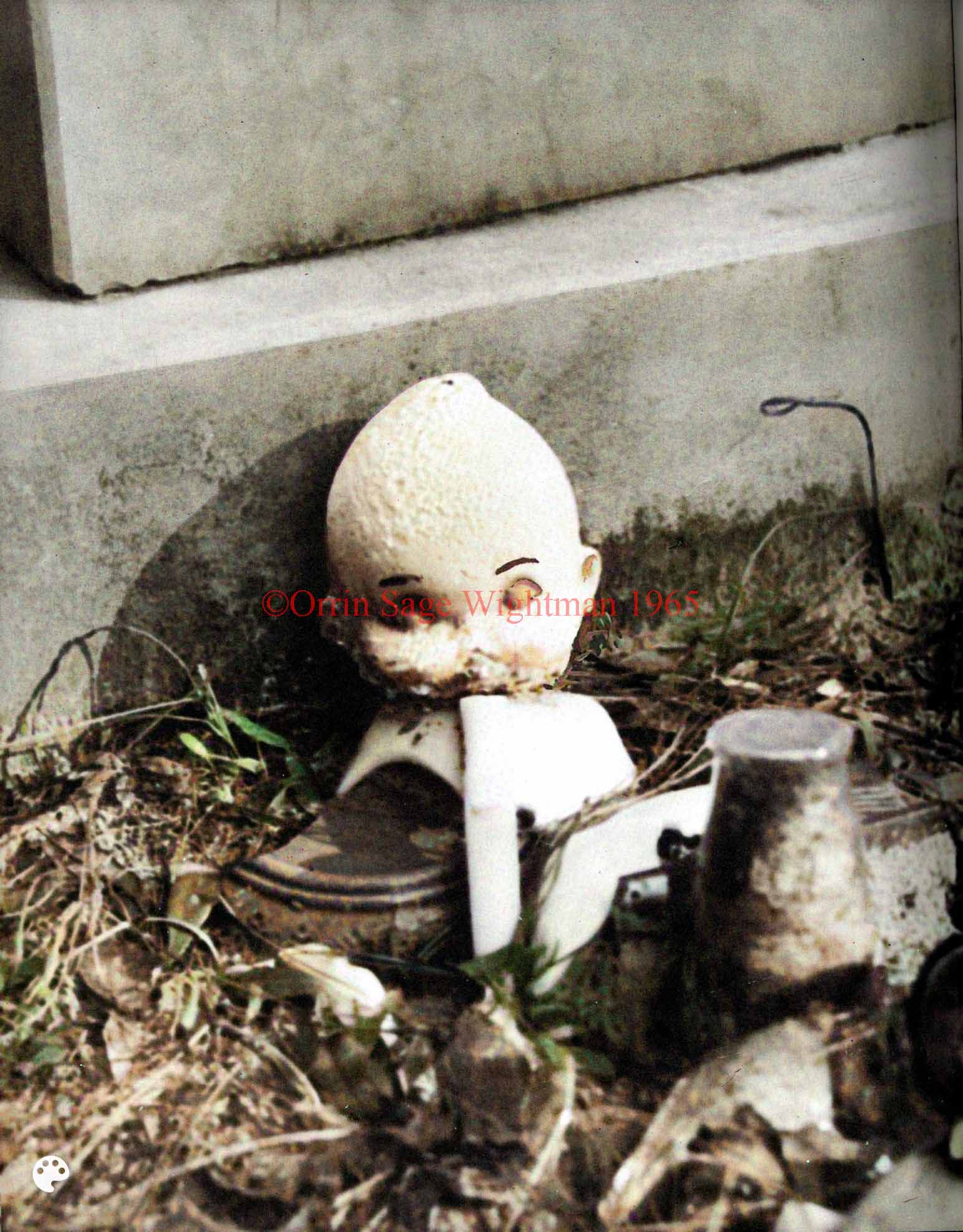
Pg. 215
Doll’s Head
Near the graves with figurines of
Jackie Coogan and Superman was this doll’s head with the
bluest of blue eyes. The body of the doll was missing and the
bisque head had already begun to show the effect of wind and
weather, but the blue of t he eyes was not dimmed as the head of the
doll leaned against the headstone amid the mass of broken articles
which marked the grave.
The Negro has many superstitions about the head. At
funerals they pass before the coffin and pause to look on the
corpse, perhaps saying a few words to it, and laying a hand on the
body; for, if you do not lay your hand on the corpse to tell it
goodbye, it will “ha’nt” you! Even taking the child’s hand and
placing it on the dead body so that the child will not be tormented
by the “ha’nt.”
Since they believe that the spirit of the dead hovers
over the body until the body goes into the ground, they want to be
sure they have made their peace with this spirit so that it will not
come back and bother them.
At funerals the Negroes sing the deeply religious songs
of their people and at no time do these songs prove more impressive
than on such occasions. Typical of the funeral songs are these: “I
Want to Die with a Staff in My Hand,” “Low Down the Chariot and Let
Me Ride,” and “My Soul Be at Rest.”
During the Plantation Era funerals were sometimes held
at night, the Negroes marching to the burying ground carrying
torches of “pine knots” to light their path. Gathering around the
grave, they held their torches until after the funeral, when they
throw them behind them. In these burying grounds were many of these
pine knots lying all over the ground, for no Negro would ever move
them.
Pg. 216
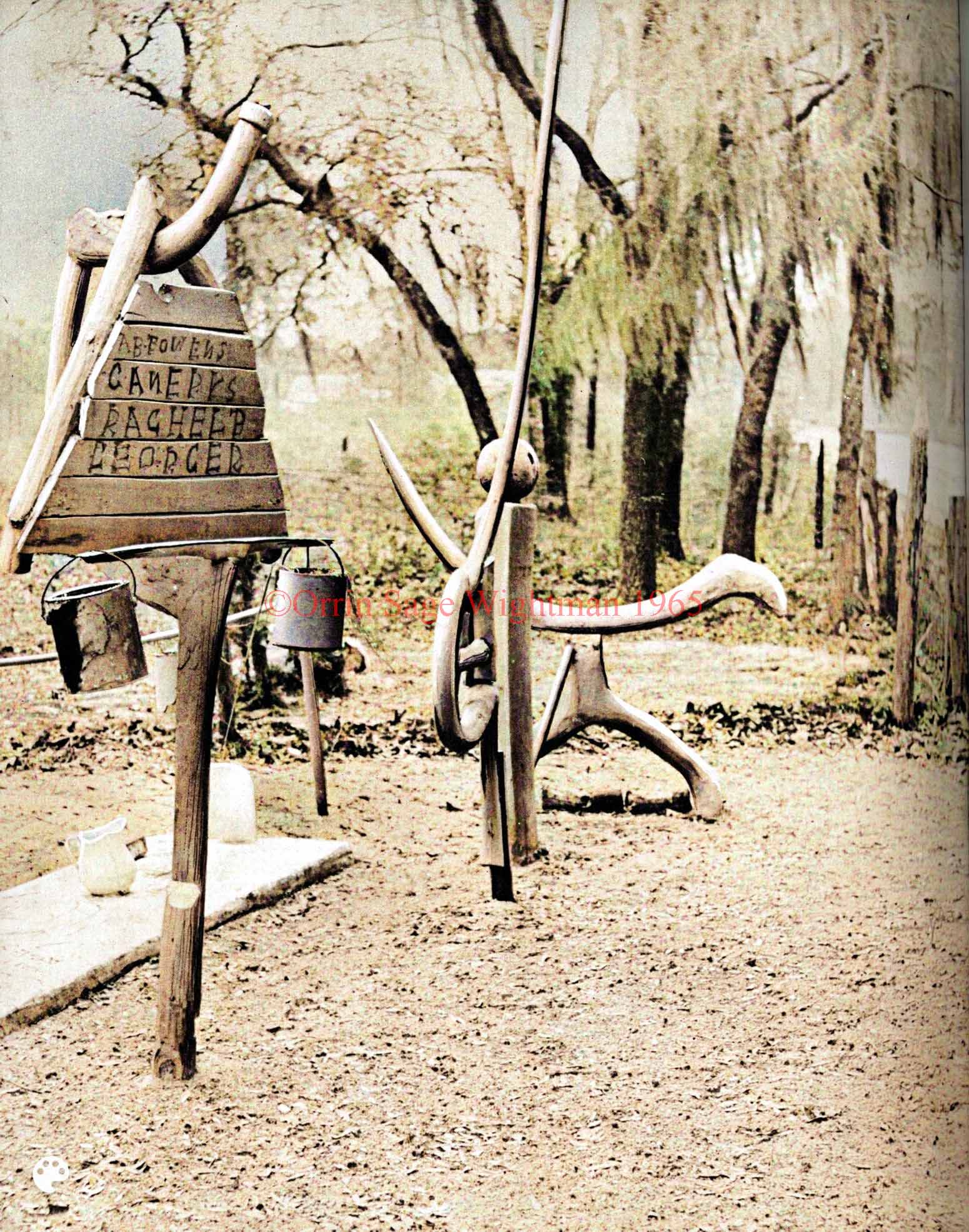
Pg. 217
Bowens’ Family Burial Plot
At the Baptist Church in the Trade
Hill section of Liberty County, Georgia, there is a typical Negro
burying ground where the graves are decorated with all sorts of
broken articles. Adjoining this regulation burying ground there is
a small plot fenced off as the private graveyard of the Bowens
family.
Enclosed within a wire fence so as to set it apart from
the large cemetery, this family plot contains some of the most
unusual arrangements made of wood, of iron, or of brick and cement.
The man who constructed these arrangements found queerly shaped
pieces of wood and put them together to create these original
designs. Indeed, it would seem that he might be credited with
having inaugurated the fad for driftwood arrangements.
In this picture, far to the right, is a modernistic
design of a bird or, perhaps, it is intended to represent an
animal. ON the left several pieces of wood have been joined
together to hold up the sign board on which are carved the names of
some of the persons buried in the enclosure. The piece of wood in
front of the sign board holds two tin buckets—one on either end—in
which at one time flowers may have been growing.
These strange pieces stand in a row on the edge of this
family plot and on the side next to the public road. This may have
been done so that they would be seen or, ti has been suggested, that
it may have been an effort to protect the graves from the evil
spirits that might come from this open road. No matter what the
purpose may have been in this, the fact remains that they are
unique!
Pg. 218

Pg. 219
The Bowens Marker
This post, which is the central
marker of the Bowens’ Family Burial Plot is unique. The head
on top represents pure voodoo, while the letters carved a few inches
below spell BOWENS.
Among the Negroes the belief in “conjur,” or voodoo, is
strong and conjur doctors, witch doctors or voodoo men, as they are
sometimes called, still practice their profession. Their “bag of
tricks” contains a remedy for any and every ailment. With the use
of certain ingredients a conjure doctor sets himself up to cure any
disease or condition and, what is more important, he professes to be
able not only to cause but also to cure any sickness.
He will fix a concoction that will cause a person to get sick even
though that individual is miles away.
Now that automobiles are in general use, persons travel
hundreds of miles to secure the services and purchase the wares of
these practitioners. If the conjur has taken effect and the person
is already sick and it is desired to remove the cause of this
sickness, it is necessary to take the sick person to the voodoo man
so that he can practice his magic.
Though many of the items used in making voodoo remedies
consist of roots of various flowers and shrubs (and for this reason
these men and women are sometimes called “root doctors”), there are
other items which have to be purchased from a drug store. These
include brimstone (burnt sulphur in sticks), alum, cream of tartar,
Epsom salts, Rochelle salts, saltpeter, potassium iodide (which they
call “idine potassa”), senna and manna, slippery elm (el um) bark,
and gum guaiac (gum bowackum).
Pg. 220
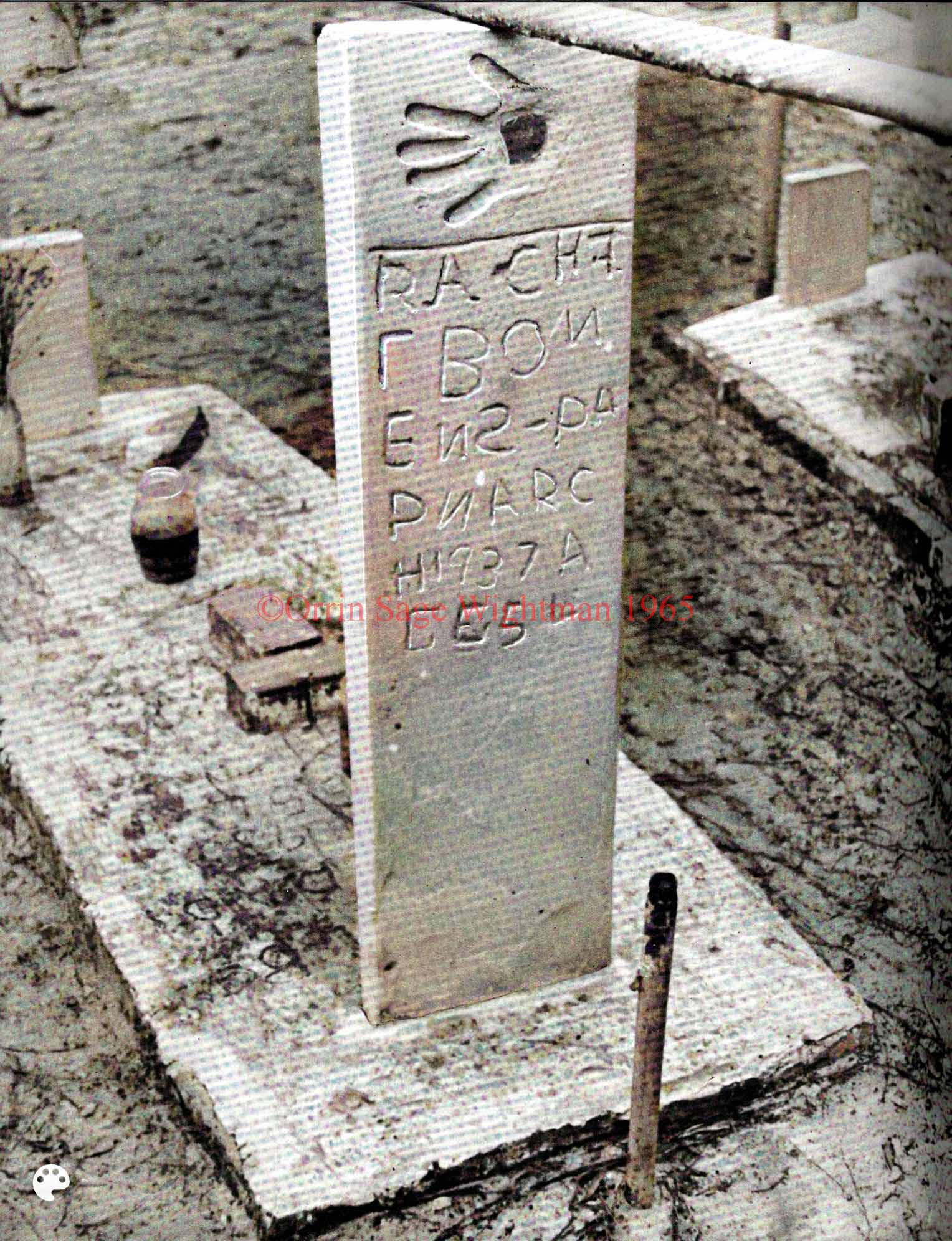
Pg. 221
The Grave of Rachel Bowens-Pap
The graves in this
Bowens’
Family Burial Plot are well built of brick and cement. The
tombstones are of cement with the inscription made and decorations
applied while the cement was still damp.
This tombstone marks the grave of
Rachel Bowens-Pap.
At the top there is the imprint of a hand embedded in the palm of
which is a piece of looking glass.
The inscription is difficult to decipher. On the top
line is RACHE, the E written backward, and the L is on the
next line and upside down, to spell RACHEL. Next comes
BOW, though the W was not finished, and on the next line ENS
to finish BOWENS. A hyphen follows and PA with another P on
the next line to spell PAP. Next, 1937 with A on one line
and, on the next line, GE to spell AGE while the 54 completes the
inscription.
Pg. 222
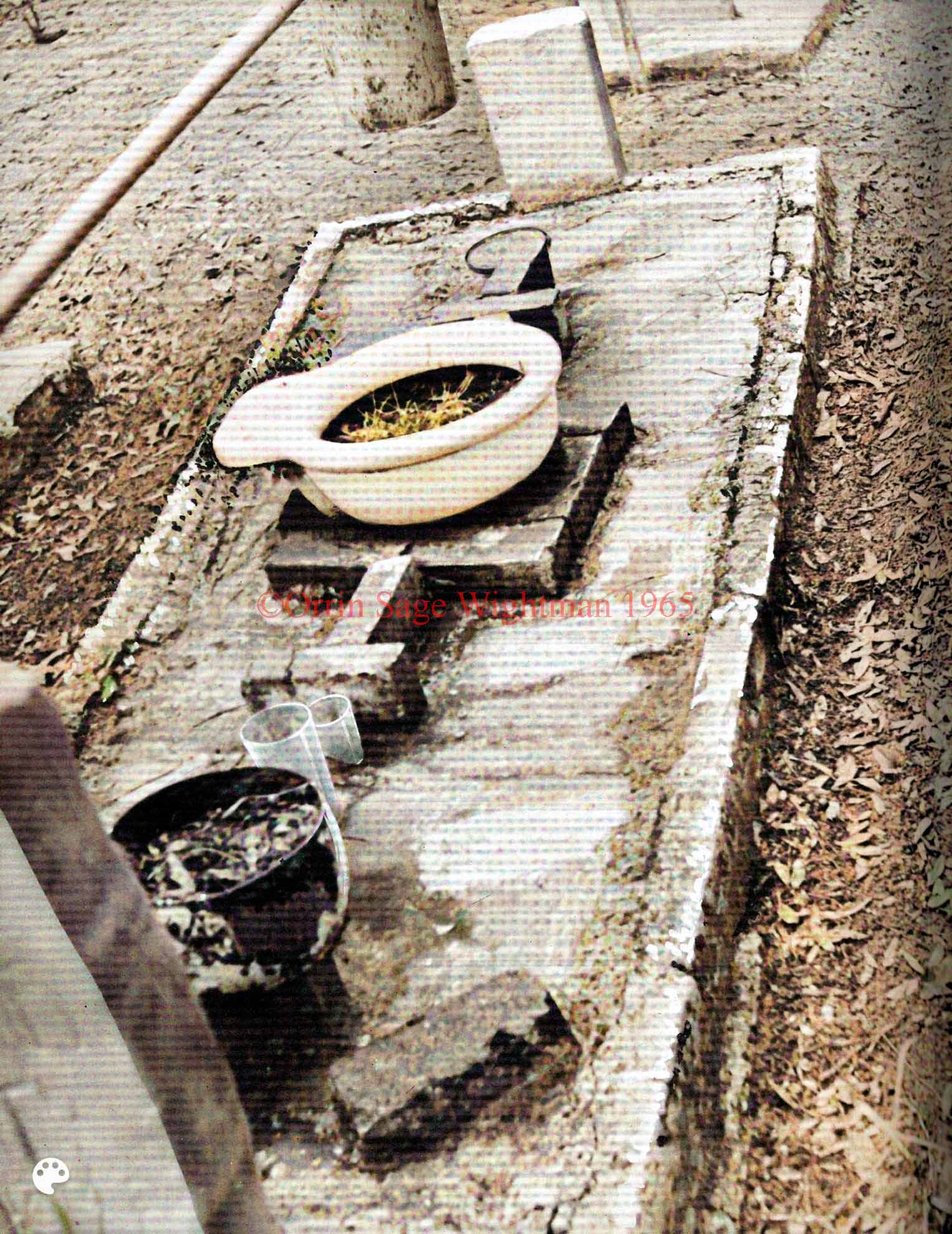
Pg. 223
The Grave of the Reverend Aaron
Bowens
This is the grave of the
Reverend Aaron Bowens. The entire grave is covered with brick
and cement to form a slab in the middle of which a toilet bowl has
been installed.
Just what it means or why it was put there no one seems
to know, but no doubt the manufacturer would have been surprised if
they had known where their bathroom fixture would be installed.
Pg. 224
The Historical Background of St.
Simons Island
The earliest known inhabitants of
this area were Indians of Muskhogean stock whom the Spaniards called
Guale Indians. Several Indian villages were located on St. Simons
Island. From one of these, excavated on the site of Malcolm
McKinnon Airport in 1936, were unearthed many interesting artifacts
which reveal much of the life of these people.
On practically every bluff on St. Simons are shell banks
which are the refuse heaps or “kitchen middens” of these Indians.
They contain oyster and clam shells, broken pottery, bones of
animals eaten by the Indians, bowls, drinking vessels, hoes and
tools fashioned from conch and whelk shells, awls and other tools
made of animal and bird bones.
Although Frances, Spain and England laid claim to the
land which is now the State of Georgia, France was the first to
start colonization. In 1562, French Huguenots, led by Ribault,
made a settlement at Port Royal in South Carolina, which was soon
abandoned. Two years later another settlement, led by Laudonierre, was made on the south bank of the St. Johns River
in Florida and called Fort Caroline.
These settlements aroused Spain who sent her ablest
seaman, Pedro Menendez de Avilles, to rout the French and
hold the lands for Spain. Menendez founded St. Augustine in
1565 and destroyed the French.
The following year he explored the coast of Georgia and
of South Carolina. He brought Jesuit priests to found missions
among the Indians; later, the Jesuits were replaced by the
Franciscans who established a string of missions reaching as far
north as Port Royal, South Carolina. Three of these mission
settlements were located on St. Simons Island, one of them, San
Simon, giving the Island its name. For more than a century Spain
colonized this land. The missionaries worked to Christianize the
Indians and to teach them agriculture. However, Indian raids and
British depredations took their toll. Step by step Spain receded
and in 1686 removed all of her settlements north of the St. Marys
River. With Charlestown, S.C., as Britain’s most southerly
settlement and with the Spaniards south of the St. Marys River, the
area which is now Georgia was an abandoned land and for half a
century remained so.
Pg. 225
The founding of the Colony of
Georgia in 1733 was Britain’s challenge to Spain’s claim, and the
building of a string of forts along this Georgia coast gave proof
that the British planned to make their claim hold. Fort Frederica
and Fort St. Simons on St. Simons Island, with Fort St. Andrews and
Fort William on Cumberland Island, as well as other batteries and
outposts on the mainland, formed this Southern Frontier for
Britain’s Colonies in North America against the Spaniards in
Florida.
Fort Frederica, built in 1736 by British settlers under
the direction of Gen. James Edward Oglethorpe, the most
expensive fortification built by the British in North America,
became the military headquarters for this line of defense. A
regiment of British soldiers brought over in 1738 manned these
fortifications.
In the town of Frederica the settlers built their houses
of brick, tabby, or wood and practiced their trades and
professions. It was a thriving village—a little bit of Old England
transplanted here in America.
In order to prevent the Spaniards from landing on any of
the many bluffs on St. Simons Island, Oglethorpe settled
soldiers of the Regiment and some of the Frederica citizens on these
sites.
At the northwest point of St. Simons he located nineteen
soldiers with their families. They called the place Newhampton,
which soon became Hampton. Here each settler was given a fifty-acre
grant of land, which he farmed.
South of Hampton, on Frederica River “from whence they
can see vessels a great way to the Northward,” Oglethorpe set
up a “Watch House” in charge of Richard Pike, one of the
indentured servants who had been maimed in the public service.
Pike and his wife, the daughter of a freeholder at Frederica,
lived on this site which became known as Pike’s Bluff. A corporal’s
guard was stationed there and the soldiers were rotated weekly.
At West Point,
Capt. Albert Desbrisay of the
Regiment and others had plantations.
On Dunbar Creek,
John Terry, the Recorder at
Frederica, established his plantation. Here he built a substantial
house and planted hundreds of orange trees, giving the place its
name, Orange Grove. He made other substantial improvements which he
stated were worth seven hundred pounds, and operated a silversmith’s
shop; however, he will be remembered
Pg. 226
best as the writer of letters which told of the
life of the people of that day.
Hawkins Island was the plantation of
Dr. Thomas
Hawkins, the doctor at Frederica as well as the surgeon of the
Regiment, and the man whose wife made life so miserable for John
and Charles Wesley.
At Gascoigne Bluff,
Capt. James Gascoigne of H.M.
Sloop-of-War, Hawk, maintained headquarters for the vessels
of Georgia’s first Navy. He had a storehouse for supplies, as well
as a careening ground for repair of the ships. He was granted five
hundred acres for his plantation and built a substantial house and
several outhouses.
South of Gascoigne Bluff, at the site which came to be
known as Retreat Plantation and which is now the Sea Island Golf
Course, was the home of John Humble, the first pilot to bring
vessels into this harbor.
At the South End of St. Simons, surrounding Fort St.
Simons, were the houses built for the soldiers of the Regiment
stationed there. These clapboard houses, built along regularly laid
out streets, presented a neat appearance.
On the northeast point of St. Simons a grant of land was
made to Daniel Cannon and the place became known as Cannon’s
Point. Cannon, a carpenter, with his two sons, Joseph
and Daniel, was one of the first settlers of Frederica.
John Lawrence and Archibald Sinclair, both
Frederica settlers, had grants of land on the western shore of St.
Simons and these tracts of land still bear their names.
Below these was the tract occupied by a group of German
Lutherans known as Salzburgers. These families made their living by
planting and fishing, selling their wares to the Frederica settlers
and to the officers of the Regiment.
Capt. Raymond Demere of Oglethorpe’s
Regiment made his home below the German Village tract and called it
Harrington Hall in honor of Lord Harrington under whom he had
served at Gibraltar.
Capt. George Dunbar’s plantation was located on
the bank of the creek which bears his name.
In 1739 the Anglo-Spanish conflict flared into open
warfare. Spain drew first blood, killing two highlanders on Amelia
Island. Oglethorpe led a force into Florida to learn what
preparations the Spaniards might
Pg. 227
be making for an attack on Georgia. The
British burned Fort Picolata and captured Fort. St. Francis de Pupa
on the St. Johns River.
Returning to Georgia,
Oglethorpe planned to lay
siege to St. Augustine. He set out in May, 1740 with a force
consisting of the soldiers of his Regiment, the Highlanders from
Darien, Indian allies, and a considerable number of soldiers from
South Carolina under Col. Vanderdussen.
In this Florida campaign
Oglethorpe destroyed
seven forts and a year later wrote Newcastle that the Spaniards had
not been able to rebuild any one of them. While the invasion did
not accomplish its purpose of capturing St. Augustine, it did keep
the Spaniards busy and thus delayed their expedition against Georgia
while it gave Oglethorpe time to prepare his defenses.
In 1742 Spain assembled a great fleet of fifty-one
vessels and three thousand men and sailed against Georgia. Entering
St. Simons Sound on July 5th they succeeded in passing the guns of
Fort St. Simons and sailing on up to Gascoigne Bluff, where they
landed. Oglethorpe abandoned Fort St. Simons and
concentrated his forces at Fort Frederica. The Spaniards occupied
the abandoned Fort St. Simons, making it their headquarters. On
July 7th, 1742, an engagement between these forces, known as The
Battle of Bloody Marsh, was a complete victory for the British. The
Spanish forces hastily withdrew and never again did Spain attempt to
regain control of this territory. This was the turning point in the
struggle between Spain and England for this southeastern section of
our country. This Spanish Invasion of 1742 is a part of the
struggle which is generally known as the War of Jenkins’ Ear and was
ended by the Treaty of Aix-la-Chapelle in 1748. The following year
Oglethorpe’s Regiment was disbanded and St. Simons Island was
practically abandoned. It was not until after the Revolutionary War
that settlers came again to occupy the Island.
In 1786
James Spalding of Retreat Plantation
received the gift of a package of seed of a Persian cotton which had
been developed on the Island of Anguilla. From this small beginning
there was developed a staple crop which was to bring wealth to this
coastal area. For many years this variety was known as Anguilla
cotton; later, it was called Sea Island cotton. The invention of
the cotton gin about this time brought about the development of
great cotton plantations.
St. Simons had fourteen plantations, ranging in size
from a hundred to three thousand acres and with thousands of Negro
slaves.
Pg. 228
Hampton Plantation became the
property of Major Pierce Butler, who came to America in 1766
as a Major of the 29th British Regiment. His grandson, Pierce
Butler, married Fanny Kemble, noted English actress and
violent abolitionist. Fanny Kemble accompanied her husband
to Georgia in the winter of 1838-39 and spent two unhappy months at
Hampton, or Butler Point, as it is now called. While here she kept
a journal, which was published in 1863 under the title, Journal
of a Residence on a Georgian Plantation, 1838-39. This
“Journal” is said to have caused more criticism of the South than
any book that was ever written except Uncle Tom’s Cabin.
Pike’s Bluff and West Point became the plantations of
two brothers, Dr. Thomas Fuller Hazzard, and Capt. William
Wigg Hazzard. The Hazzard lands extended east to join
those of the Wylly family, whose plantation occupied the
lands of the German Village, now known as The Village.
The
Demere family moved to the South End of St.
Simons where they built a home known as Mulberry Hall and called
their plantation The Grove.
James Gould of Massachusetts, who, in 1808, had
built the first St. Simons Lighthouse and then stayed to become its
first keeper, established a plantation at Rose Hill and then moved
to Black Banks.
The
Cater family lived at Kelvin Grove, which
included the site of the Battle of Bloody Marsh. The marriage of
Ann Cater to James Postell brought this plantation into
the Postell family.
James Bruce had located at Orange Grove and the
marriage of his daughter, Rebecca, to Major Samuel Wright
brought this property into the Wright family.
At Retreat Plantation,
Major William Page and his
wife, Hannah Timmons Page, trained their only remaining
child, Anna Matilda, in the duties of operating a
plantation. Anna Matilda married Thomas Butler King
of Massachusetts, who became the local Representative in the United
States Congress and, later, Collector of the Port of San Francisco.
Mrs. King’s operation of the plantation was so efficient that
it became one of the finest on St. Simons and her Sea Island cotton
brought top prices in the markets of England.
The
Lawrence family continued to operate their
plantation and Major Pierce Butler now owned Sinclair, which
was used by the plantation
Pg. 229
owners as the meeting place for their social
organization, “The Agricultural and Sporting Club of St. Simons.”
Two friends and partners in business,
John Couper
and James Hamilton, settled on St. Simons—Couper at
Cannon’s Point and Hamilton at Gascoigne Bluff. Hamilton
prospered greatly and finally removed with his family to
Philadelphia, where his home was one of the finest of its day. When
he died in 1829 he was rated as one of the few millionaires of the
country. Hamilton Plantation is now the site of the Methodist
Center, Epworth-By-The-Sea.
John Couper and his son, James Hamilton Couper,
developed at Cannon’s Point one of the finest plantations in the
South. In an effort to diversify his crops, John Couper
brought in dates from Persia and olives from France. Cannon’s Point
has been called “Georgia’s First Agricultural Experiment Station.”
During the Civil War St. Simons was abandoned by the
plantation owners. The men were in the Army of the Confederacy and
the women and children refugeed on the mainland at Waynesville and,
later, at Waresboro. The Negro slaves remained on the plantations
and many of the men joined the United States Army, enlisting in a
regiment commanded by Col. Thomas Wentworth Higginson, the
first Negro regiment in the Unites States Army.
When the war was over, most of the owners, as well as
their former slaves, returned to the plantations. They had no other
place to go and it was hard for them, both master and freedman, to
realize that their former way of life had ended. The master had his
plantation; the Negro had nothing. It was a hard life for both, but
they soon adjusted themselves to new conditions.
Lumber mills which came to Gascoigne Bluff in the
1870’s, provided employment for both the plantation master and his
former slaves.
It was during the mill days that the resort era began on
St. Simons. At first steamers brought excursion parties from
Brunswick and from Darien, landing at the wharf at Gascoigne Bluff,
but in 1887 a wharf was built at the South End, near the lighthouse,
where grew up a summer colony.
In 1924 a causeway was built connecting St. Simons and
Sea Island with the mainland. Visitors in automobiles explored the
beauty spots on St. Simons and Sea Island, many returning to make
their homes. Thus was brought about anew era in the history of
these islands.
END
|

